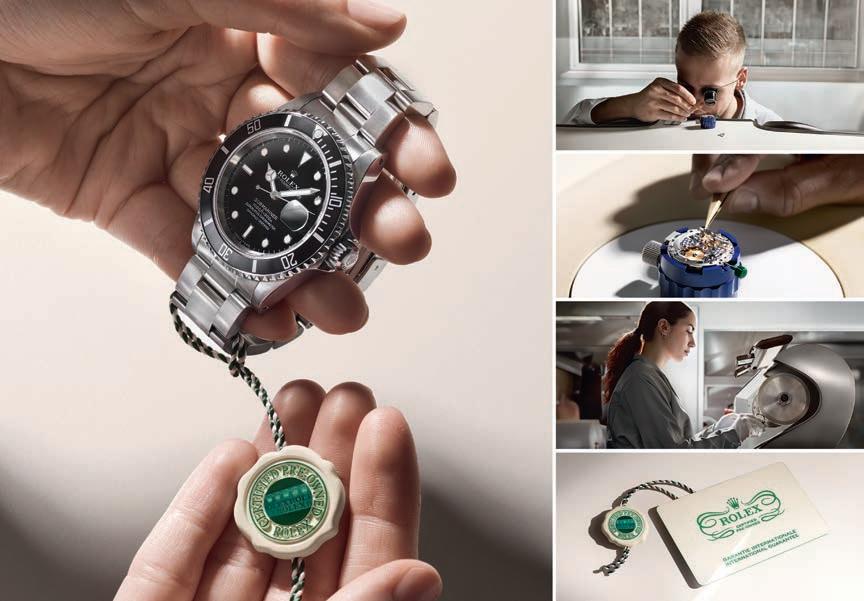






























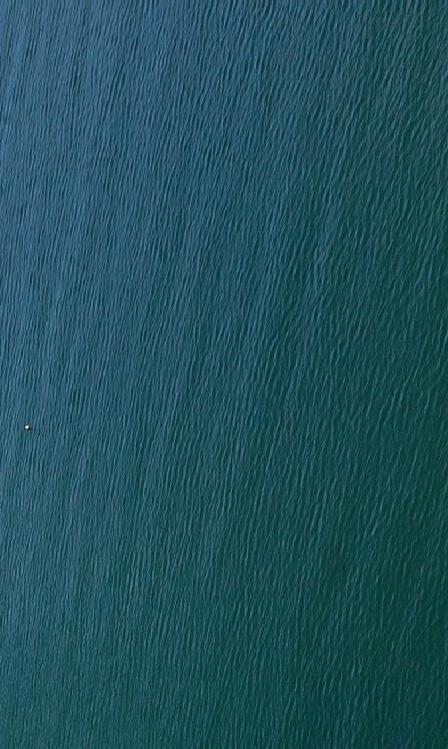















































1. the act of driving something along . the flow or the velocity of the current of a river or ocean stream
. to become driven or carried along, as by a current of water, wind, or air
. to move or float smoothly and effortlessly
We invite you to continue your lifestyle voyage online. Find inspiring stories and uncover more luxury content on nstagram dri corn all oin our clusi ournal communit at dri corn all co u to r c i r cip s, r i s and insid r no l dg o som o orn all s most lo d lu ur d stinations
A JOURNAL FOR THE DISCERNING dri ournal co u dri ournalu
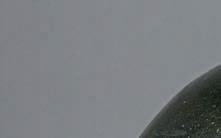

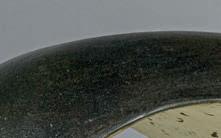
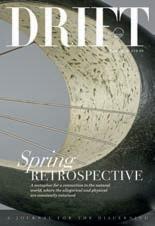

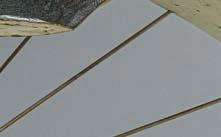

On the cover
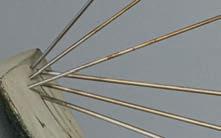
Barbara Hepworth, Curved form ave , cast . ourtesy of iano obile. rivate ollection, on loan to he epworth akefield. s featured from page .
piano-nobile.com



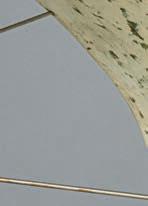

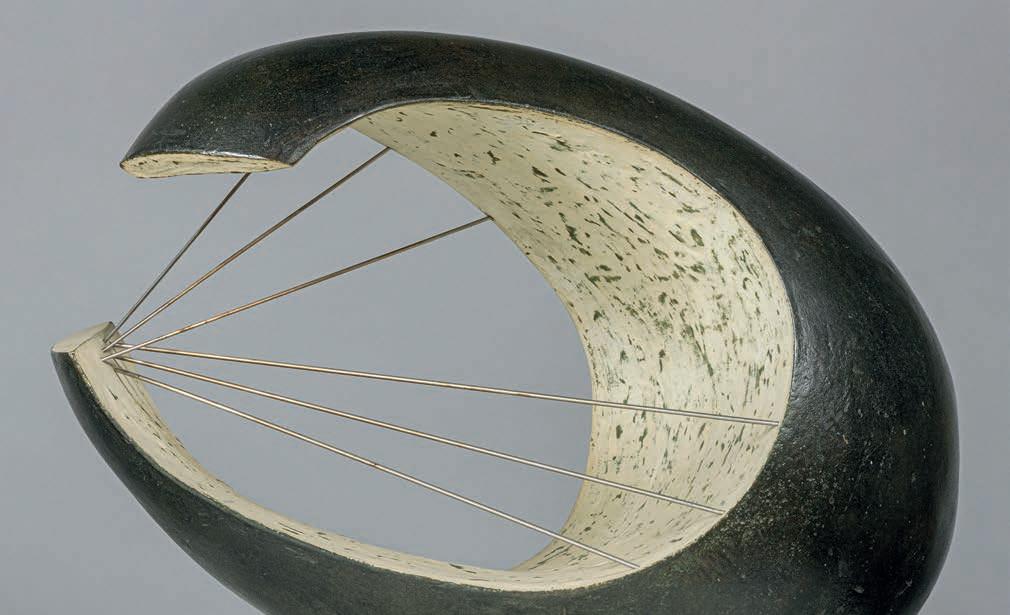
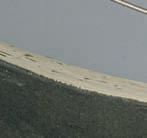
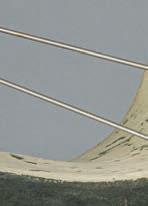
Head of Client Management es lover
des.glover@enginehousemedia.co.uk
CEO en ratchett ben.pratchett@enginehousemedia.co.uk
Chairman & Founder
ndy orster
andy.forster@enginehousemedia.co.uk

DRIFT is published by: Engine House Media LTD
Holbrook, The Moors, Porthleven, ornwall
www.enginehousemedia.co.uk
www.levenmediagroup.co.uk
Editor Hannah Tapping
hannah.tapping@enginehousemedia.co.uk
Creative Designers
Spencer Hawes amie rocker
Finance & HR Manager
Charlotte Forster
charlotte.forster@enginehousemedia.co.uk
Credit Control
racy art
tracy.dart@enginehousemedia.co.uk
ISSN 2632-9891
© All rights reserved. Material may not be re-produced without the permission of Engine House Media Ltd. While DRIFT will take every care to help readers with reports on properties and features, neither Engine House Media Ltd nor its contributors can accept any liability for reader dissatisfaction arising from editorial features, editorial or advertising featured in these pages. Engine House Media Ltd strongly advises viewing any property prior to purchasing or considerations over any financial decisions. ngine House Media reserves the right to accept or reject any article or material supplied for publication or to edit such material prior to publication. Engine House Media Ltd cannot take responsibility for loss or damage of supplied materials. The opinions expressed or advice given in the publication are the views of the individual authors and do not necessarily represent the views or policies of
Engine House Media Ltd. It is suggested that further advice is taken over any actions resulting from reading any part of this magazine.
Engine House Media Ltd is a multi-platform media business with a passion for everything Cornish. Visit www.enginehousemedia. co.uk to find out more. ur mission is to create -media opportunities marrying together consumers with the fabulous businesses across ornwall. ur publishing and marketing teams are specialists in creating print and online communications, devised to achieve a range of marketing objectives. With over 20 years of marketing, brand management and maga ine e perience we develop effective communications that deliver your message in a credible and creative way. We operate across all media channels, including: print, online and video.
The relationship between ourselves and nature is one of both intimacy and conflict. e can find ourselves existing between the human and the natural, between the fi ed and the fluid, between the story and the narrative. ur connection to the natural world is both instinctive and uneasy, shaped by cycles of belonging and separation. Stone is chiselled, clay moulded, metal cast; yet time and the elements alter even the most enduring forms. Art, like nature, is never static; it invites decay, weathering, and reinterpretation resisting conclusion. As each narrative unfolds it is shaped by perception, memory and time. Through words, images, and forms, we explore these tensions how we inhabit landscapes, how they inhabit us and how artistic practice is a process of navigation rather than arrival. Belinda Ireland’s rich memory and imagination define her works these unfiltered
visual memoirs serve as a record of the things observed over a lifetime. A landmark exhibition at Piano obile, Barbara Hepworth: Strings will bring together a significant group of arbara epworth s string works, drawn from public and private collections, including sculptures as well as drawings and paintings that continue the string motif. he landscape of ornwall influenced her fascination with this new concept, where strings became a metaphor for her connection to the natural world. For reya ennett , the sea became the foundation of her artistic expression. The act of creation, like the ocean itself is fluid and she thrives in that space between control and surrender. DRIFT Journal, too, exists in that space between. We invite you to wander with us, to dwell in uncertainty, and to consider what it means to create within an ever-changing world.
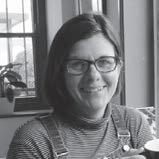
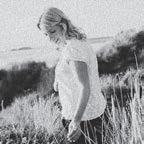
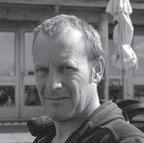



We have an exceptional and loyal team here at even edia roup but as a fast-growth business we’re always interested in talking to outstanding individuals. If you’re a superstar of extraordinary talent then we would love to hear from you. Proudly
Call us on 01326 574842 or email enquiries@enginehousemedia.co.uk Visit driftjournal.co.uk to read
Providing life changing opportunities for young people across the UK www.diveprojectcornwall.co.uk




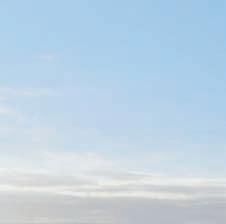
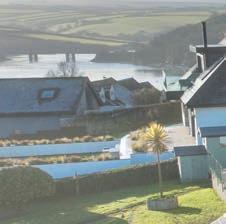

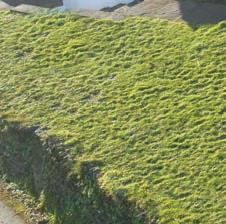


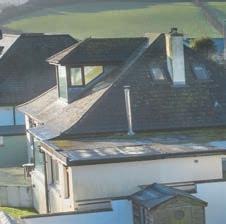
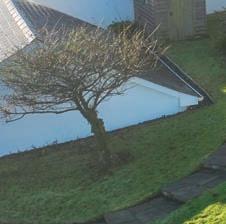
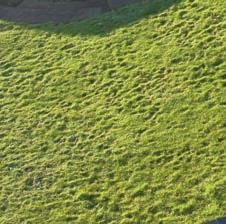

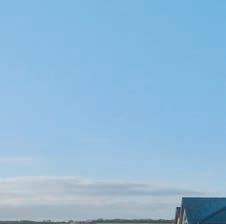
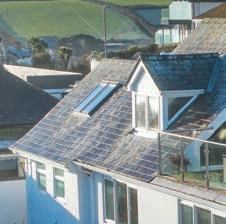

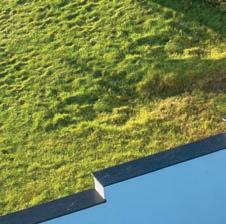


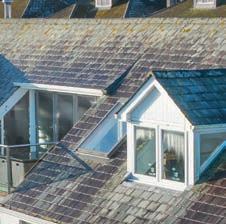

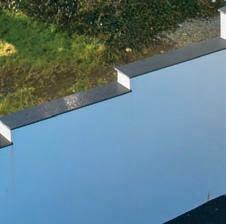



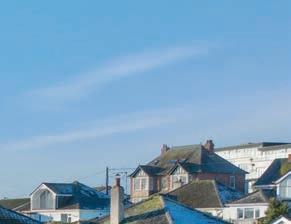

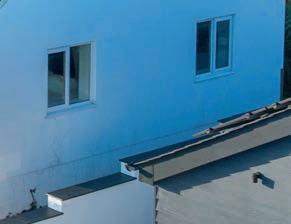


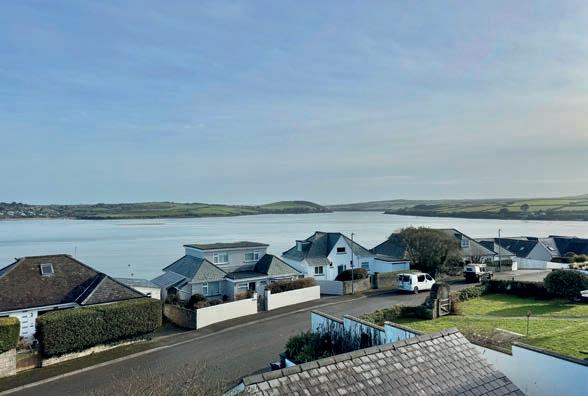

Substantial

detached house, with panoramic views of the Camel Estuary, in sought after residential area of Padstow
32 Treverbyn Road | Padstow | PL28 8DN | £2,100,000 guide
32 Treverbyn Road is a substantial five double bedroom detached family home located in a most enviable elevated position overlooking the Camel Estuary within the highly sought after historic and picturesque fishing village of Padstow. This waterside residence boasts a stunning backdrop with far reaching views of the estuary, the iron bridge and beyond.




PUGGIS FARM | RESKADINNICK | OIEO £795,000
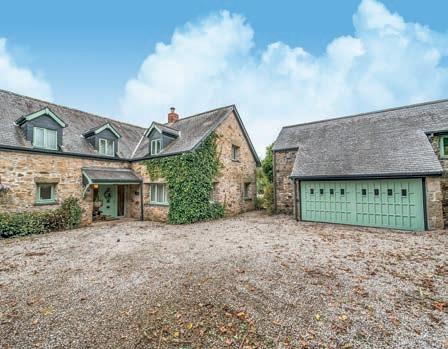
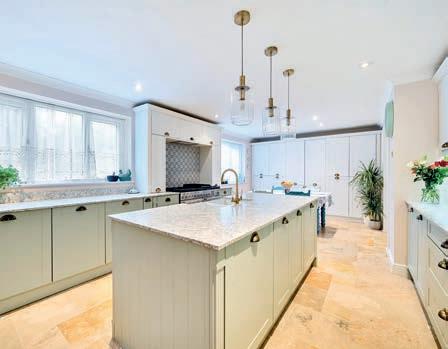
A SPACIOUS FIVE-BEDROOM DETACHED FAMILY HOME WITH ACCOMMODATION ARRANGED OVER TWO FLOORS, WITH A LARGE GARAGE AND ADDITIONAL STORE ROOM ABOVE, ALL SET WITHIN A SERENE RURAL SETTING.
UPLANDS | ST COLOMB MAJOR | OIEO £800,000


THIS DISTINGUISHED, ARCHITECT-DESIGNED, GENTLEMAN’S RESIDENCE, BUILT IN 1911, WAS ORIGINALLY COMMISSIONED FOR A RETIRED SEA CAPTAIN AND IS RICH IN PERIOD CHARACTER WITH SUBTLE NAUTICAL INFLUENCES.

GWALLON VEAN | MARAZION | £950,000

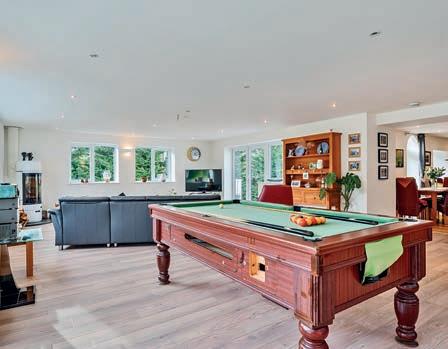
THIS SPACIOUS FIVE-BEDROOM HOME SET WITHIN BEAUTIFULLY LANDSCAPED GARDENS AND GROUNDS, COMPLETE WITH AN ATTACHED ONE-BEDROOM ANNEXE.
LONGCARROW HOUSE | NR PADSTOW | £840,000
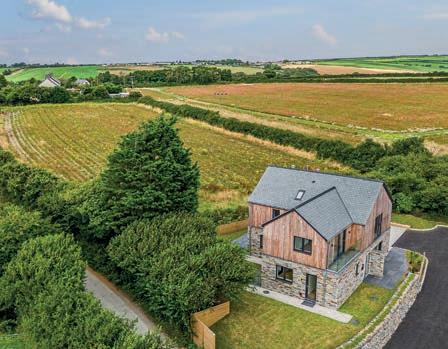
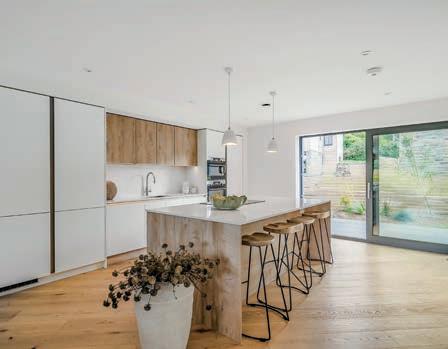
STUNNING, NEWLY BUILT CONTEMPORARY FOUR-BEDROOM HOME, FINISHED TO A HIGH STANDARD AND IDEALLY LOCATED JUST A SHORT DRIVE FROM PADSTOW AND ITS RENOWNED COASTLINE.
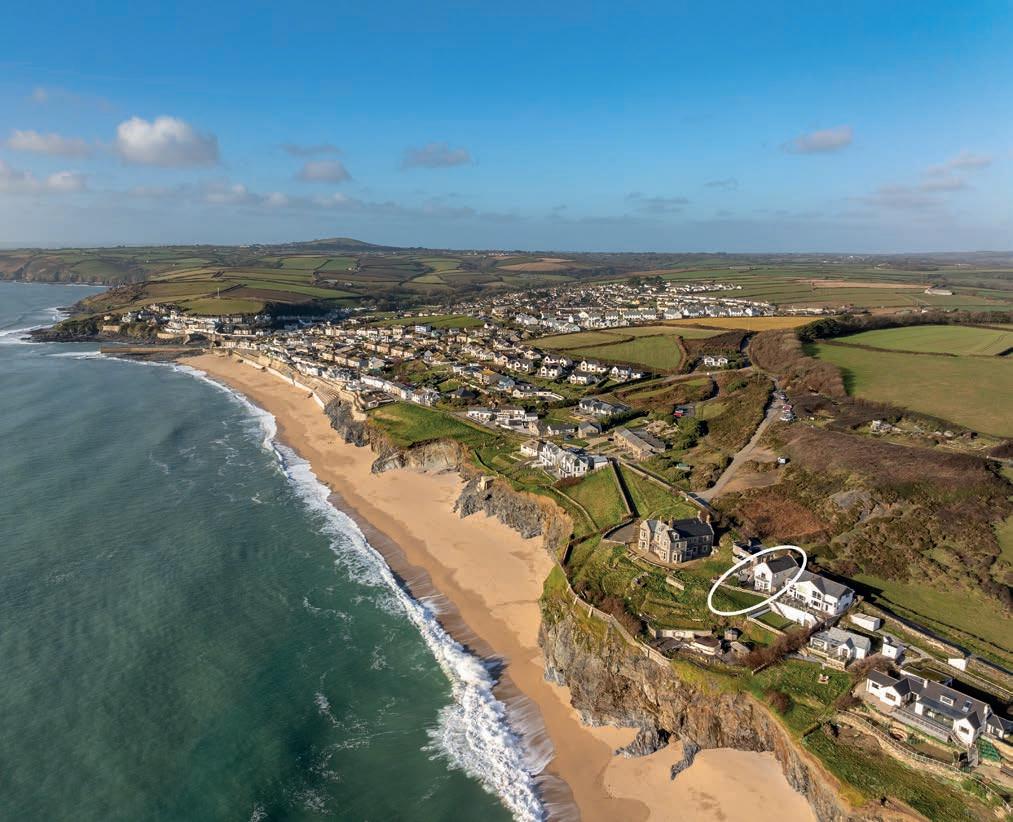
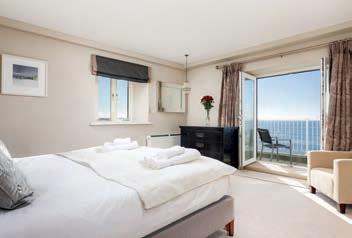
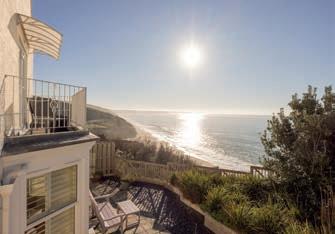


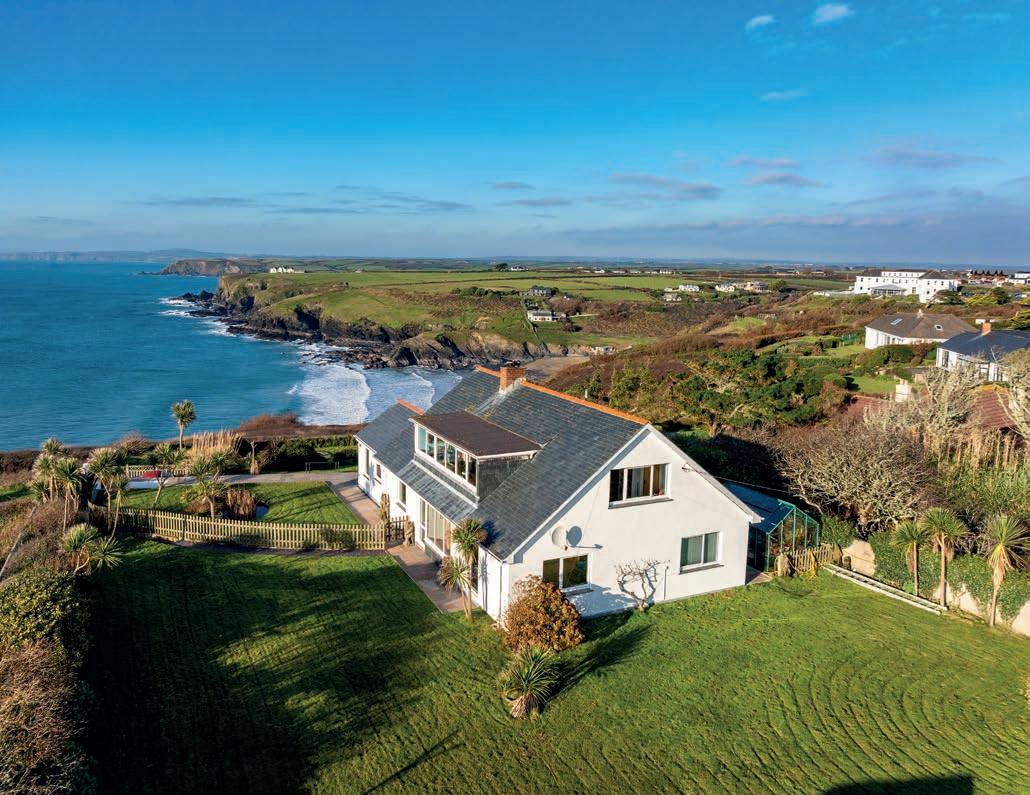

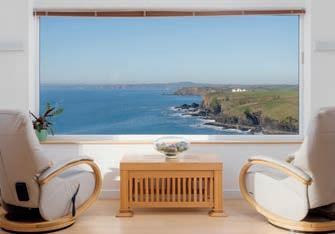
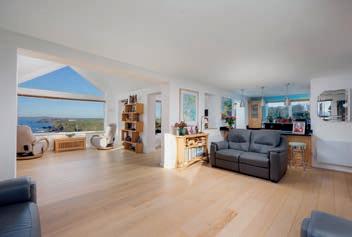

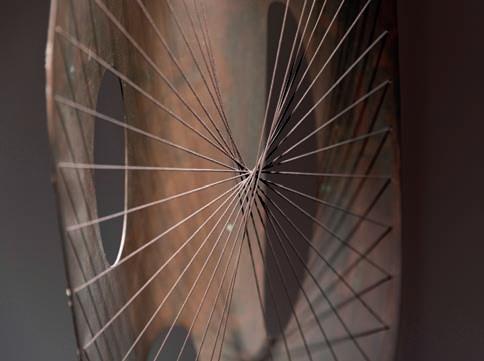

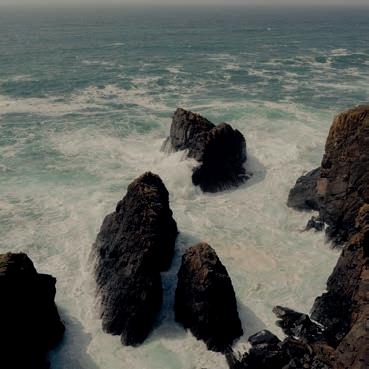
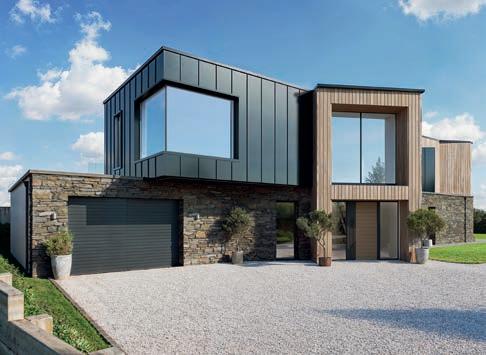
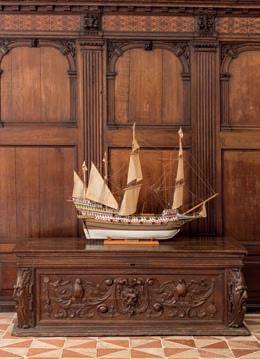
15 WORLDS INTERTWINED
Through the lens of
A COLOURFUL HISTORY
Belinda Ireland’s work explores the imagery of an imaginative childhood
SPRING RETROSPECTIVE
This year, London’s Piano Nobile will present a landmark event exploring the work of artist and sculptor, Barbara Hepworth
50 A STATE OF FLUX
Not far from the snaking coastline an artist’s or mirrorst and o o t s a
65 FISH FOR DINNER
Tasty and inspiring ways to cook seasonal andsustaina l fis rom at an utla
72 A SYNERGY OF SOULS
This is a tale of friendship, food and design that have melded to form Bolla
80 A COOL COMEBACK
A Grade-II listed cluster of historic buildings reimaged for the modern era
90 REVERENCE TO THE WILD
A new activity is set to cast its line as panegyrised in a new book – Wild Fishing
102 THE ULTIMATE TEST
Could you extend far beyond your comfort zone to discover your true self?
106 THREE SIMPLE WORDS
In an age of hyper-connectivity getting lost might seem like an anachronism
114 ECHOES OF BUCKLAND ABBEY
Eight centuries of history unfold within the walls of Buckland Abbey
122 EVENTIDE
The last word – by Greg Allen


Through the lens of Max Searl, whose photographic narratives explore the relationship between people and place.
Max Searl is a documentary and editorial photographer based in Falmouth, working both nationally and internationally. His work focuses around people and place, believing the two are deeply intertwined, documenting both humans and the environments they inhabit, manipulate and construct. Through people, stories are created, environments altered, narratives woven and culture embedded into a landscape. He views the people he encounters, in both his commercial and personal work, as key to his success in photography.
Graduating from Press and Editorial Photography at Falmouth University in 2019, Max has been working as a freelance photographer since 2023, working commercially for both local and international clients.
commercial projects range from editorial commissions, events, product and lifestyle, shooting for a varied array of clients.
His most recent body of work, Selected Mine Works, documents four different sites across Cornwall. The project aims to shed light on the concealed relics of the mining past, photographing the often-unseen adits and shafts that are often no more than a distant memory. The project was collated and published by Orange Press, based in Edinburgh, and was launched in London at Photobook Café, alongside a group exhibition on Cornish mining.
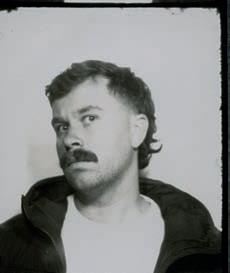
Max exhibits across the UK. He has published four zines as well as featuring in a further three. A wider range of imagery can be viewed on his website where Selected Mine Works is also available to order via Orange Press (orangepress. bigcartel.com).
His work has featured in The Telegraph Magazine and Huck Magazine, while his
maxsearl.com
Rinsey, 2019



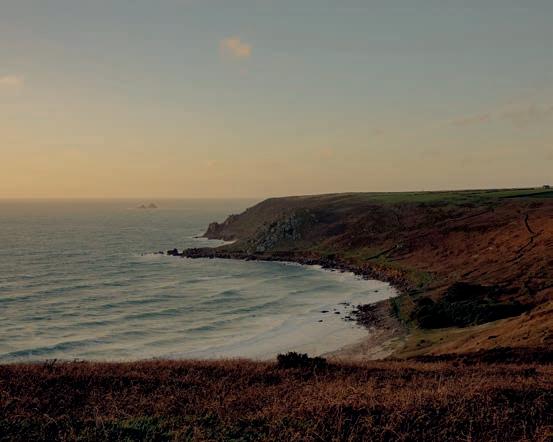
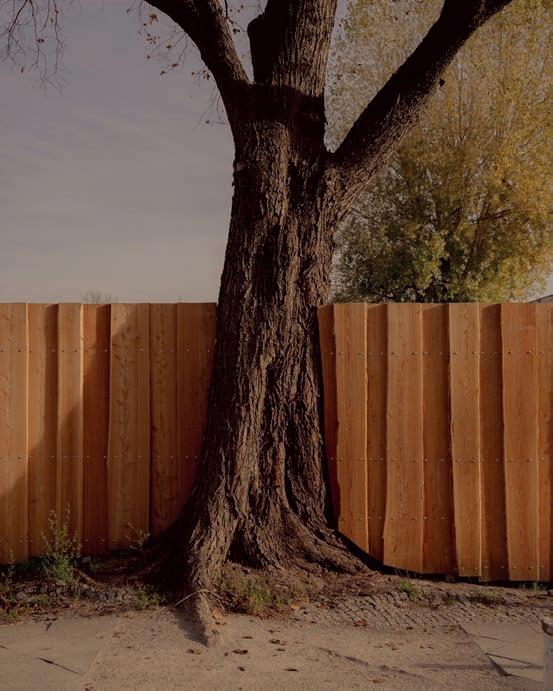

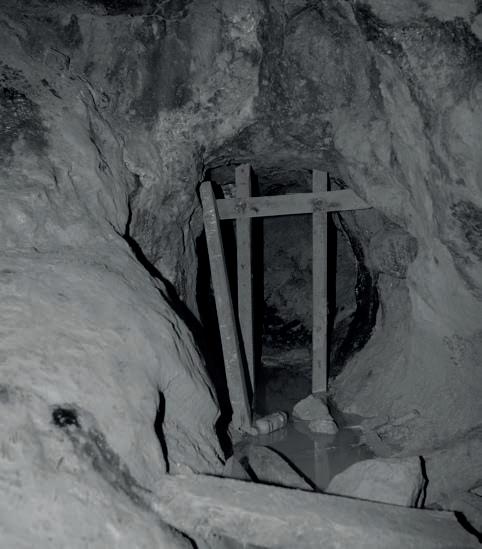
TOP & ABOVE From Selected Mine Works, 2023
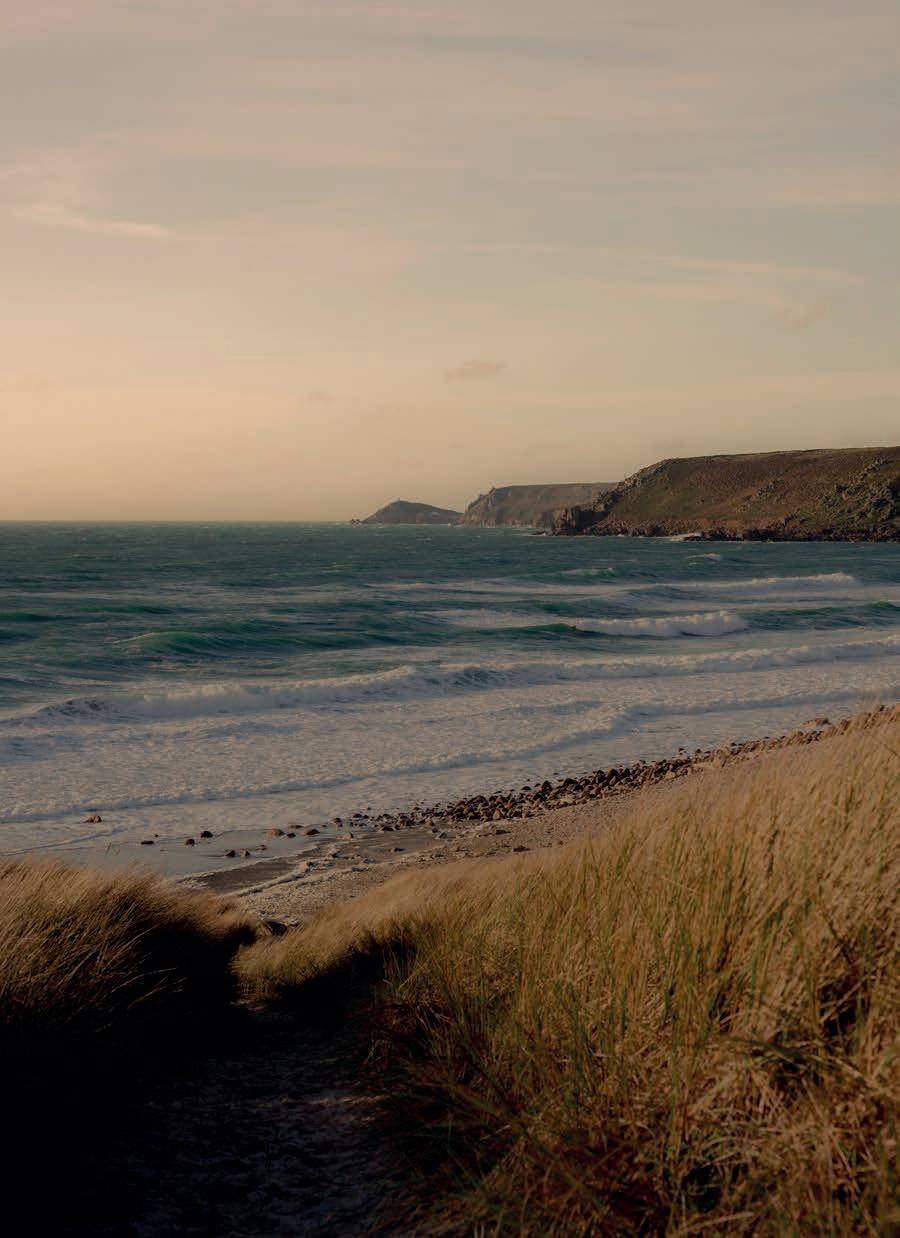

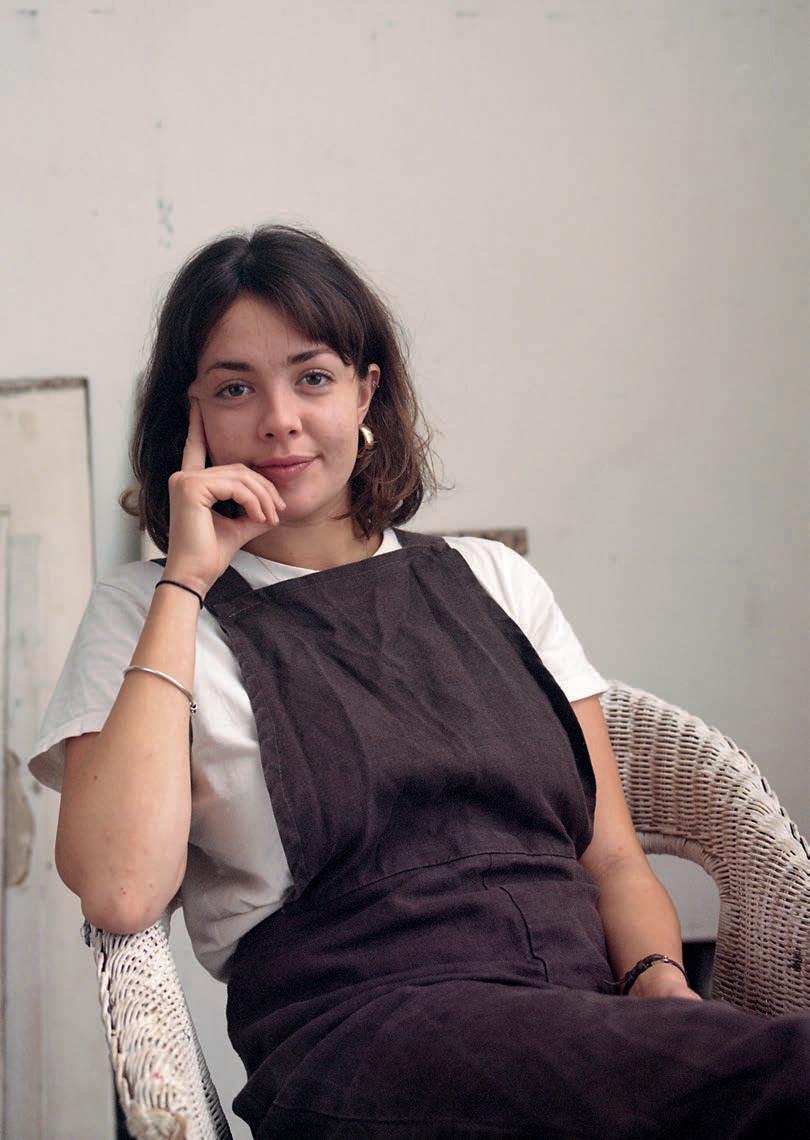
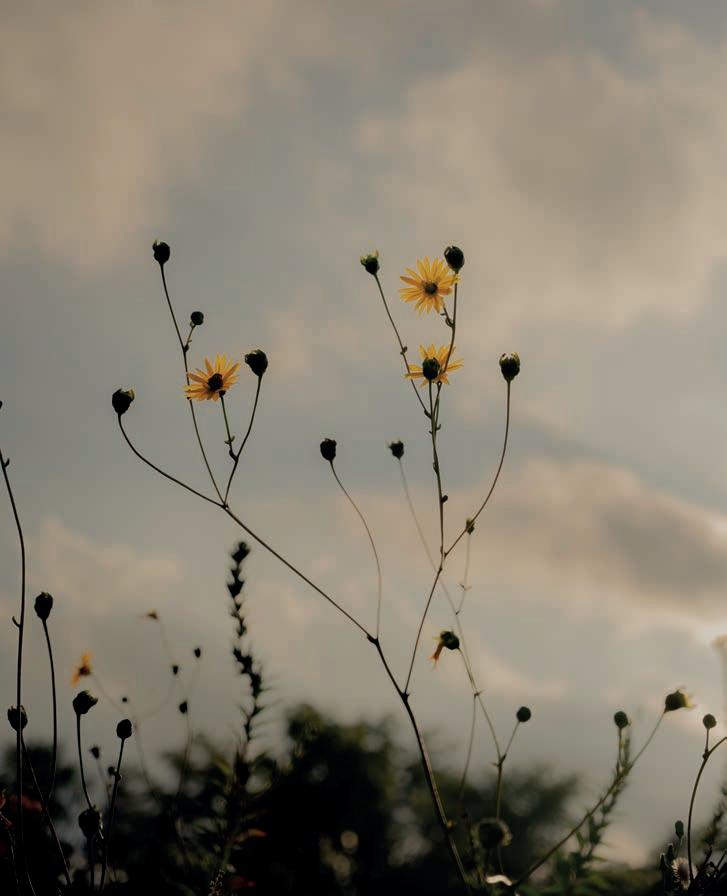
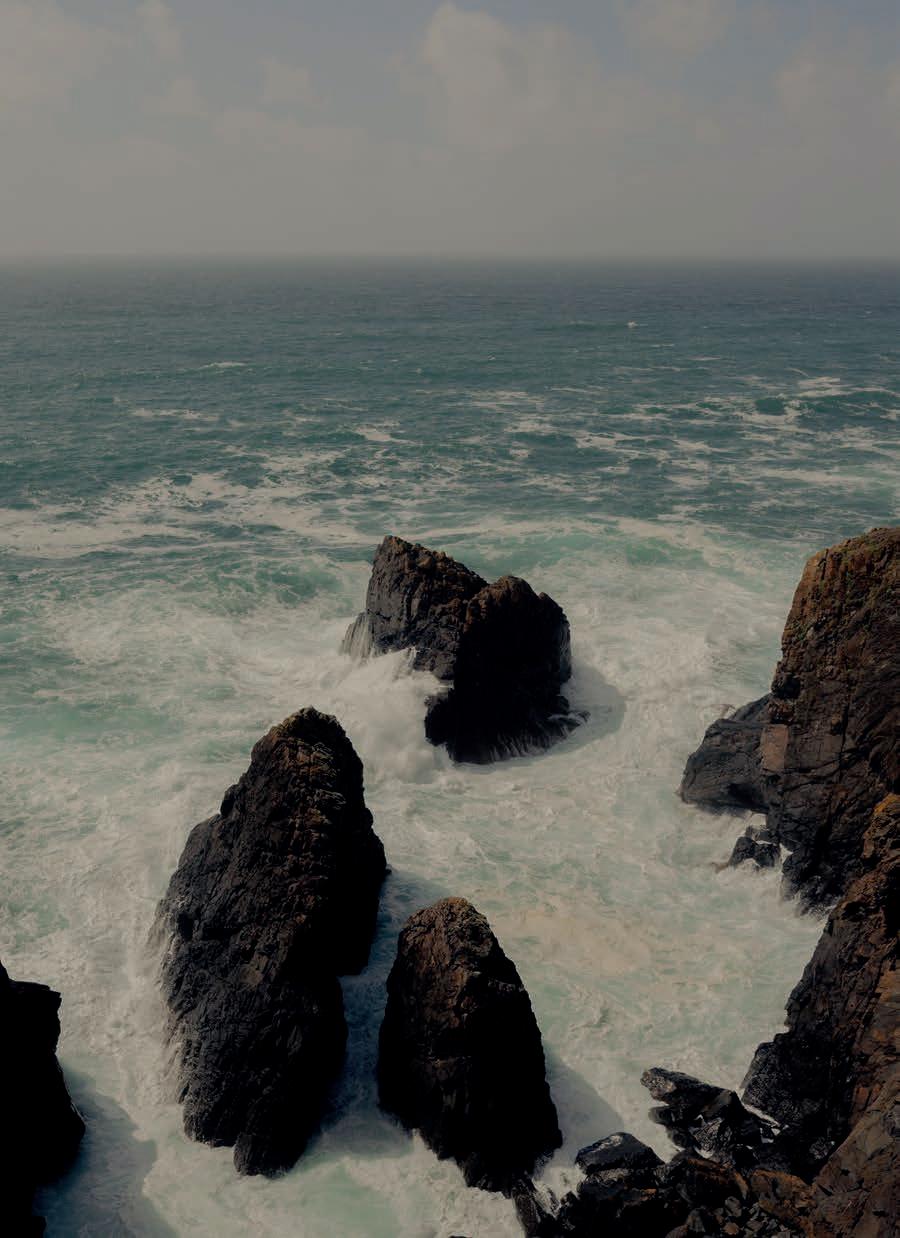
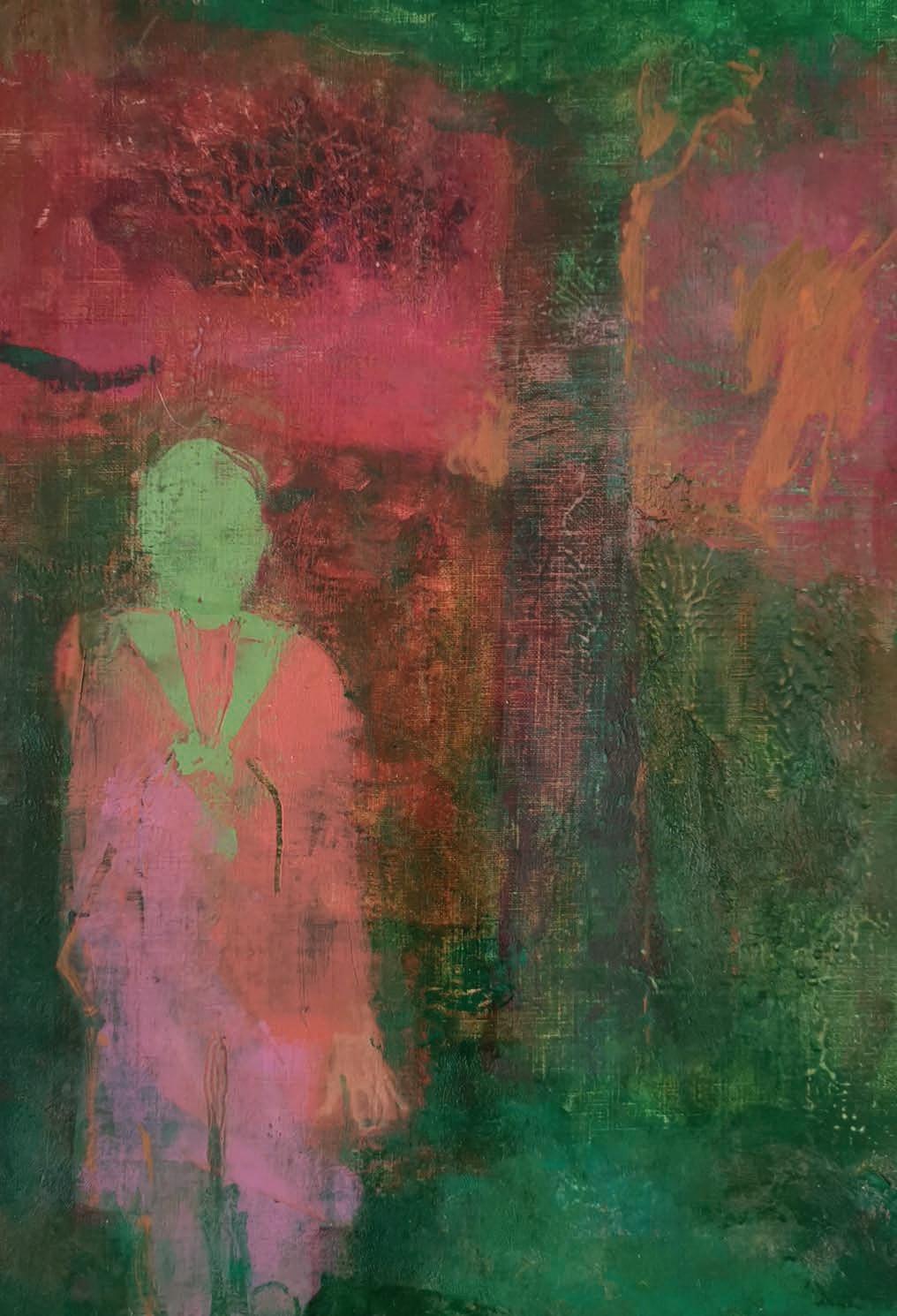
WORDS BY MERCEDES SMITH
Belinda Ireland’s work explores the imagery of an imaginative childhood.
Idon t know about you, but find that most people struggle to be frank about their personal histories. include myself in that category. wouldn t dream of sharing the intimacies of my childhood, or my teenage years, with anyone but my closest friends. n the arts though, unfiltered sharing is essential. istory s most important literature, lyrics and painting come from the artist s decision to share their human e perience in full think of ane usten, ernie aupin and ark othko, whose works have always resonated with the masses.
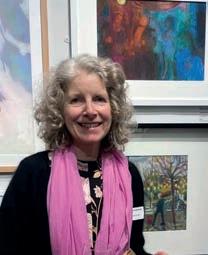
elinda reland is an artist with that same frankness of e pression. er work, rendered in oil, pastel, or charcoal, is inspired by the vivid imaginary worlds she retreated to during childhood, where longings and
fears mi ed with the inspirational stories, symbols and icons of late th century culture. ombining personal memory with imagery from films, maga ines and television, she builds curious, colourful scenes that reveal the depth of her inner life, and reflect changing attitudes to gender, race and relationships through her playful presentations of pop culture past. y work is autobiographical in a sense, says elinda. suppose it does all start with me and how saw the world back then. ut as you age you see older things through a contemporary filter, and contemporary things through an older filter. hose are the ideas that e plore in my work. y starting point will often come from a single second in time. might glimpse a telling moment between two people in the street, or see

ABOVE nwelcome ews
something on that triggers a childhood memory. especially love old movies and maga ines from the s and s. hey can be full of adverts and imagery which seems startlingly outdated now the moustachioed alpha male with his pipe and his whiskey glass the housewife thrilling at a sink full of soap suds that famous poster from the s, of a tennis player with her skirt hitched up in a revealing way. have a dry sense of humour, so find those images amusing and that shows up in my work.
s well as pop culture, elinda responds to the traditions of art history in her imagery, and to genre painting in particular. have always been fascinated by the way a painting can be grotes uely romantic, she says. hose things will inspire me, in a tongue-in-cheek way. s a child of the s, see endless parallels with my own life in elinda s work. he has a rich memory and imagination, and in sharing it, reminds me of the wonder and oy of my own youth. e discuss our childhoods - the now politically incorrect programmes, the classic pre-woke toys, and the bewildering romantic tensions of our teens. n that shared e perience, her drawings and paintings say something about all of us born in the pre- k era, and since. hey are dark, oyful or comical notes on visual culture and our changing social perceptions. hey
also address the precious and terrifying innocence of youth. ften, elinda places herself within the work, a young participant in the romance of a fantasy world. t other times she is absent, the off-set director of a highly curated, dreamlike scene. eginning each work is very much like being a film director, she says. start with drawings and cut outs and arrange them like characters on a stage. s paint, the scene can change though. t s a fluid and unpredictable process.
n their creation, and in their final form, elinda s works are open ended, e ploring narratives rather than stories, because stories have a definite ending she says. s it wisdom, ask, that these artworks present t could be, she concedes, because there comes a time when you ve seen more, so you notice more. ut am certainly not interested in conveying a moral or political message in my work. often ask myself whether should be making a point about something, but don t really want to. am simply presenting an idea, and reference my own childhood and adolescence because that s what know best. don t always see what the cultural reflections might be, but my work prompts memories and associations in other people, and that s what s important. his authenticity is what differentiates mundane from truly

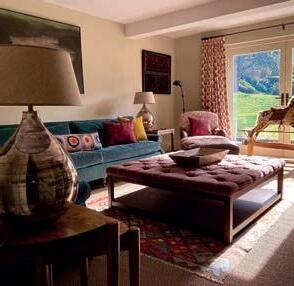

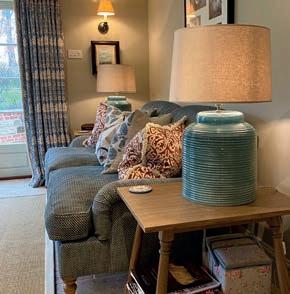
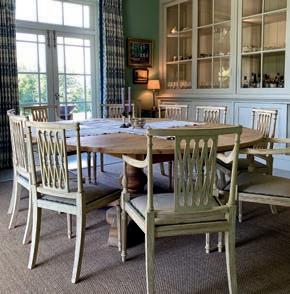
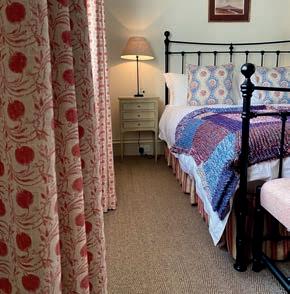

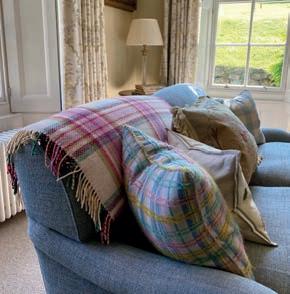
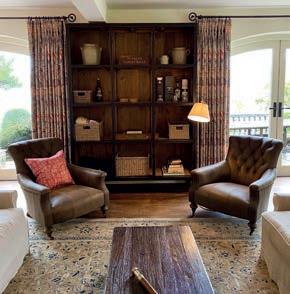

meaningful work. In art as in life, if you can overcome the fear of judgement and express yourself openly, it moves people.
Your work becomes life affirming stuff.
“I felt ambivalent about my practice for a long time, until I started drawing on ideas that were really personal,” says Belinda.
“When my daughters were growing, for example, I began to see the way girls are sexualised in society, and as an artist I found that fascinating. That’s when I started to explore the hidden meaning behind people’s behaviours and the way we interact.”
Structurally, Belinda’s works are complex. Her use of light is drawn from both 17th century painting and 20th century cinematography, and her approach to
colour flattens the image into a kind of photo negative, a cats-eye of shifting visual information. The haze of colour in each work adds greatly to its ambiguity and allure. I consider this in the context of Laid Back on The Brink, a Gauguin style surfmovie scene that draws my eye amongst the cowboys, circus acts and period drama detailing of her other works. The more I look, the more immersed I become. “I like to play around with colour and shape in an abstracted way,” says Belinda, “especially with my pastel works, so that it draws your eye but doesn’t necessarily link to the image. I use colour to guide a viewer into and around the work. It’s a real battle when I am painting, to be abstract and not figurative with colour, and to emphasise
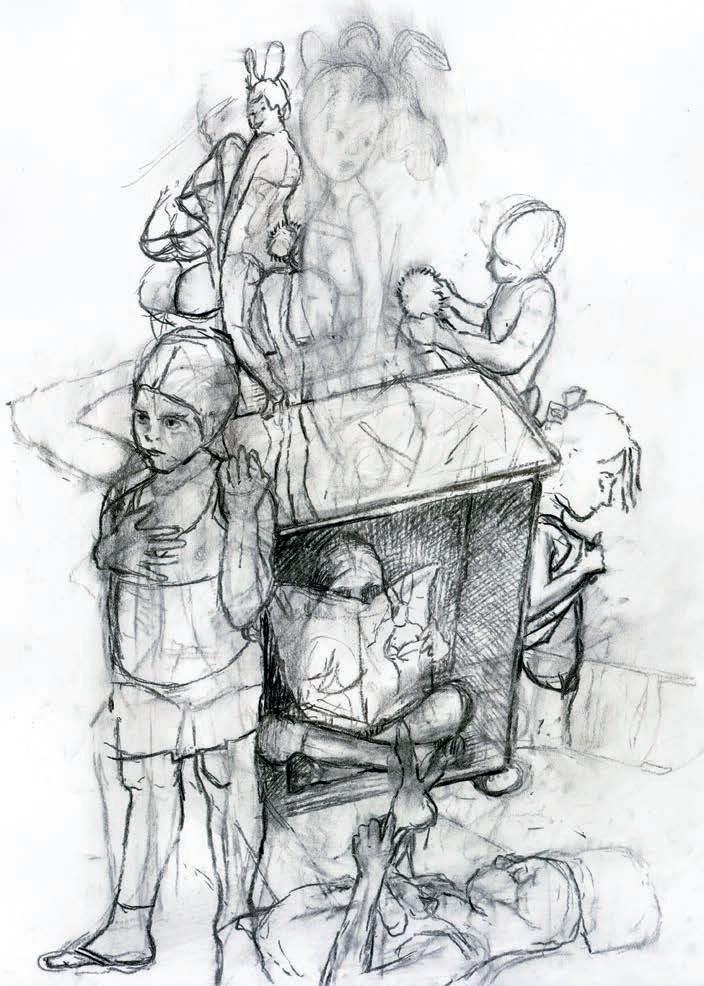
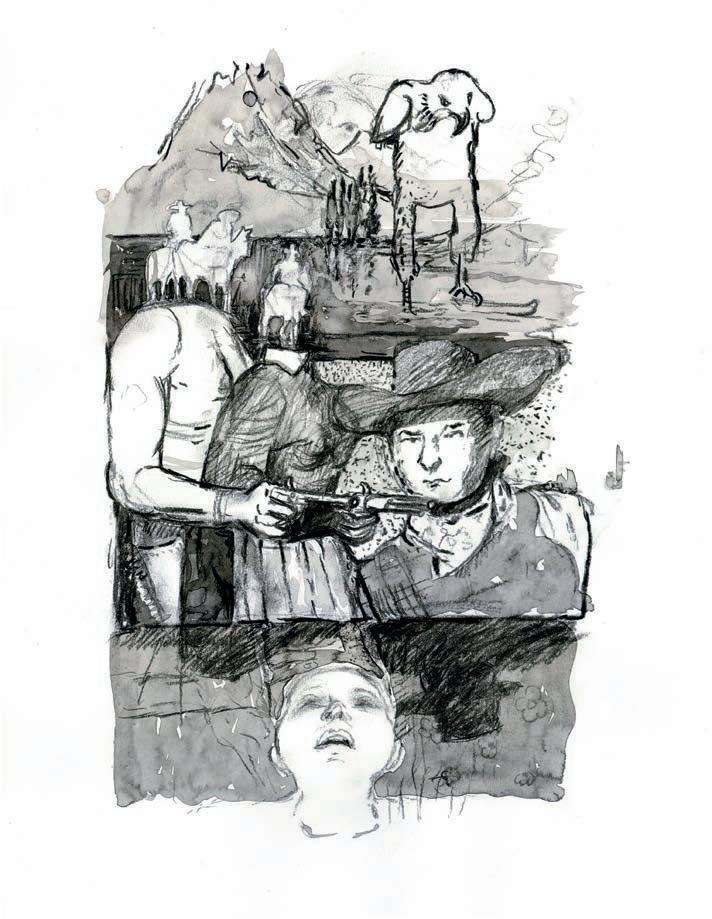
ABOVE Dreams and Imagination


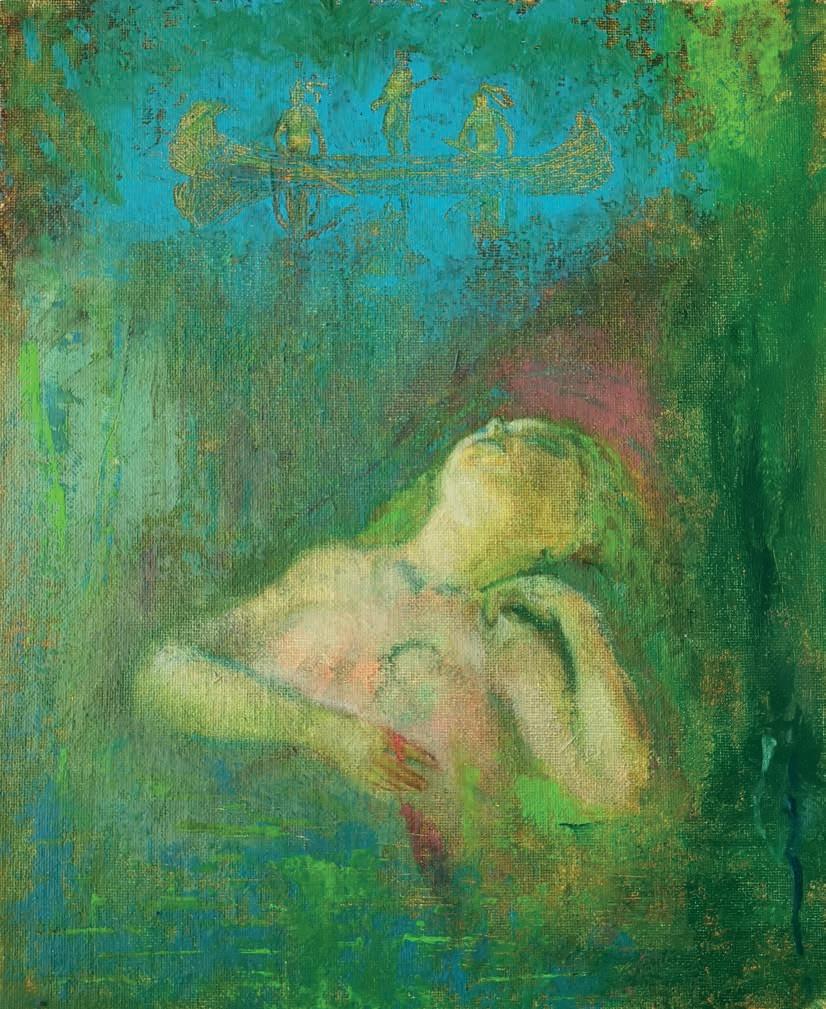
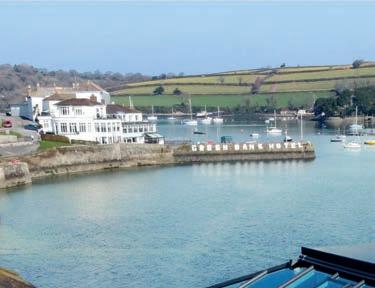
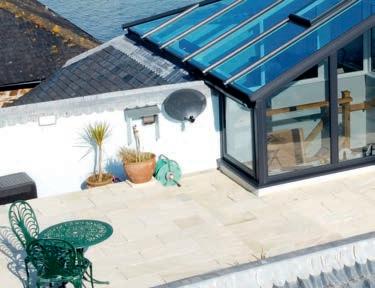
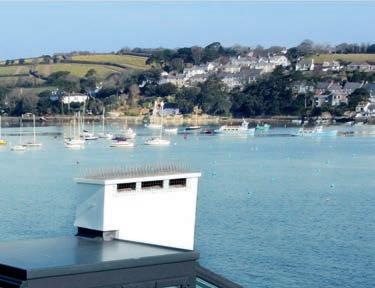
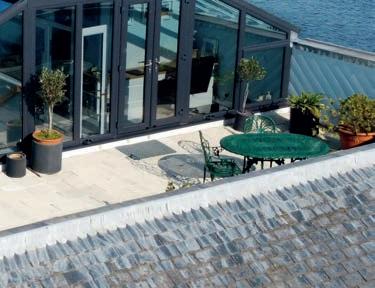



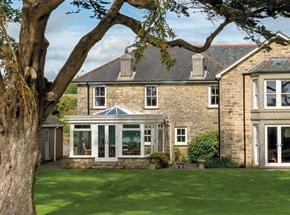
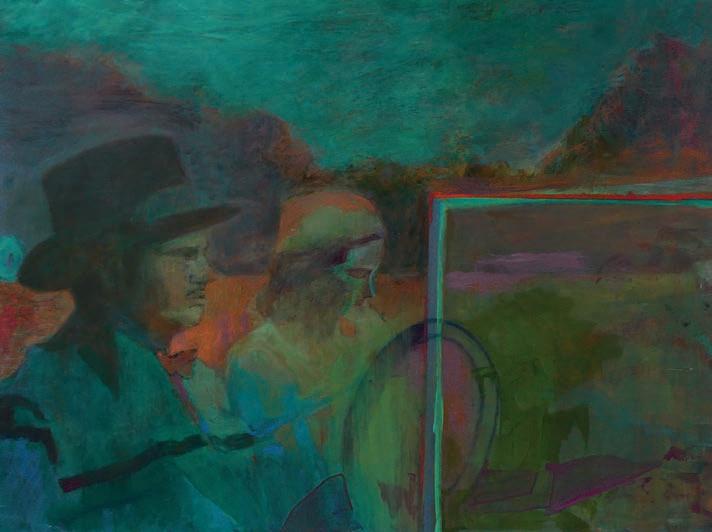
shape. I am aware that people have to work quite hard when they look at my work, because the colour can be monochromatic, it can be very close in value, and I like that interplay of subtlety.”
Any references to societal judgement, discrimination or outdated perceptions are equally subtle. Put simply, these works are an unfiltered visual memoir, a record of the things that have passed through Belinda’s retina in her lifetime. “Should the work be
deliberately deep?” asks Belinda. “I think if my meaning became too intense, that might kill it. Viewers must be free to react positively or negatively to my work, depending on their individual experiences and point of view.” To artists, a negative response is as valuable as a positive response. That’s what art is for, to trigger debate and conversation, and to connect us in our shared experience of being.
belindairelandart.co.uk


TThis year, London’s Piano Nobile will present a landmark event exploring the work of one of the 20th century’s most significant artists and sculptors, Barbara Hepworth.
he exhibition, Barbara Hepworth: Strings will bring together a significant group of arbara epworth s (1903–1975) string works, drawn from public and private collections, including sculptures as well as drawings and paintings that continue the string motif.
n the th anniversary of the artist s death, the e hibition will include several works that have not been shown to the public for over half a century, as well as sculpture that has never been e hibited before.


across the and beyond. his e hibition comes at a time in which interest in her work continues to grow, and her legacy as one of the most important artists in the th century is becoming assured. ate ritain staged a ma or retrospective in 2015, and in 2020 she was honoured with a blue pla ue outside her former ondon home.


towering influence on modern sculpture, epworth s biomorphic abstract works can be seen in public parks and galleries
epworth began making sculptures in a variety of materials that incorporated strings in 1939 and continued the practice throughout her career until her death. er non-figurative paintings and drawings also used string motifs, and the e hibition will create a dialogue between these two-dimensional works and her stringed sculptures.
PREVIOUS
nstallation photograph of arbara epworth, a uette for inged figure, at iano obile
INSET epworth in the studio with urved form elphi , , photographed by harles impel. ourtesy owness


nstallation
he stringed sculptures began soon after she arrived in t ves, which would become her home for the rest of her life and where the eponymous arbara epworth useum and culpture arden is now located. he landscape of ornwall influenced her fascination with this new concept, where strings became a metaphor for her connection to the natural world. s she noted, the strings were the tension felt between myself and the sea, the wind or the hills .
n sculpture, the strings often bridge wave-like arms to enclose interiors, or twist through voids of space. hey have a rhythmic and musical uality, in which the allegorical and physical are constantly entwined, e emplified in works such as Curved form (Wave II) .
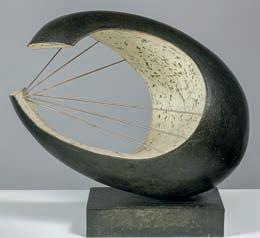
he wide range of works on display will showcase how epworth s strings are imbued with a multitude of references and interpretations. series of works entitled rpheus elicits myths of the reek musician s lyre and its deep connection to nature, and the first in the series, Theme on electronics (Orpheus) , will be e hibited to the public for the first time. ommissioned by the electronics company ullard, the work is a cold-rolled brass sculpture that provided the stimulus for the rpheus series which would continue for the ne t three years. his was an important touchstone in epworth s career as she moved from stone and wood to bron e and brass.
epworth worked strings into both small and large-scale works. he e hibition will include the uni ue work Small stone with black strings which is the only stringed work that epworth made using stone. ery small and delicate, the hand-si ed work carved from alabaster measures cm across. y contrast Winged Figure was a monumental work, commissioned for ohn ewis s flagship store on ford treet, featuring strings bursting out from the centre, attaching the bladed wings together, and guiding the eye around the sculpture. Maquette for Winged Figure which uses sheet metal and rods, and was the original proposal that ohn ewis accepted, will be on display.
epworth s talent took her around the world, and she met many other great artists of the day and e perimented with different techni ues. enry oore was a contemporary at the eeds chool of rt, and she learnt to carve in ome following a est iding ravel cholarship. ater she would travel to aris, where string first emerged as a sculptural device, to see the studios of ean rp and icasso . hen in t ves, she witnessed aum abo s spiral motif e periments. owever, only epworth would use string to suggest organic forms and natural rhythms, e ploring new territory in modernist sculpture. his e hibition will be an e citing and focused look at an artist who influenced
arbara epworth, urved form ave , cast . ourtesy of iano obile. rivate ollection, on loan to he epworth akefield
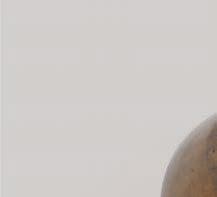
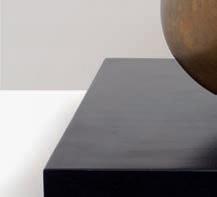
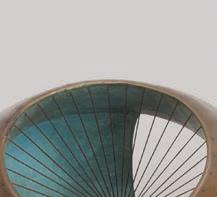

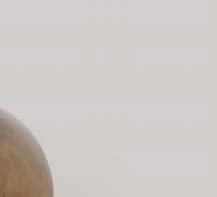
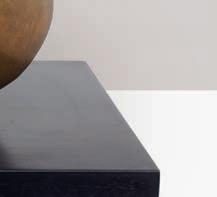
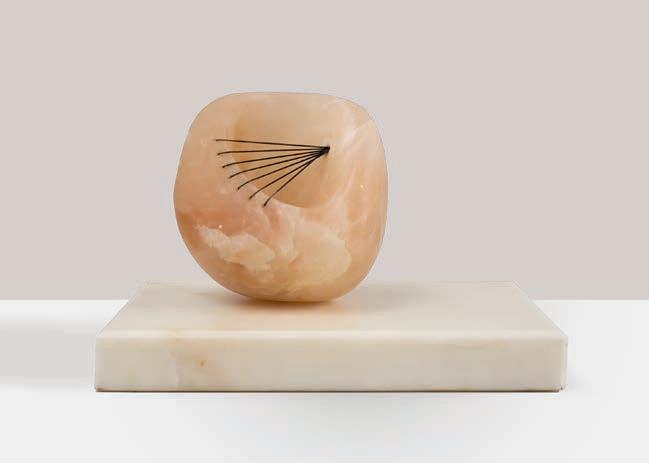
ABOVE
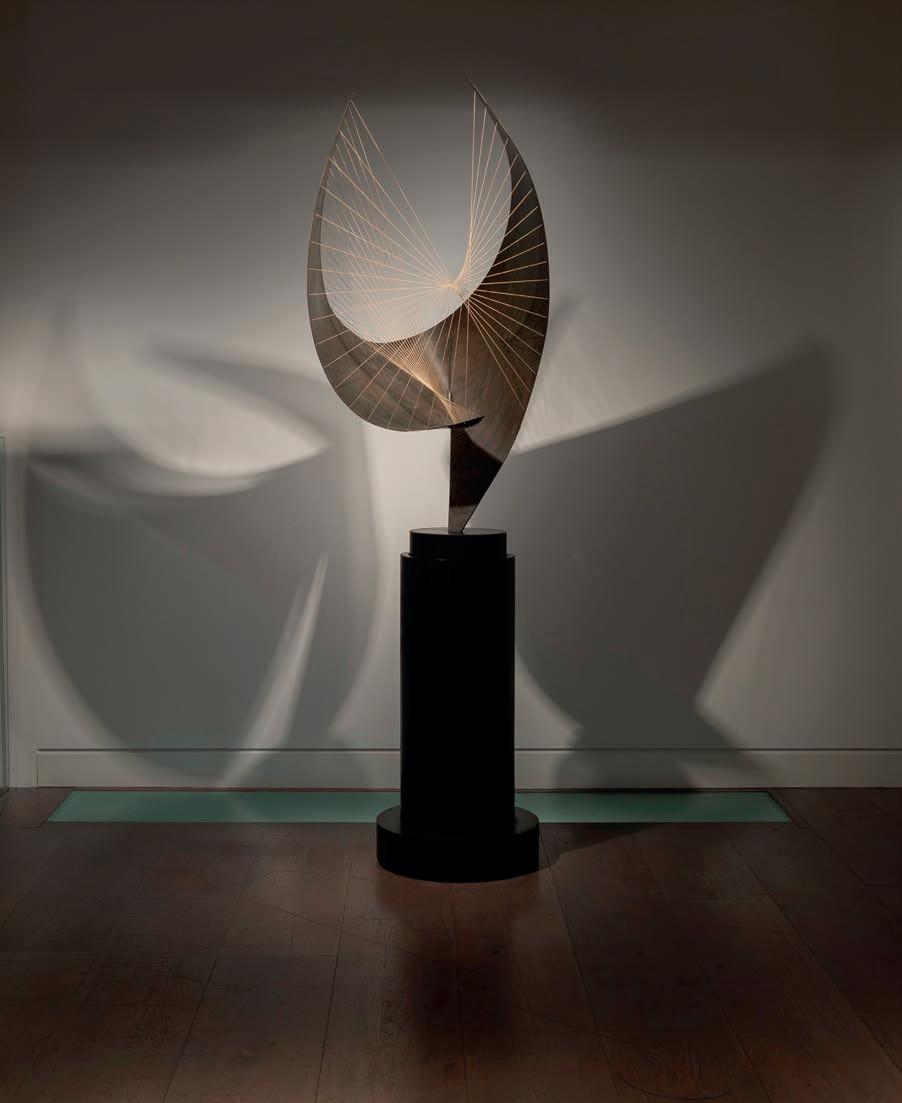
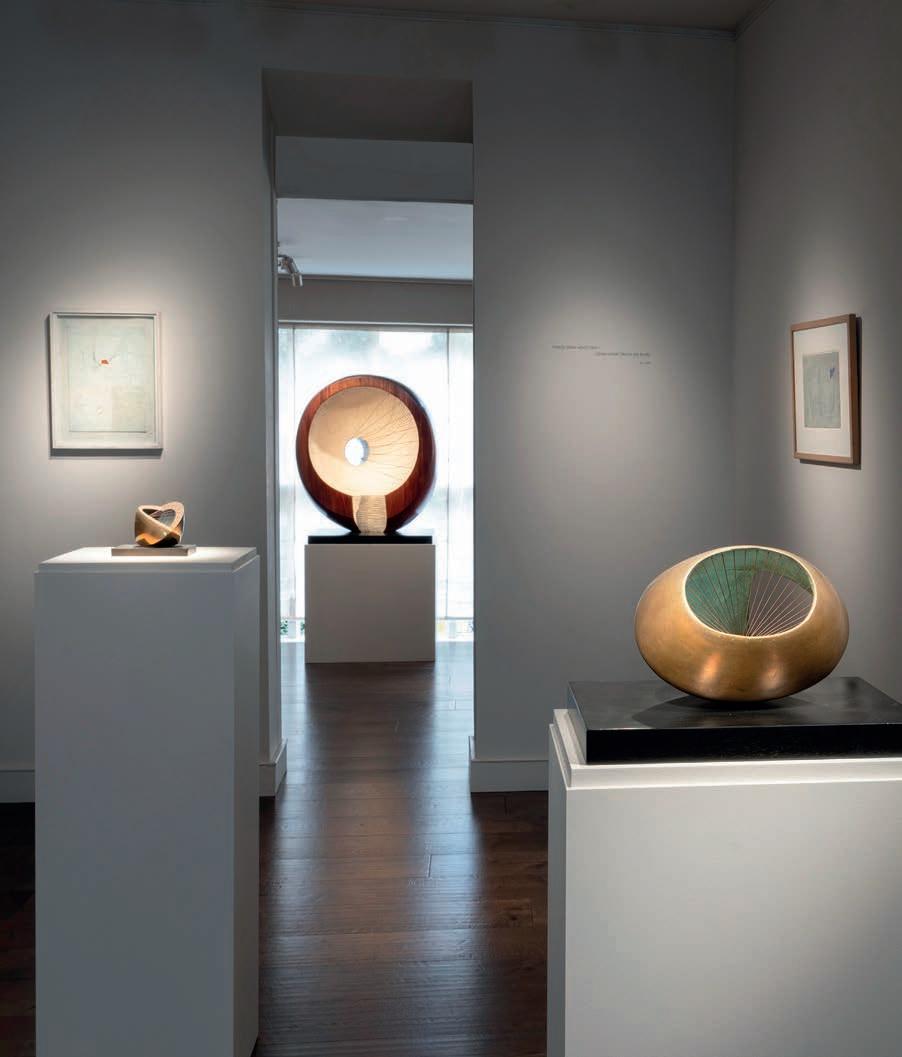
ABOVE & FACING PAGE
nstallation
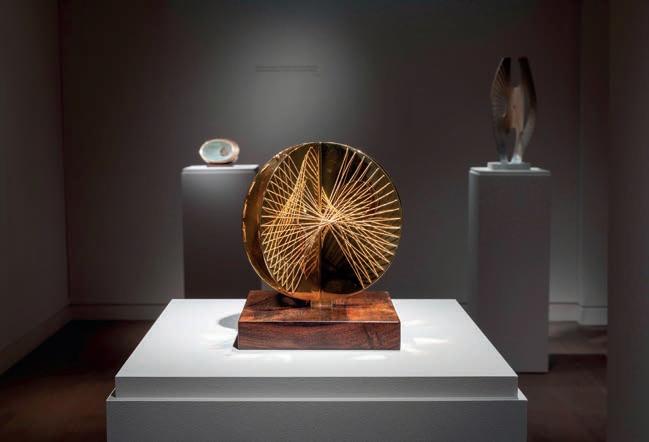

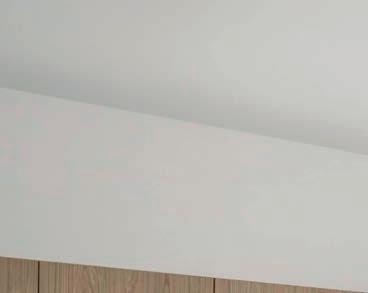

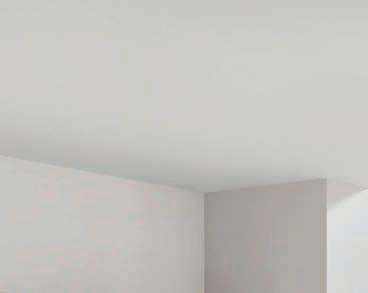
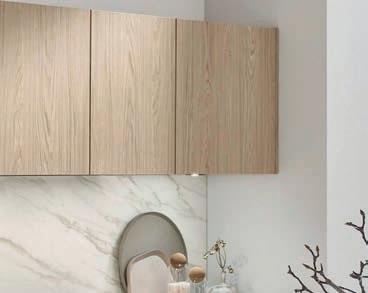
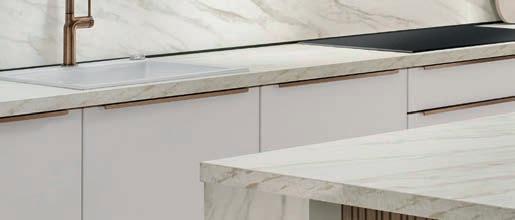
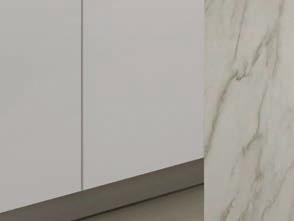
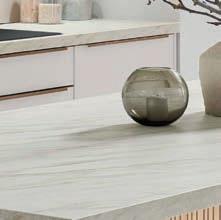

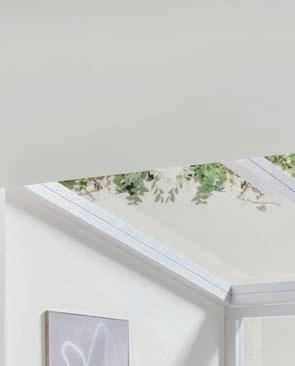
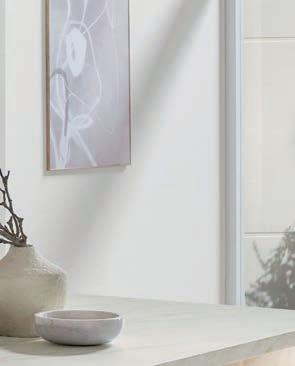

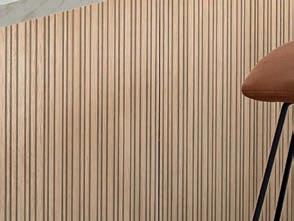


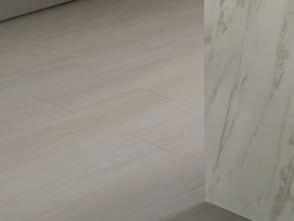



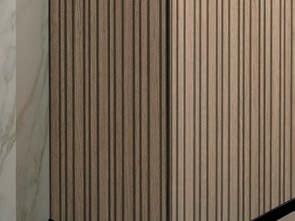
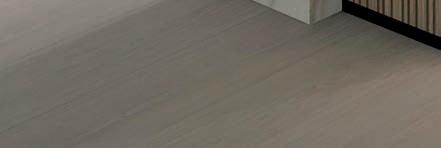


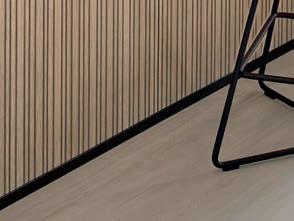






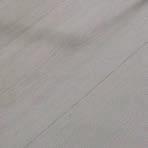

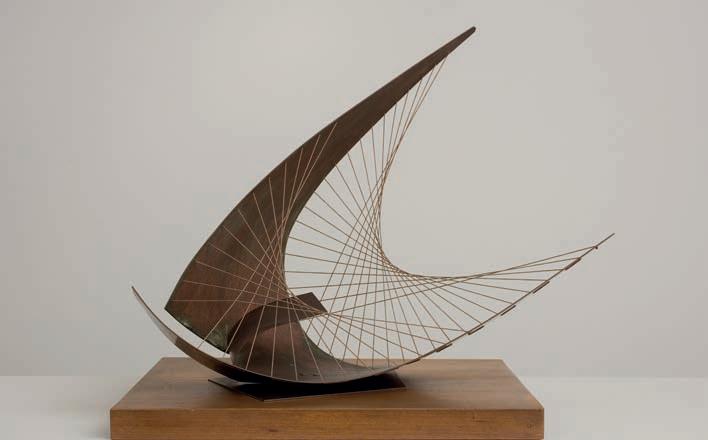
the landscape of modernist art in the 20th century and continues to inspire and provoke today. It continues Piano Nobile’s recent exploration of important British artists, including a recent, critically acclaimed exhibition on Hepworth’s second husband, the artist Ben Nicholson (1894–1982).
Curator Michael Regan said: “Hepworth is known to us today for her adventurous use of metal and rock to break down the boundaries between space and mass, giving the same value to both. Equally, as this exhibition will show, she used strings to create in her sculptures the tension between light and darkness, presence and absence, solidity and weightlessness. Most importantly, they symbolised the interconnectivity between the human figure and the landscape in a real, physical sense.”
A fully illustrated publication on Hepworth’s string works and their
historical context will also accompany the exhibition. It will include contributions from the curator as well as other leading and emerging authorities on Hepworth’s work. Full details will be released shortly. Piano Nobile is a leading specialist in 20th-century British art. The gallery has established a reputation for authoritative exhibitions and accompanying publications under the gallery’s imprint Piano Nobile Publications.
Barbara Hepworth: Strings at Piano Nobile is on from 6th February to the 2nd May 2025 at Piano Nobile, 96 / 129 Portland Road, London W11 4LW. Exhibition visiting hours are Tuesday to Friday 10am-5pm and Saturday 11am4pm, closed Sunday and Monday.
All works © Bowness / courtesy of Piano Nobile, London.
piano-nobile.com
ABOVE
Barbara Hepworth, Stringed figure (Curlew) (Version I), 1956. On loan courtesy of Sammlung Pohl, Marburg

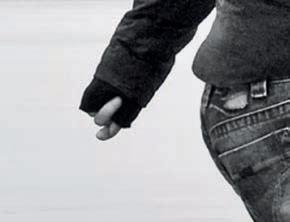

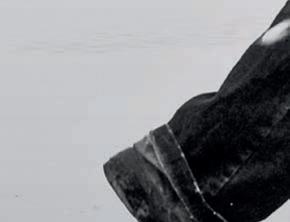

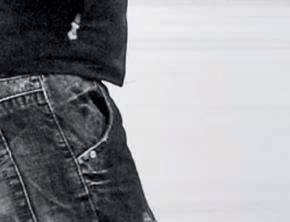

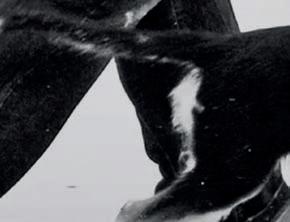
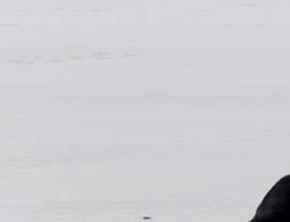
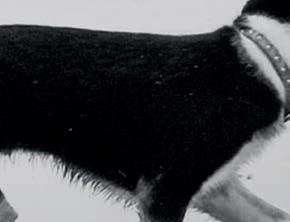
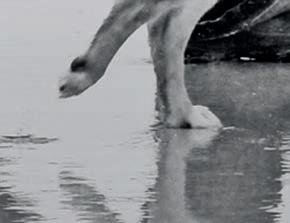
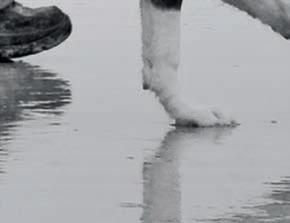




Not far from where the snaking coastline meets the churning Atlantic, resides an artist whose journey mirrors t and o o t s a
Dreya Bennett, a name synonymous with both adrenaline-fueled exploits and delicate artistry, has transitioned from conquering waves to capturing their essence in glass, crafting pieces that pulse with the energy and movement of the sea.
Born in Lagos, Nigeria, Dreya spent her early years by the water, steeped in the warmth of African tides before moving to Cornwall at the age of nine. The Cornish coastline, wild and unpredictable, became both playground and muse, shaping a lifelong fascination with the sea. It was here, riding the rolling waves, that she developed an affinity for the ocean, first through surfing and later via the emerging sport of kitesurfing. rawn to its exhilarating freedom, she became a
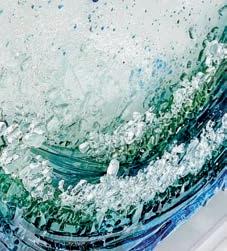
pioneer, establishing one of the s first kitesurfing schools and competing on the world circuit. At the peak of her career, she ranked third globally, a testament to her skill and determination. In 2002, she cemented her reputation for audacity by kitesurfing solo from ornwall to reland, an extraordinary feat completed in just over eight hours. Alongside this, she embraced another kind of high-adrenaline challenge, taking on the fiercely competitive world of television’s Gladiators. Competing against 24,600 hopefuls, she not only secured a place but won the 1996 championship, earning the moniker “Dreya the Slayer.” A multiple contender, she later triumphed in the 1997 Springbok Challenge and was runner-up in the 1999 upreme hampionship series, facing off against some of the show’s most formidable
names, including Lightning, Zodiac, Wolf and Hunter. These experiences, shaped by wind, water, and the physical limits of endurance, would later find their way into her art, influencing both her aesthetic and her approach to working with glass.
It was almost by accident that she discovered her passion for glass. While studying at Falmouth Art College, she lived with a landlady who introduced her to the medium, an encounter that would alter the course of her career. She describes an immediate connection: “Its colour, its reflections, and its translucent uality instantly captured my heart. To me, it has a similar quality to water. It is enigmatic; you can look at it, or through it.” From that moment, the allure of glass was undeniable. She pursued this fascination at Swansea University, specialising in Architectural Stained Glass, but it wasn’t until she stepped away from competitive sport that she fully committed to the medium.
The sea, ever present in her life, became the foundation of her artistic expression. Her studio in Newquay is a space where the energy of the ocean is transformed into solid form, each piece capturing the fluidity and light of moving water. Visitors to the studio witness the intricate, painstaking process of fused glass art – layers cut, composed and placed into the kiln, where heat and time shape the final piece. o two firings are the same, and the element of chance is embraced. Sometimes, pieces
shift in une pected ways, but rather than considering these deviations mistakes, Dreya views them as opportunities, happy accidents that lend the work its own unique character.
ne of the defining features of her work is the way she captures the sea’s mood and movement. Rather than defaulting to conventional blues, she starts with clear glass, manipulating layers to create the impression of depth, shadow, and light. ater isn t blue it s due to the reflection of the sky,” she explains. “So, by starting with clear glass, you change the mood of a wave.” This understanding of how light interacts with her medium allows her to create pieces that feel alive, constantly shifting depending on the angle and intensity of the surrounding light.
Her studio is not a solitary endeavour. Working with her small team, Ali and Lindsey, she balances the creative and logistical demands of the business, from crafting large commissions to managing orders and framing. Collaboration plays a key role in the rhythm of her work, and as she prepares to move into a larger space in Newquay, the scope of her practice continues to evolve. The new premises will bring together her gallery and studio, allowing visitors to engage more deeply with the process behind each creation. It will also provide space for workshops, an aspect of her work that she finds particularly rewarding.

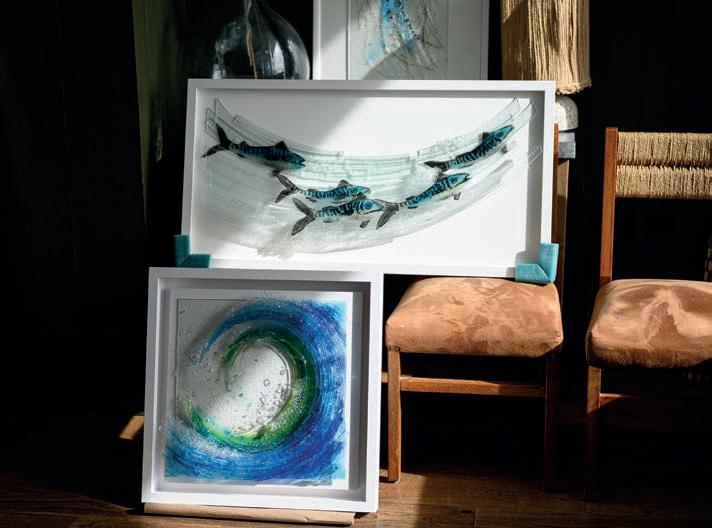
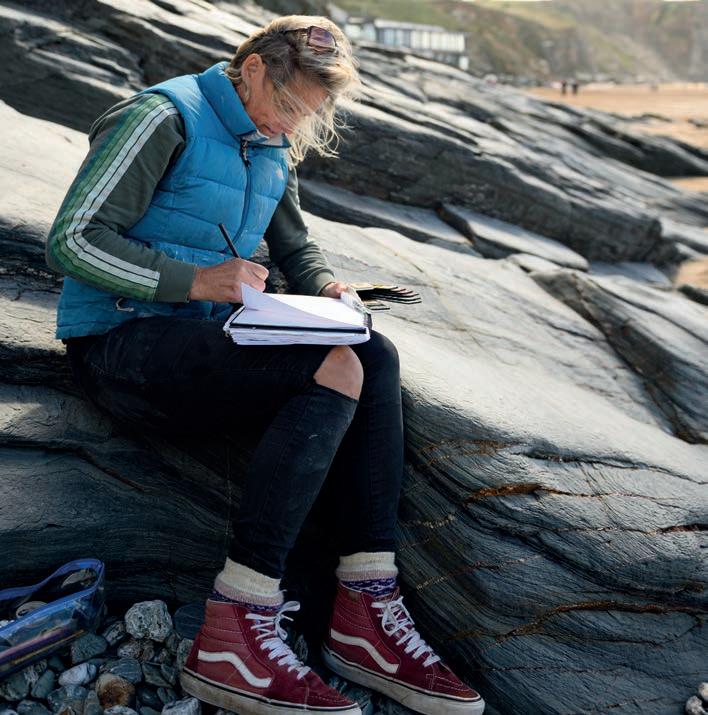
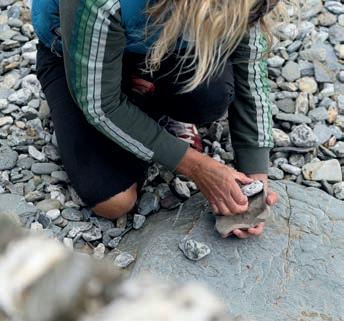
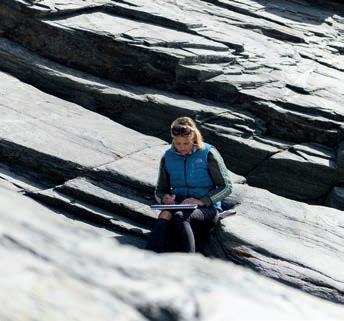

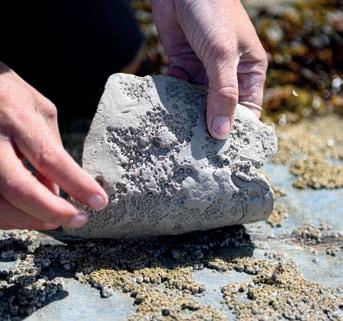
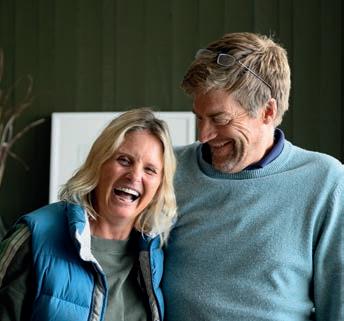
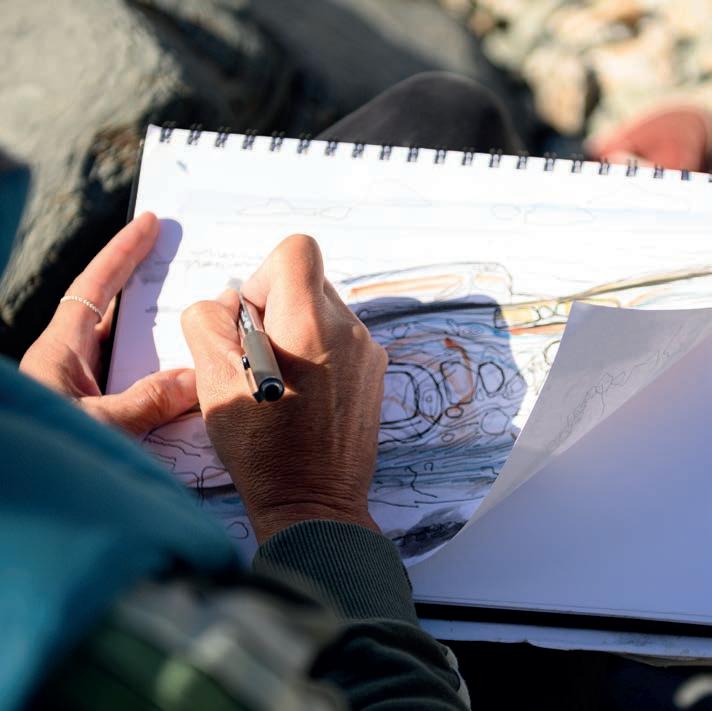
Teaching introduces an element of unpredictability; when students arrive with their own ideas, it pushes her to think differently, reminding her of the e citement of her early years in art college.
Dreya’s work has reached audiences far beyond Cornwall, with pieces collected internationally and commissions appearing in prestigious settings. In 2023, she was approached to create three large glass installations for the Royal Caribbean ship, Utopia of the Seas, a project that saw her work displayed on a grand scale, translating the motion and energy of the sea into towering forms of fused glass. Currently, she is working on a large-scale installation for a luxury home in Sandbanks, a four-storey piece that will take a year to complete. This ability to scale up, to move from intimate works to architectural statements, speaks to the versatility of her approach and the deep understanding she has developed of her medium.
to Dreya, it was a natural progression, one shaped by instinct and an enduring connection to the sea. “From the very start, I knew a traditional path in life wasn’t for me, she reflects. trusted my instincts, turning my passions into my work.” It is this same instinct that continues to guide her, whether navigating the forces of wind and water or the unpredictable alchemy of molten glass.

Looking back on the trajectory of her career, she acknowledges that her path has been anything but conventional. From professional athlete to acclaimed glass artist, the shift may seem dramatic, but
Dreya remains deeply engaged in her practice, drawing fresh inspiration from the changing moods of the Atlantic. The act of creation, like the ocean itself, is never static, and she thrives in that space between control and surrender, between the known and the unpredictable. For those who encounter her work, whether in her Newquay studio or in the grand stairwells of a cruise ship, there is a sense of something fluid, something vital, something caught between one state and the next. She continues to explore the possibilities of her medium, always searching for new ways to translate the ephemeral beauty of the sea into something tangible, something luminous and enduring.
dr a co u
A secluded and characterful mini-estate with a history tracing back to the Domesday Book.
Set on the edge of Ponsanooth, between Falmouth and Truro, this property enjoys a wonderfully private and picturesque setting. The grounds are truly exceptional, offering a sense of seclusion that sets Cosawes Barton apart. It’s little wonder the estate has been a sought-after wedding venue, or that its three holiday lets – complementing the expansive main residence – have been so successful, earning a prestigious 5 Star Gold Award.
The main house exudes charm, thoughtfully positioned to face the grounds while maintaining privacy from the cottages. Generous living areas, a spacious and sociable kitchen, and four well-proportioned bedrooms (including a master with en suite) offer ample space to relax. Vaulted ceilings, exposed beams, an original fireplace, and carefully considered interiors reflect the home’s rural Cornish character.
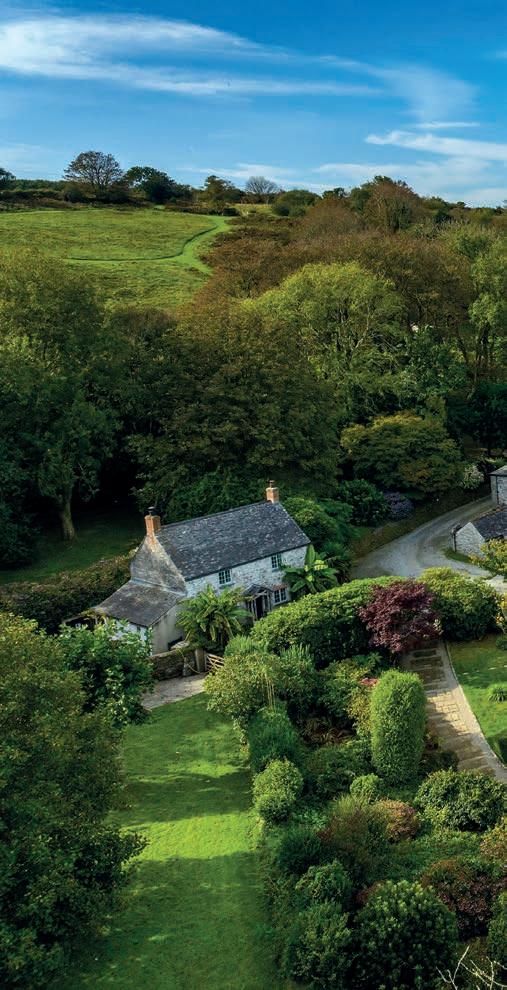
COSAWES BARTON Guide price: £2.65M
ROHRS & ROWE 01872 306360
info@rohrsandrowe.co.uk
rohrsandrowe.co.uk
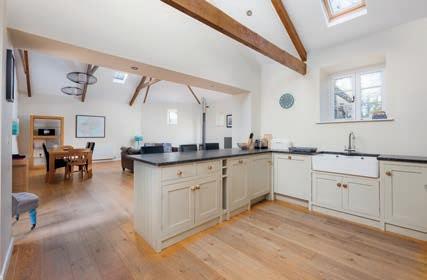
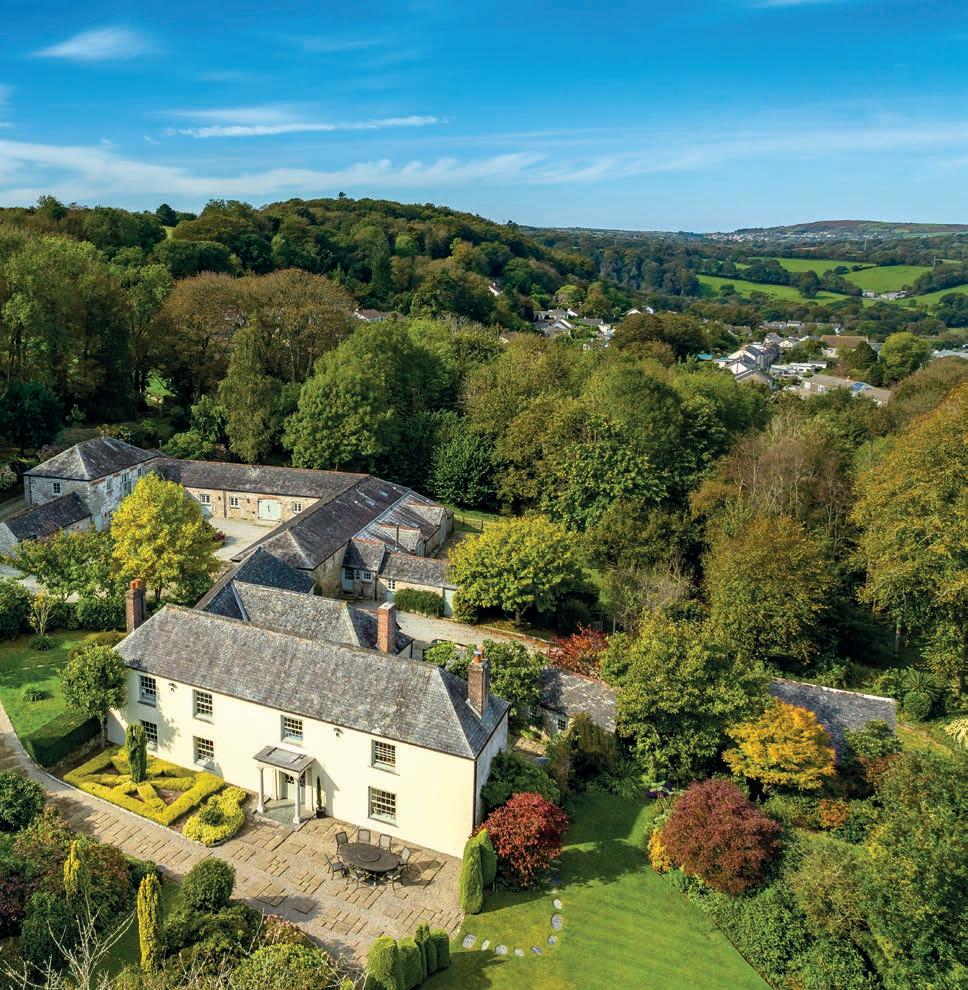

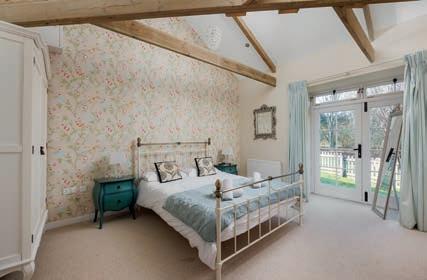
Contemporary design and environmental consciousness find form in this property of distinction.
Situated on the edges of Padstow, this architecturally striking home embodies modern luxury while embracing its spectacular Cornish setting. Designed with reverse living to maximise the spectacular views, Meraki commands sweeping vistas across the Camel Estuary and out towards the Atlantic, inviting its occupants to revel in ever-changing coastal light and the ebb and ow o the water be ow
Due for completion later this year and at over 4,400 square feet, the interiors will be a blend of form and un tion, eaturing our or fi e bedroo , i bathrooms and three beautifully appointed living spaces. Sustainability is poured into its mix, with air source heating, solar power and triple glazing en uring a ba an e between o ort and e ien hoi e o pre iu fini he re ain a ai ab e or those who wish to make their mark.
Outside, landscaped gardens and a curved driveway lead to an elegant double garage with space reserved for a swimming pool. This is modern Cornish living reimagined.
MERAKI
Guide price: £1.95M
JACKIE STANLEY
01841 532555
sales@jackie-stanley.co.uk
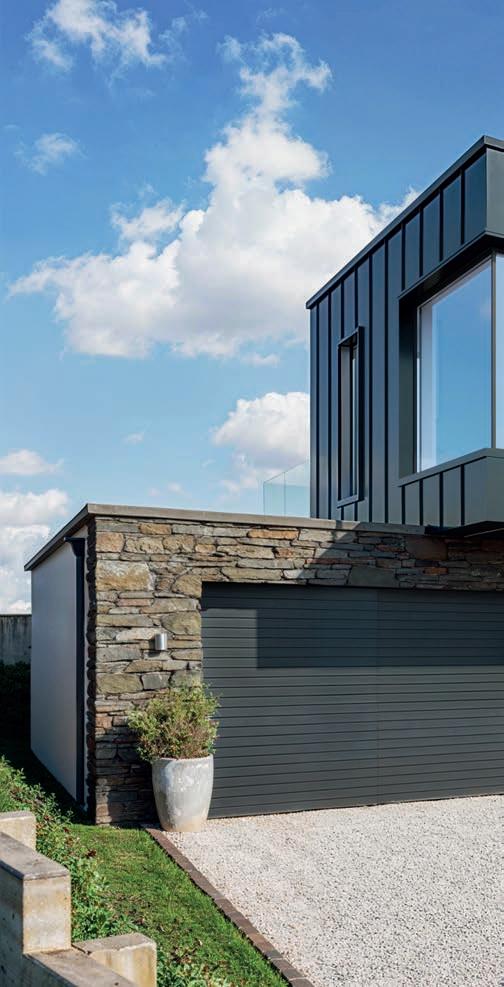
jackie-stanley.co.uk

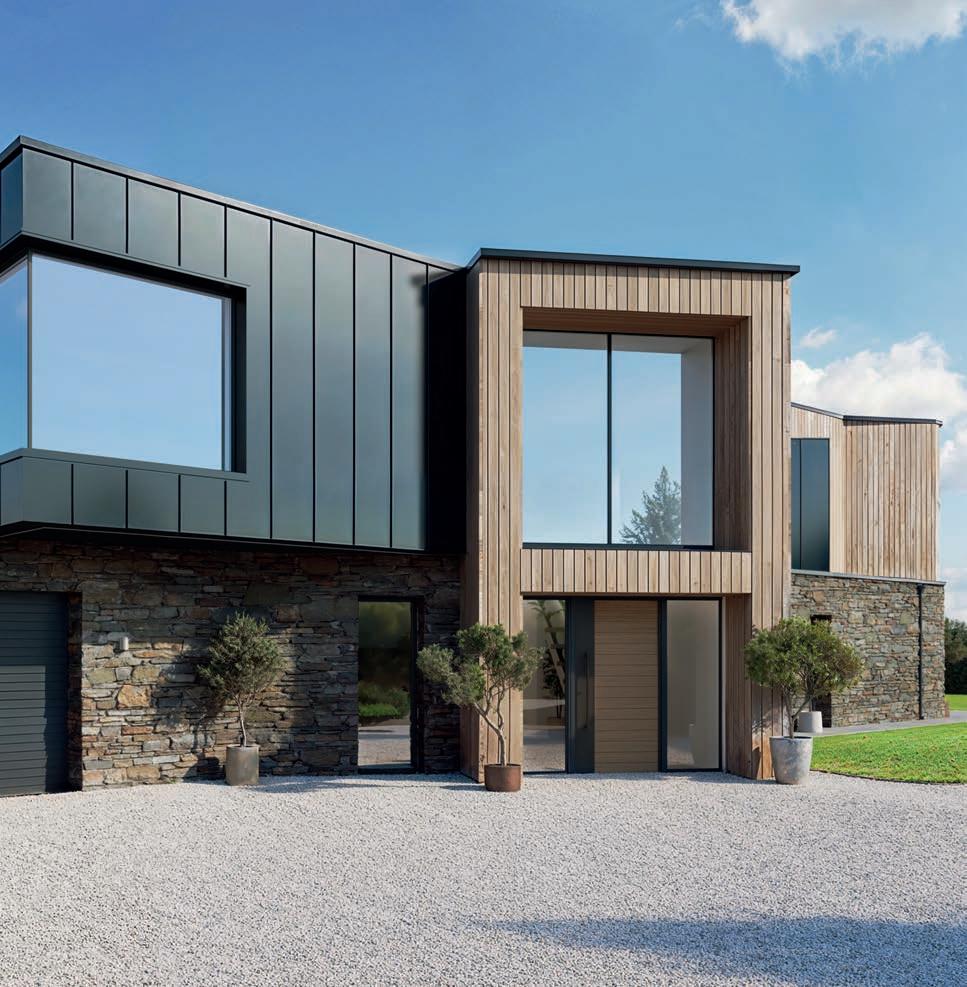
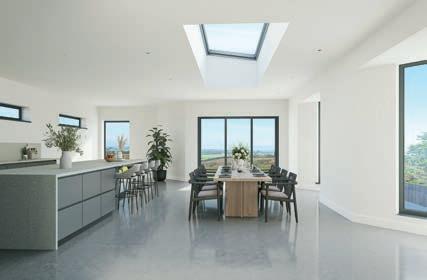

Experience luxury living in this stunning new build, an impressive and spacious four-bedroom home.
Radjel House is a newly built four-bedroom home with a granite facade and slate cills, blending established appeal with modern design. It features three reception rooms and an open-plan aluminium-framed kitchen and dining area, leading to a 70m² sandstone patio and 220m² lawn. The kitchen boasts quartz worktops, a Quooker tap, and Bluetooth spea ers. nderfloor heating runs beneath the tumbled limestone flooring, powered by an air source heat pump. A solid oak staircase leads to three bedrooms and two bathrooms, with the main bathroom featuring Hansgrohe brassware, a rain shower, a freestanding bath and a wall-mounted vanity.
Set in Pendeen, an Area of Outstanding Natural Beauty, the home is close to Geevor Tin Mine, Portheras Cove, and the South West Coast Path. The gated parking area accommodates multiple vehicles, and the enclosed garden, framed by Cornish hedge boundaries, offers multiple seating areas to enjoy the stunning coastal views.
RADJEL HOUSE
OIEO: £650,000
JACKSON-STOPS 01872 261160
cornwall@jackson-stops.co.uk

jackson-stops.co.uk
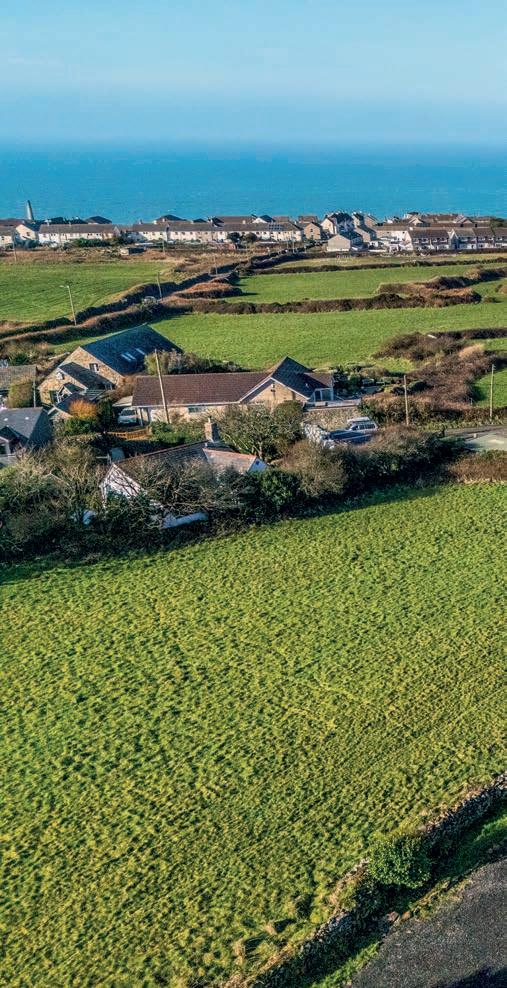
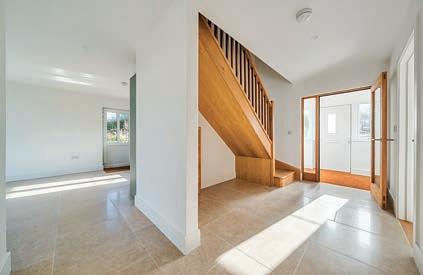

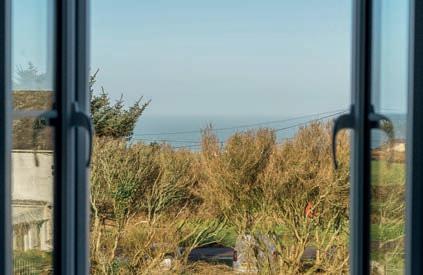
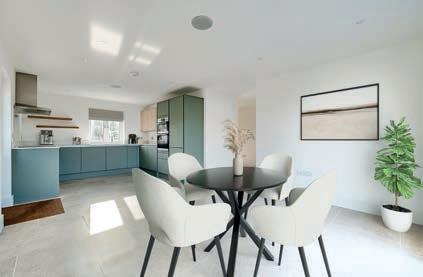
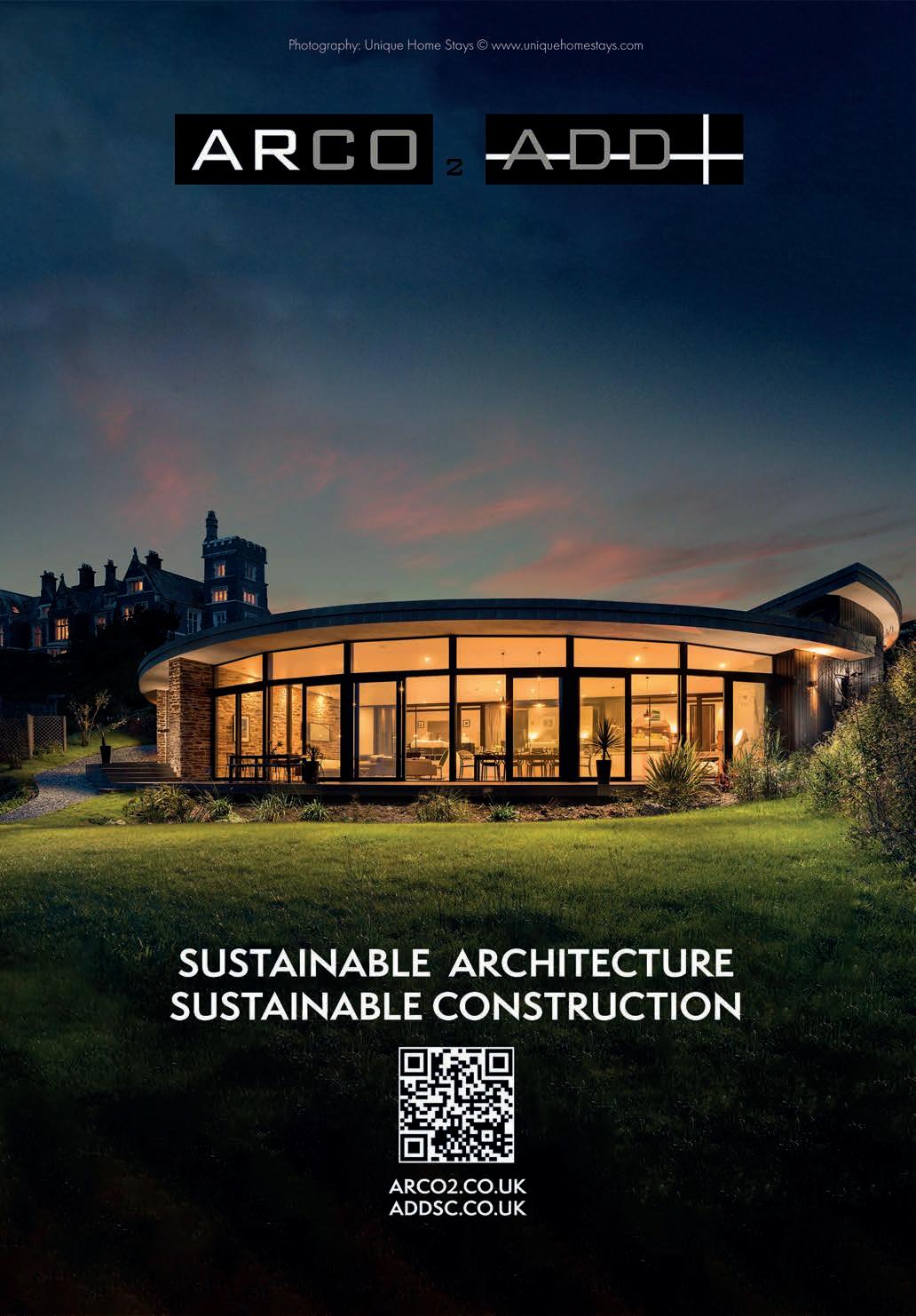
WORDS BY NATHAN OUTLAW
Tasty and inspiring ways to cook seasonal and sustaina le fis or dinner
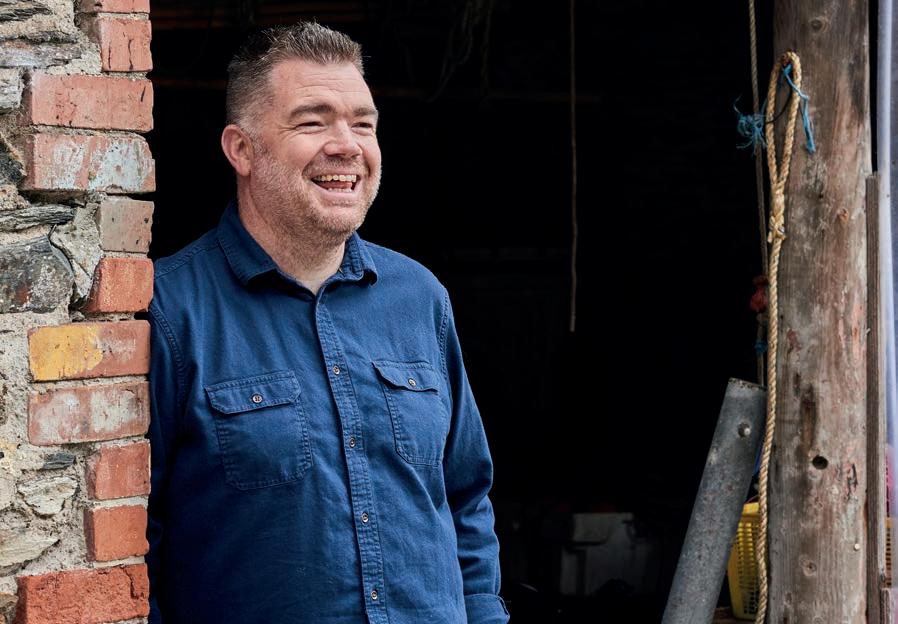

SERVES: 4
INGREDIENTS:
4 smoked haddock portions, about 120g (4¼oz) each, skinned itre up u at i
2 bay leaves
2 sprigs of sage
A pinch of salt
For the soup:
A drizzle of olive oil
75g (2½oz) unsalted butter
1 white onion, chopped
2 garlic cloves, chopped
20 sage leaves, sliced
500g (1lb 2oz) squash, peeled, deseeded and chopped
METHOD
For the haddock, pour the milk into a pan arge enough to ho d a the fi h and i uid
Add the bay leaves, sage and a good pinch of a t Bring to a i er, then ta e o the heat and leave the milk to stand and infuse while you cook the soup base.
Heat the oil and butter in a large saucepan that ha a tight fitting id o er a ediu heat. When hot, cook the onion for 2 minutes, unti it begin to o en but not o our dd the garlic, sage and squash and cook for a further 5 minutes, stirring occasionally so nothing catches. Next, pour in the stock, then cover and cook for 20 minutes until the squash is tender. Remove the lid, season with salt and pepper and cook for a further 5 minutes. Transfer to a blender and blitz for 2 minutes, or use a stick blender to blend until smooth.
Once the soup base is cooked, carefully place the haddock in the infused milk and slowly bring back to a simmer. Poach gently for
o egetab e to
Sea salt and freshly ground black pepper
For the sage cream:
150g (5½oz) crème fraîche
150g (5½oz) double (heavy) cream
2 tablespoons chopped sage
Zest of 1 lemon
To garnish:
4 teaspoons pumpkin seeds
4 tablespoons pumpkin seed oil
TIP: uas is a reat sou ma in in redient and loves to e lended to a smoot sou li e t is one
inute are u i the haddo out o the milk and drain on kitchen paper. Save the milk to thin the soup.
For the garnish, lightly toast the pumpkin seeds in a dry frying pan over a medium heat or inute unti the e toa ted, then add a pinch of salt and the pumpkin seed oil. Allow to cool to room temperature.
In a bowl, whisk the crème fraîche, cream, chopped sage and lemon zest together and season with salt and pepper to taste. Whisk to ti pea , then et a ide
Pour the soup back into the pan, thin it down a little with the poaching milk and warm it through. Taste to check the seasoning, adding more salt and pepper if needed. Share the a ed o ed haddo and oup between war ed bow and fini h with the pumpkin seed garnish and the sage cream.
Serve immediately.
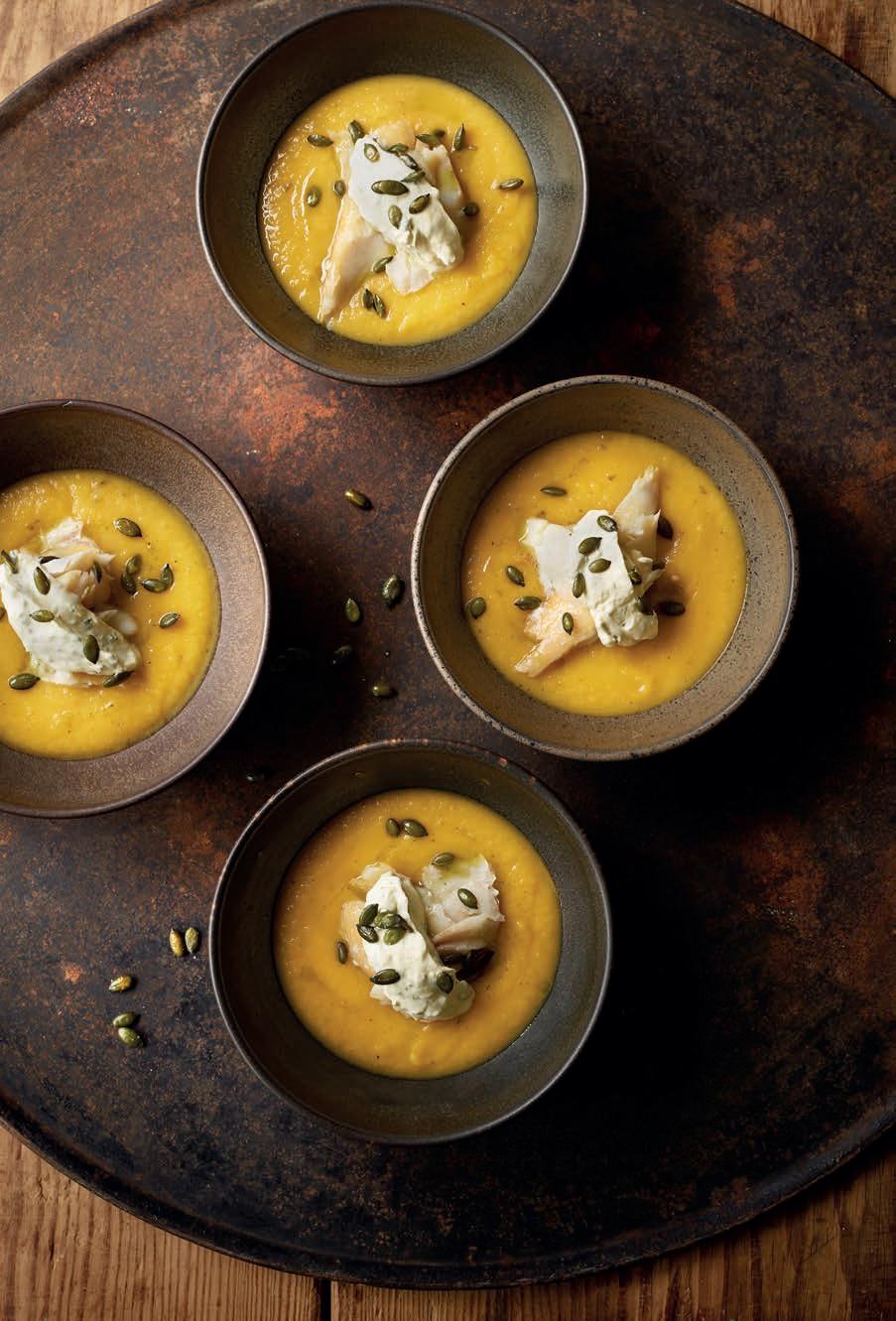

SERVES: 4
INGREDIENTS:
A little light olive oil, for oiling and drizzling
24 marinated anchovies in vinegar
an ho fi et in o i e oi
g o good ua it o are a, bro en into pieces
Sea salt and freshly ground black pepper
1 teaspoon chopped thyme, to serve
For the flatbread dough:
g o e rai ing our
2 teaspoons sea salt
g o u at ree ogurt
100g (3½oz) crème fraîche
tab e poon hopped at ea par e
20g (¾oz) Parmesan, grated gar i o e, fine hopped
METHOD
ir t a e the atbread dough a e a the ingredients in a bowl and mix well until evenly combined and the mixture forms a dough urn out onto a ight oured surface and knead for 2 minutes. Cover with a clean, damp cloth and set aside while you make the topping.
For the topping, heat the oil and butter in a medium pan over a medium heat. When hot, add the ha ot , to atoe , gar i , a ron and rosemary and cook for 5 minutes, stirring frequently, until the vegetables start to o en ower the heat and oo gent for a further 5 minutes. Now add the wine vinegar and sugar and cook until the vinegar has reduced right down, then add the capers. Season with salt and pepper to taste, then tip the mixture onto a tray and set aside to cool.
pin he o a ron trand , oa ed in tab e poon warm water for 10 minutes
For the tomato topping:
3 tablespoons olive oil
50g (1¾oz) unsalted butter
2 banana shallots, sliced
4 ripe tomatoes, peeled and chopped
2 garlic cloves, sliced in h o a ron trand
1 tender sprig of rosemary, leaves picked and chopped
4½ tablespoons red wine vinegar g o a ter uperfine ugar
1 tablespoon small capers in brine, drained and rinsed
reheat the o en to an , a Mark 9 and oil two large baking sheets with olive oil.
Divide the bread dough into 4 equal portions and shape each into a ball. Roll out each one into a round, about in thi i onto the oiled trays.
Divide the tomato topping between the 4 dough bases, making sure you spread it right to the edges. Scatter over both types of anchovy along with the mozzarella. Slide the atbread into the o en and ba e or minutes until nicely coloured and crispy at the edge ou ta e the atbread ro the oven, drizzle with a little olive oil and sprinkle with chopped thyme.
Serve at once.
SERVES: 4
INGREDIENTS:
12 scallops, shucked and prepped, roes retained
8 new potatoes, cooked and halved Zest of 1 lime
2 teaspoons ground coriander
1 tablespoon chopped coriander (cilantro)
8 tablespoons white wine
Sea salt and freshly ground black pepper i e wedge , to er e
For the bread sauce:
100g (3½oz) whole blanched hazelnuts
120g (4¼oz) good crustless bread, cut into chunks gar i o e , fine hopped
2 teaspoons ground cumin
4 tablespoons lime juice o e tra irgin o i e oi
METHOD
First make the bread sauce. Preheat the oven to an , a ar Spread the hazelnuts out onto a tray and cook or inute unti go den and roa ted Meanwhile, cover the bread with water and leave to soak for 10 minutes.
Place the hazelnuts, garlic and cumin in a ood pro e or and pu e unti fine S uee e the excess water out of the bread, then add it to the food processor with the lime juice, and some salt and pepper. With the motor running on the food processor, add the oil in a steady stream. Once all the oil has been incorporated, taste the bread sauce and adjust the seasoning with salt, pepper and lime juice. If too thick, add a little water.
Refrigerate until needed.
Now make the red (bell) pepper mix. Heat the olive oil in a frying pan over a medium heat and fry the onion for 5 minutes, stirring occasionally. Add the garlic, celery and red peppers and season with salt and pepper, then cook for a further 5 minutes. Finally, add the thyme, stir everything together and transfer to a tray to cool.
For the red peppers:
1 tablespoon olive oil, plus extra for drizzling red onion, fine hopped gar i o e , fine hopped
1 celery stick, sliced into thin half moons
1 x 480g (17oz) jar of chargrilled red (bell) peppers in vinegar brine, drained and chopped
2 teaspoons chopped thyme
Alternative fish:
itt e hun o on fi h or ha e, oo ed the same way
TIP: e most common scallo s in t e are t e reat tlantics and t e ueens n merica ou ll find a scallo s or sea scallo s ou can or out o old t e are countin t e rin s on t eir s ells
To cook the scallops, turn the oven up to an , a ar n a ean work surface, lay out 4 large sheets of baking parchment paper (roughly 30 x 30cm/12 x 12in). Divide the red pepper mix into 4 equal portions and arrange over one half of each sheet of parchment. Place 3 scallops on top of each portion, together with 3 halves of cooked potato then season with salt, pepper, lime zest and the corianders. Fold over the paper and ri p the edge o the are fir pre ed, ea ing ou with a par e ea e a a opening to allow you to pour 2 tablespoons of white wine into each parcel. Seal the last hole up by folding it down tightly. If the quality of the paper isn’t great, you may need to use 2 sheets for each parcel or add a layer of foil on the outside. The aim is that the moisture in ide doe n t e ape thi i rea i portant
Place the parcels on a large baking tray and cook for 15 minutes. Once the scallops are baked, leave them to rest out of the oven for 5 inute and then er e et whoe er ou are cooking for open their own parcel. Serve the bread sauce on the side at room temperature with lime wedges.

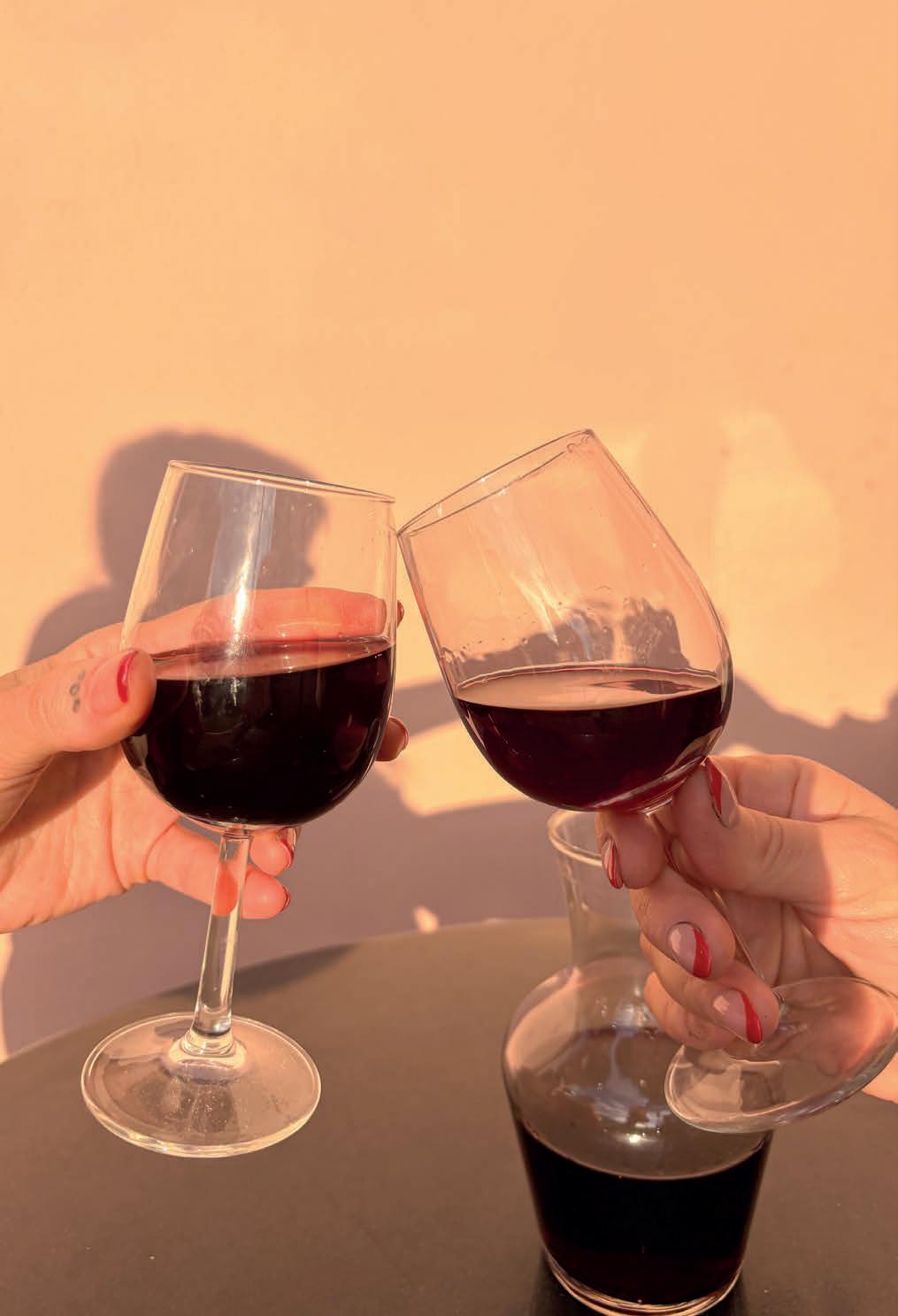
WORDS BY JAMIE CROCKER
This is a tale of friendship, food and design that have melded to form Bolla.
Just a stone’s throw from the harbour along Fore Street in Porthleven, Cornwall’s most southerly working port, an unexpected slice of Parisian bistro culture has taken root. Bolla, a wine bar and eatery that opened its doors in July 2024, represents more than just another addition to Cornwall’s flourishing food scene – it’s the culmination of two creative journeys that converged in the most serendipitous of ways. This establishment, which blends the chic sophistication of considered continental dining with the warmth of Cornish hospitality, emerged from a friendship between two women whose paths to Porthleven could not have been more different.
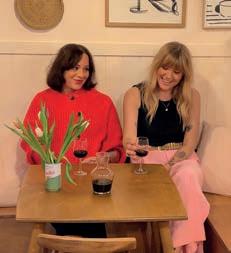
The story begins with Jaime, a chef whose culinary journey spans continents and whose philosophy was forged in the crucible of fine dining itchens across ondon. er introduction to the world of hospitality came remarkably early – at age 11 – in an era when such things were still possible. This early exposure to professional kitchens laid the foundation for what would become a lifelong passion for food and flavour.
During her college and university years, Jaime balanced her studies with work as head cook at a recording studio café in ast ondon, an experience that taught her the art of managing a professional kitchen while maintaining creative output. er subse uent career too her through
some of ondon’s most prestigious fine dining establishments, each position adding layers to her culinary expertise.
But it was her four-year sojourn in India that truly transformed her approach to cooking. “My approach is about taking very little and getting the most out of it,” Jaime explains, describing her culinary philosophy. “When you understand spices, you begin to see infinite possibilities in even the simplest ingredients. Take a beetroot – suddenly it becomes a canvas for exploration.” This time in India wasn’t just about learning recipes; it was about understanding the fundamental principles of flavour combinations and the transformative power of spices.
While Jaime was building her reputation in ondon’s culinary scene, including a stint as head chef at the prestigious Wellington Club in nightsbridge, uci was developing her artistic voice on the other side of the world. er ourney began in est ussex, where her childhood bedroom walls were plastered with drawings – an early indication of her creative spirit. Initially drawn to fashion design, a pivotal moment at a ondon university open day led her to reconsider her path.
t was in ydney, ustralia, where uci’s true creative direction emerged. A graphic design course became the catalyst for her artistic evolution, introducing her to layout, typography, and the technical tools that would later prove crucial in creating Bolla’s visual identity. “When I encountered Adobe
n esign, everything clic ed, uci recalls. “I knew exactly which direction I wanted to take my career.”
eturning to ngland in , uci chose Brighton as her base, combining her visual merchandising experience at Ted Baker with growing opportunities in graphic design. er role at What’s Happening in Brighton magazine provided valuable experience in layout and coordination, while freelance work allowed her to develop her distinctive style and work with independent and established businesses for a variety of design work from branding to illustration.
The inspiration for Bolla crystallised during Jaime’s years of chaperoning culinary students in Paris through the Erasmus+ program. “I developed a serious love affair with aris, she recalls. hat captivated me was how one establishment could seamlessly transition from serious coffee service to lunch to dinner, with nowledgeable staff who cared deeply about both food and wine. Nothing was stuffy you could smo e a cigarette, sip Gamay, and watch the world go by, or savour a perfectly executed steak tartare.”
his arisian influence would later become crucial in shaping Bolla’s identity, but first, aime’s ourney would ta e several more turns. fter having children, she transitioned to freelance catering in ondon before accepting a position at Truro & Penwith College, where she spent a decade running the college restaurant, Senara.
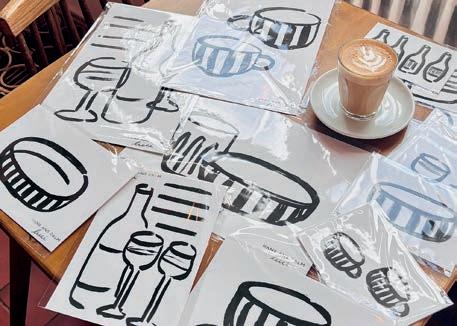
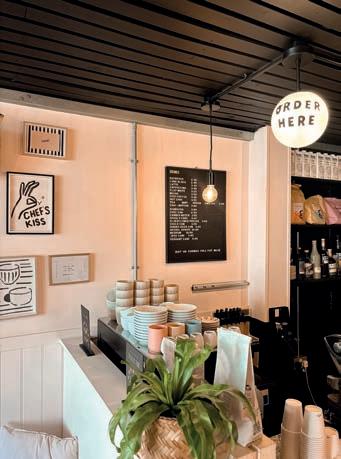
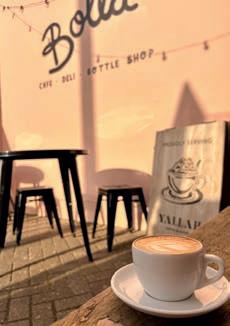
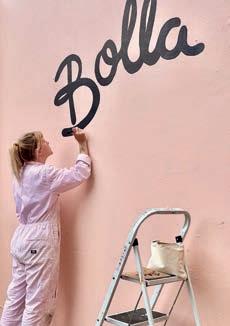
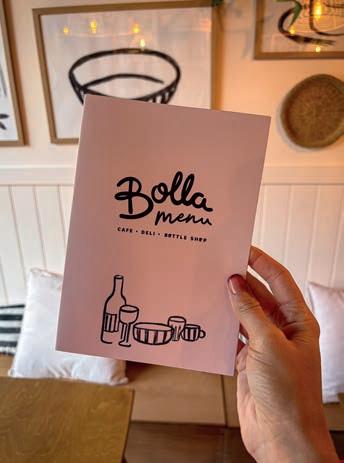
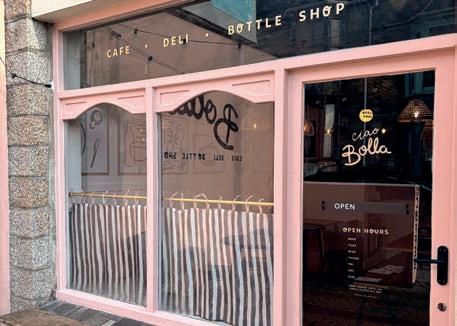
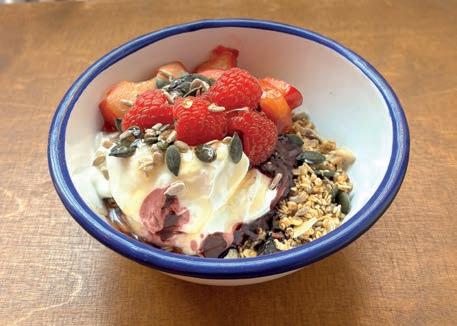
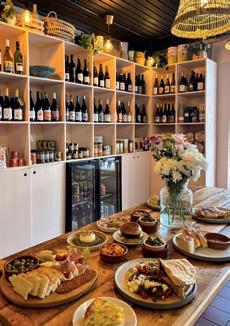
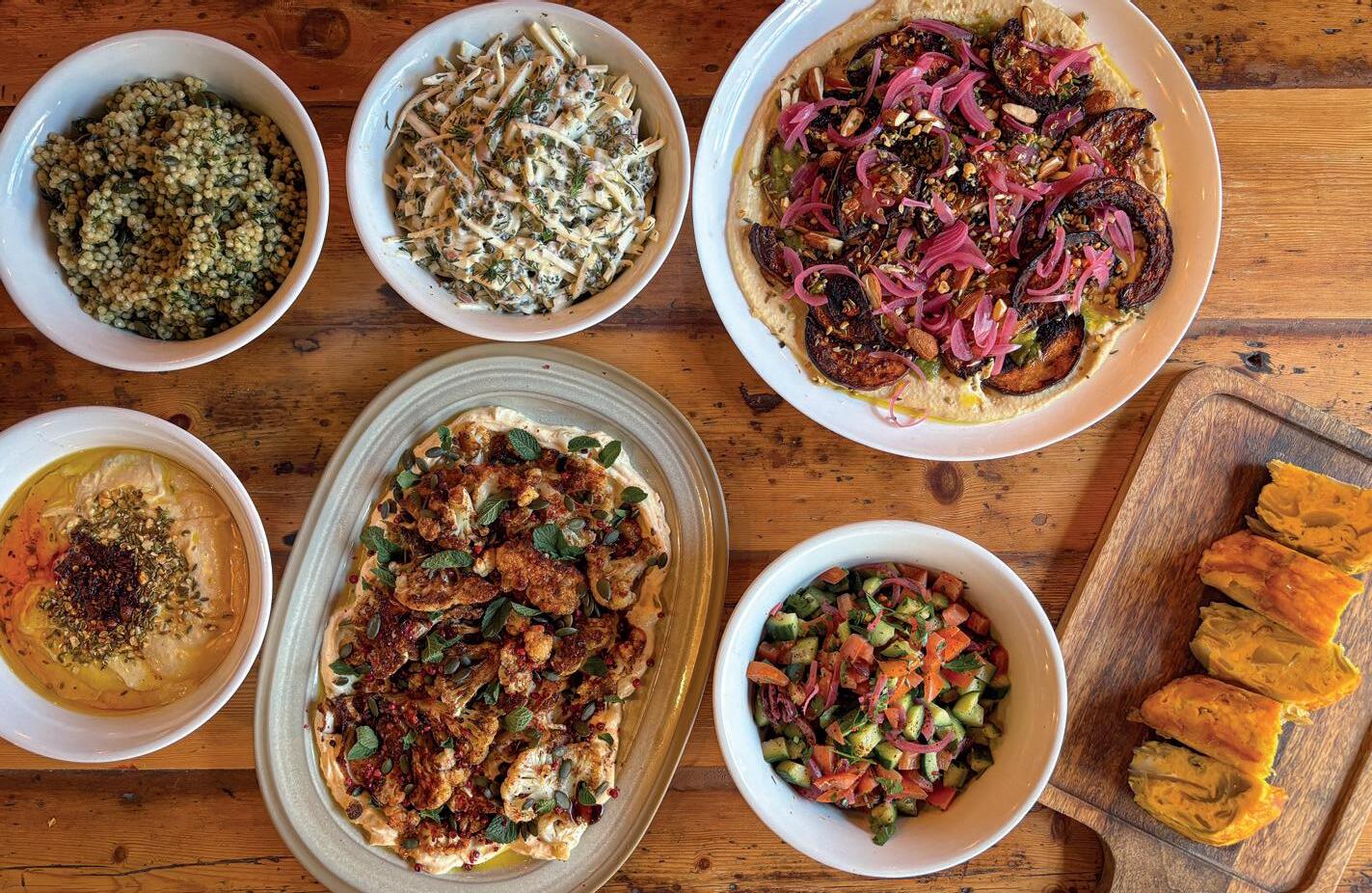


ABOVE
If this isn’t temptation…
It was here that her passion for wine began to develop – she took her Wine & Spirit Education Trust (WSET) awards and is starting her diploma later in the year.
The COVID-19 pandemic proved to be a catalyst for both women. For Jaime, it led to the creation of Poké Food, a collaboration with her personal trainer friend Serene, providing nutritionally balanced meals for clients maintaining their fitness routines during loc down. or uci, furlough from her design position became an unexpected creative opportunity.
uring loc down, filled four s etchboo s, uci remembers. t was a time to experiment with different styles, to find my voice without pressure. here’s something freeing about sketching – it’s less restrictive, more spontaneous.” This period of creative exploration led to online art sales and eventually influenced her decision not to return to her previous employment.
Their paths eventually converged at Porthleven’s Shipyard Market, where uci had secured a stall selling her prints, cards and bags after relocating to Cornwall in 2021. Jaime’s Poké Food, which had outgrown its home-based origins, also found a home in the market. What began as a vendor friendship soon blossomed into a creative partnership that would transform both their trajectories.
When their current location became available, Jaime envisioned creating more
than just a restaurant – she wanted to establish a community hub where solo female diners could feel comfortable with a book and a glass of wine, where families could gather for boisterous celebrations, and where the lines between coffee house, wine bar and bistro would blur into something uni uely welcoming.
The design process began in Jaime’s itchen, where she and uci brainstormed over wine and sketches. The name “Bolla” – Cornish for “bowl” but with an Italian lilt emerged organically, and uci s etched the logo then and there. “Jaime gave me free rein with ust one re uirement dusty pin , uci remembers. he trust between us made the creative process incredibly fluid.
uci’s bac ground in visual merchandising, combined with her experience in brand development, proved invaluable in creating Bolla’s distinctive atmosphere. The interior design draws from both women’s travels, creating a space that feels both international and intimately local. During renovation, they discovered original floor tiles that became a central feature of the design, adding an element of historical authenticity to their contemporary vision.
“We wanted customers to feel they’d had an experience while dining at olla, uci explains. er approach combined retail, art and graphic design principles to create an environment that enhances the dining experience without overwhelming it. The
space reflects both women’s belief that good design, like good food, should be accessible without sacrificing sophistication. he menu reflects aime’s extensive wine knowledge and her talent for creating what uci describes as relaxed food done really well. mall plates showcase aime’s gift for extracting maximum flavour from carefully chosen ingredients, while the wine selection benefits from her ability to guide customers toward perfect pairings.
This approach to food and wine is deeply rooted in Jaime’s Italian-English heritage and her years of culinary exploration. “Food was always a huge deal in my family,” she notes. “It’s about taking simple ingredients and elevating them through understanding and techni ue. his philosophy aligns perfectly with Bolla’s ethos of accessible sophistication.
ince opening, olla has uic ly become exactly what its creators envisioned a neighbourhood local with international flair. t’s a place where conversations flow as freely as the wine, where solo diners feel as welcome as large groups and where the boundaries between café, wine bar and restaurant dissolve into something uni uely welcoming a space where the vision of two creative forces has combined to create something greater than the sum of its parts.
Regular events, from wine tastings to special dining experiences, have helped build a community around Bolla. “We wanted to create a place where people could come together, where food and wine could be appreciated without pretension,” Jaime explains. This vision has resonated with locals and visitors alike, making Bolla a destination for those seeking both culinary excellence and comfortable conviviality.
Bolla represents a remarkable synthesis of culinary expertise and design sensibility, but perhaps more importantly, it embodies the power of creative collaboration between two women at the height of their respective crafts. he space they’ve created serves as both a testament to their friendship and a gift to their community a place where the sophisticated meets the comfortable, where design enhances dining, and where everyone is welcome to linger over a glass of wine or a perfectly crafted coffee.
As Bolla continues to evolve, both Jaime and uci remain committed to their original vision while staying open to new possibilities. “This is just the beginning,” Jaime says, while uci nods in agreement. e’re excited to see how Bolla will grow and change while staying true to its core values of uality, community, and creative collaboration.”
bollaporthleven.co.uk

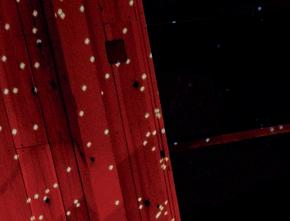

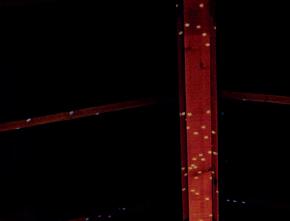
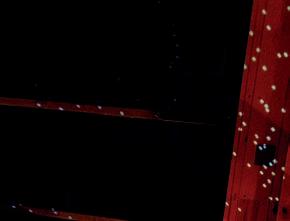
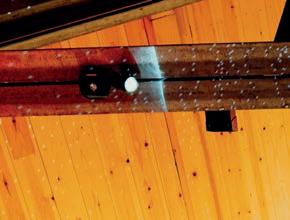
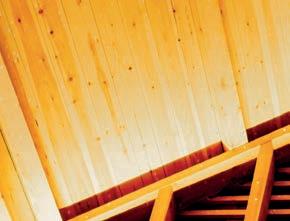
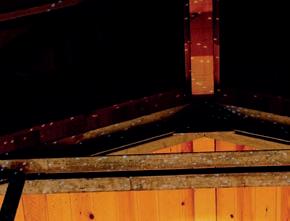
WORDS BY HANNAH TAPPING


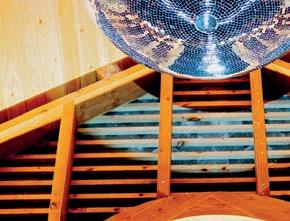
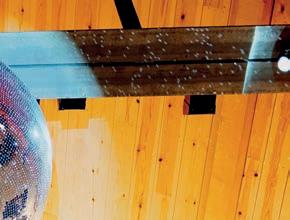



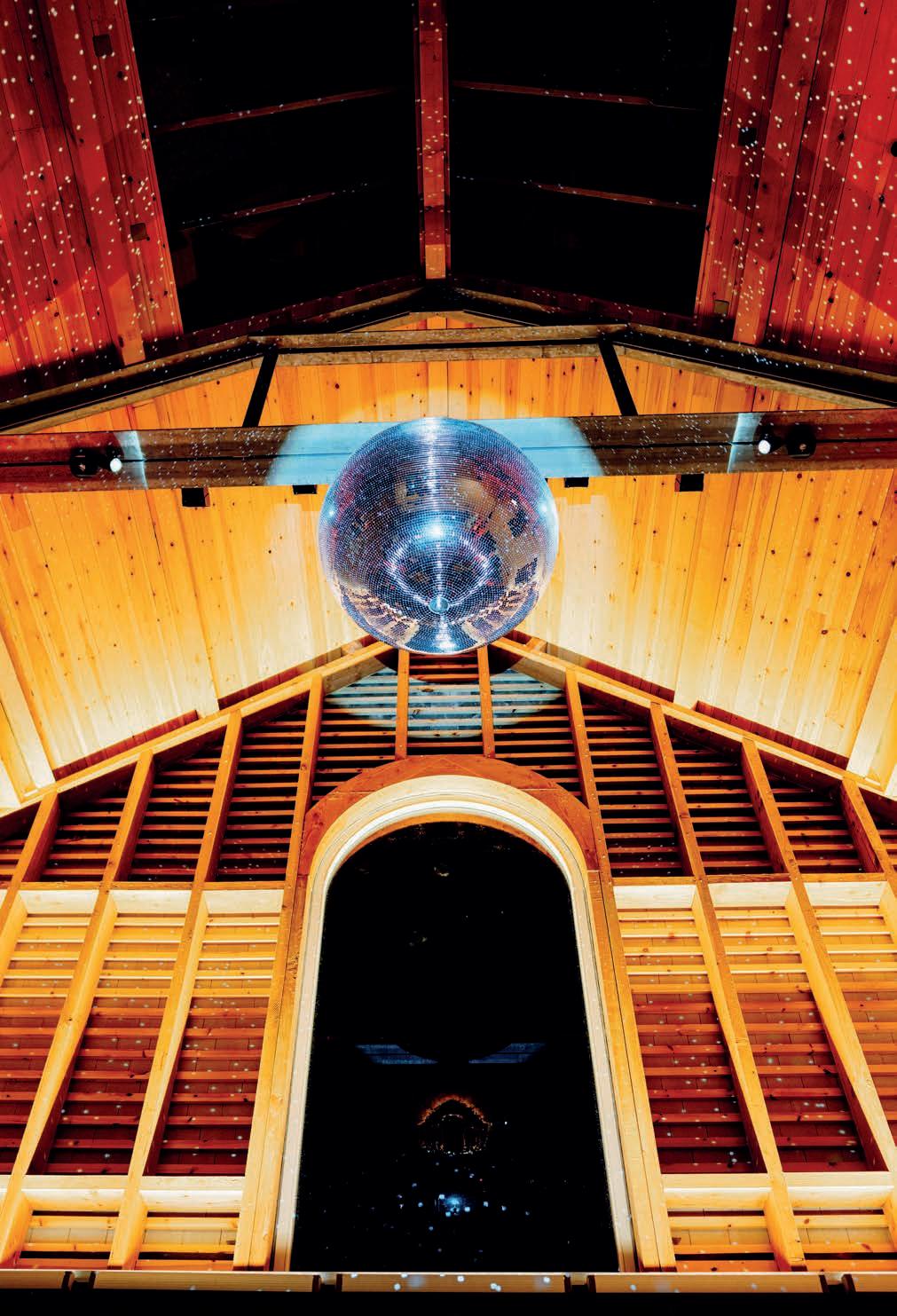
A Grade-II listed cluster of historic buildings has been reimaged for the modern era as a European-style food court, work and retail space.
Cornwall’s mining towns are etched with the marks of industry and ingenuity. Redruth, once the beating heart of Cornish prosperity, has in recent decades been caught in the ebb and ow o hange, teetering on the brink of nostalgia and reinvention.
Now, thanks to the e ort o edruth Revival Community Interest Company (CIC), the town has a new focal point –The Buttermarket – a £4-million project led by six local volunteer directors whose aim is to ‘breathe new life into Redruth town centre’.
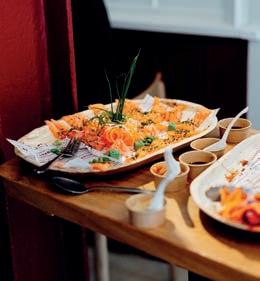
Cornwall, but it had to be demolished in 1795. Local landowner Sir Francis Basset instigated the construction of a new market in 1825 which became known as the Buttermarket and subsequently played a large part in developing Redruth’s identity as a market town. It was a popular meat market for many decades, however, over time as mining declined and economic hi hanged the town’s landscape, the Buttermarket gradually fell into disuse, its grand ar hite ture e to weather the years.
While its modern reinvention is the reason for my visit, I’m intrigued as to its past. In 1791, Redruth had the largest market in
Judy Davidson MBE, former Mayor of Redruth and chair of Redruth Revival CIC, has worked on the project for over a decade alongside fellow directors Jan Driver, Paul Harris, Aaron Pascoe, Tamsin Spargo, and Ross Williams.
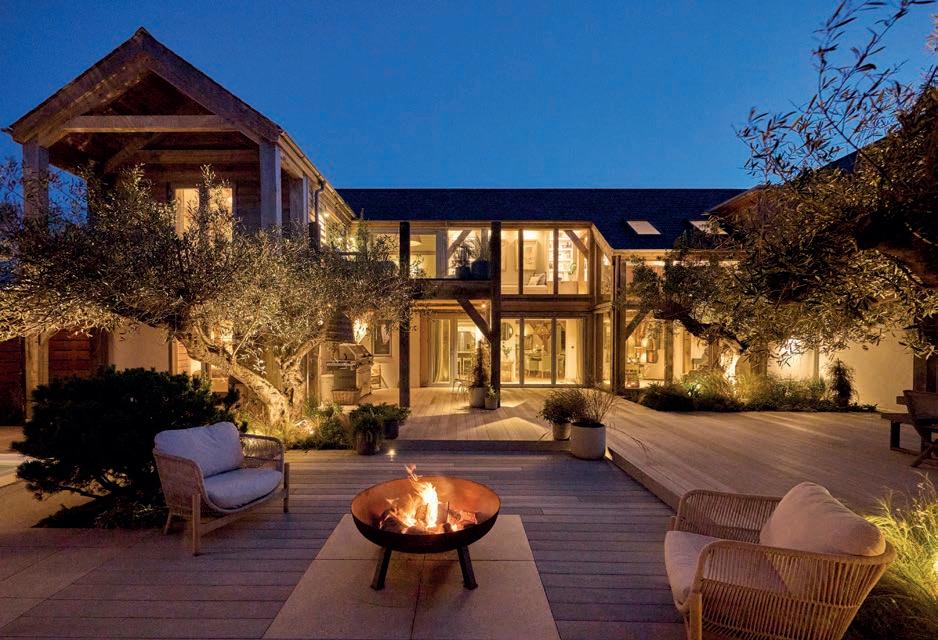

Their commitment has transformed an ambitious concept into a dynamic space where people can gather, create, and, most importantly, taste the world on their doorstep. “It has been a long journey, but to see the Buttermarket bustling with life again is incredibly rewarding,” says Judy. “This space is for everyone, and we hope it will continue to be a cornerstone of Redruth’s regeneration.”
he finan ia upport behind the Buttermarket has been instrumental in making this project a reality. Stephen Boyce of the National Lottery Heritage Fund praised the initiative: “Redruth Revival CIC has done a fantastic job, not only saving these important historic buildings from decay and potential loss, but ensuring that they can play a vital part in Redruth’s social and economic future. This is precisely what the Heritage Enterprise scheme, from The National Lottery Heritage Fund, was designed to do, and we’re thrilled that National Lottery players’ money has been put to such positive use.”
and restoration, with many historical features still intact or stylishly revitalised by Thread Architects.
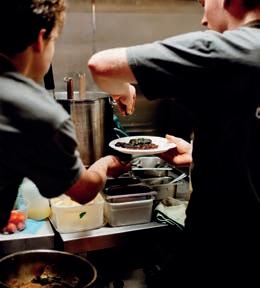
Today, its revival represents not only a restoration of bricks and mortar but a reconnection to Redruth’s industrious past. The Buttermarket’s history and heritage have been front and centre during its design
As I pull into the adjacent Fair Meadow car park – also owned by the CIC with charges kept low during the day and free at night –there’s a steady stream of people walking up the granite steps into the entrance. There’s tep ree and i a e urther up the hi or during opening hours you can mooch past the independent shops on Market Way which leads straight into the Buttermarket’s courtyard. Granite abounds and original ag tone , pi ar , arches and wroughtiron work have been carefully restored. All the woodwork’s had a coat of red paint, anchoring the building to the town’s mining heritage and quite frankly, making it into a joyous space to be. Designed to be ‘a laidback playground for foodies and culture vultures’ the main ourt ard, whi h hou e o e abo e, ha undercover seating and outdoor tables and ben he or when the weather fine There’s space here for markets and music events and a soon-to-be cycle hub – this is understated cool meets sympathetic renovation at its best.
In order to provide an indoor eating area and space to house the collective of


kitchens, the architects created a central glass atrium that spans the far end of the courtyard. Its clever design means that it doesn’t detract from the building’s history yet provides a modern space for sampling the ho t o oodie de ight on o er he Butter ar et ha it own o ee ounter ourte o o e n, er ing rigin o ee roa ted in orth e en and ar e Bar na ed a er a bu ine on e on the ite , where ou an en o ra erdant beer brewed in enr n, fine wine or a uir cocktail. There are four resident kitchens: Bango Kitchen, whose Asian street food is revered county-wide; Cowgirls serving grass-fed, retired dairy bee ro the fie d of nearby Stithians; Caths Cornish Kitchen for buttery pastry and pies; and Little Ears whose small-batch homemade pasta and sauces brings a taste of Italy to the Buttermarket. There are also smaller kitchens available to rent as popups – on the day of my visit the aromatic smells emanating from The Jar’s Indian and Sri Lankan-style street food and Harry’s Mercado tacos are simply heavenly.
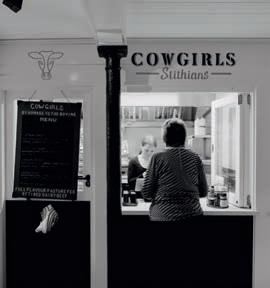
the a e t e o ood and then wait or your little buzzer to sound that your food is ready to collect. It’s simple, yet ingenious. For a Thursday lunchtime on a grey early February day it’s impressive that most of the tables are already full and General Manager, Jonathan Bray tells me that evenings are even more popular. It’s easy to see why – it’s a cool venue, with cool tunes and super-tasty food… yet with a price point that won’t break the bank. Everything ee e ort e par ing i ea , the pa e has a welcoming feel to it, ordering is i p e and the a our are unforgettable.
Sipping hot o ee a we chat, Jonathan goes on to say that: “To see this iconic building come alive again is nothing short of joyous. We’re committed to delivering experiences and events on a regular basis as The Buttermarket becomes the new beating heart of Redruth and a major attraction in Cornwall. Events for all ages are already underway and the spacious courtyard promises to be an ideal summer venue.
As all of the kitchens are situated around the central seating hub; the idea is that you grab a drink, order from whichever kitchen takes your fancy (it’s perfect for families who may not always want to eat
For a recent feast night, Bango Kitchen teamed up with Sharp’s Brewing Company for an immersive Silent Bistro experience, an evening that fused small-plate Asian street food with expert beer pairings. Guests dined on e ui ite ra ed di he u h a


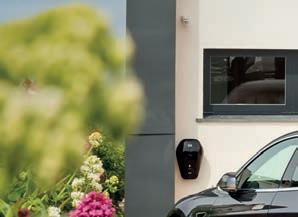
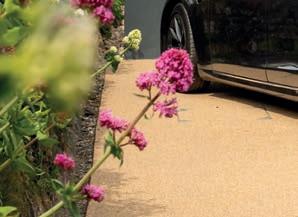





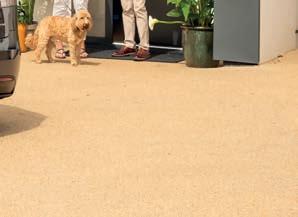






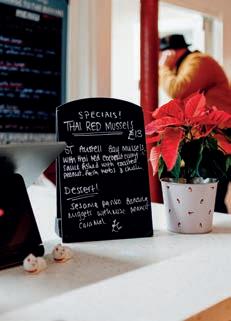

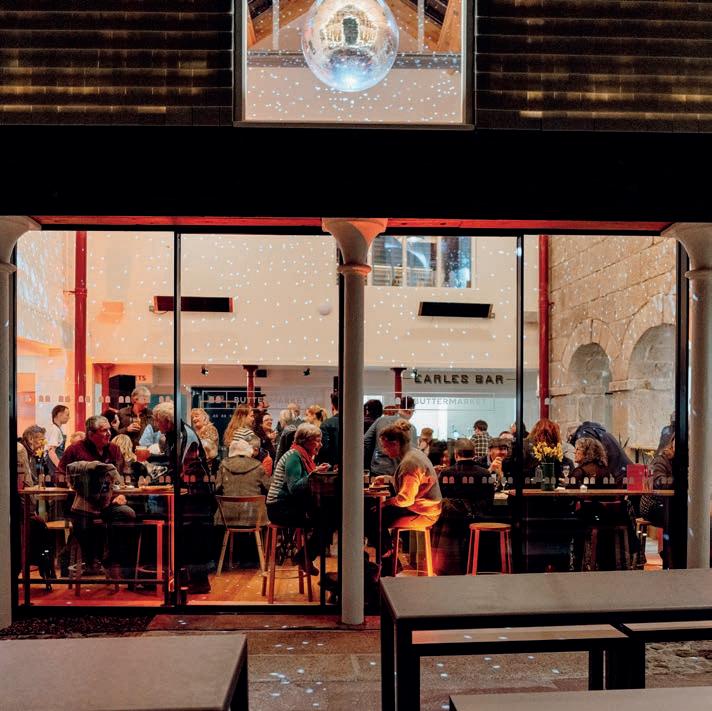
ABOVE
The space lends itself to feasting with family and friends
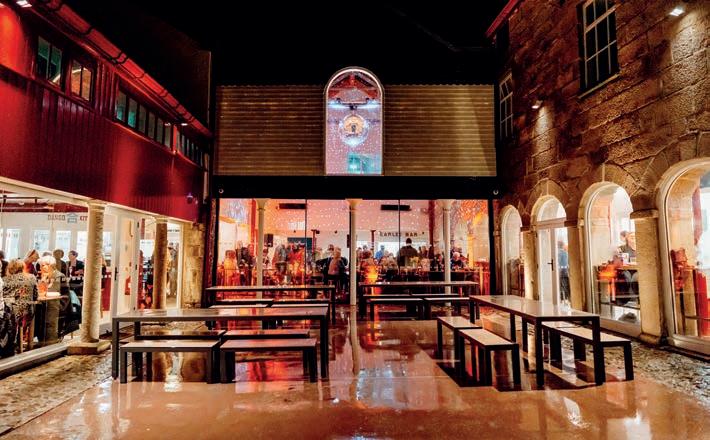
or S a ipop a hai a r i e fi h ba served with primrose herd kushiyaki), West Country Teriyaki Flat Iron Steak, and a rich 48-hour roast chicken and pork tonkotsu nood e broth a per e t at hed with Sharp hore i ner, win oa t Se ion a e e, and the di tin ti e oo Bar daiquiri ‘hoptail.’ It was an evening of bo d a our , en or urpri e , and the ind o u inar o aboration that the Butter ar et wa bui t to o ter
i r her o Bango it hen re e ted on the experience: “We had a fantastic evening with our friends at Sharp’s, providing a who e e ening o a our u i er ion or our shared guests. Our specially created dishes were greatly received and perfectly paired with Sharp beer and ider t i a real joy to experience people enjoying di erent a our o bination that the might not usually consider.”
The vision doesn’t stop here though. With a profit ro edruth propertie reinvested into regeneration projects, the Butter ar et i on the beginning an are already in motion to further revitalise edruth, with new pro e t on the hori on that promise to cement the town’s reputation as a cultural and culinary destination.
the Butter ar et ontinue to e o e, one thing i ertain edruth tor i far from over. With a thriving food scene, an emerging cultural identity, and a commitment to reinvention, this historic town i pro ing that o eba aren t u t or the big itie So eti e , the o t exciting transformations happen where ou ea t e pe t the tu ed between the echoes of history and the promise of something new.
buttermarket.org
ABOVE
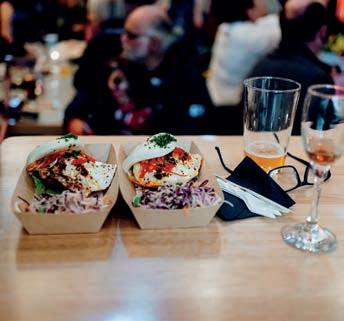
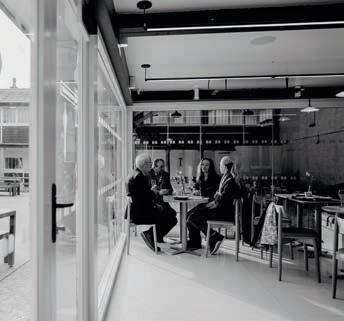
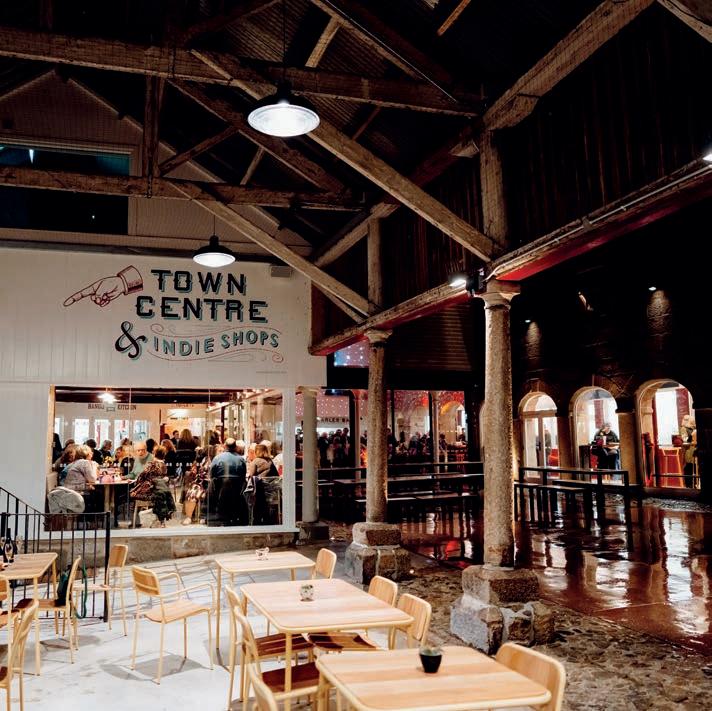


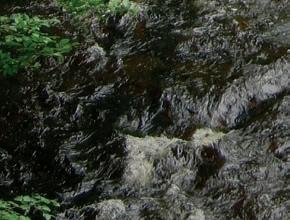






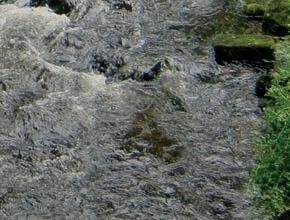
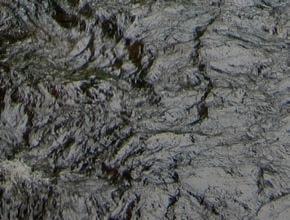
WORDS BY JAMIE CROCKER





Spawned by the appeal of wild swimming, a new activity is set to cast its line as panegyrised in a new book, Wild Fishing.
This latest tome from Wild Things Publishing celebrates the rivers, lakes and coasts of the South West – a region where Devon’s inlets and rivers yield to Cornwall’s windswept beaches and agged cliffs and far beyond as well. The book’s prose brims with evocative imagery: trout gliding through crystalline streams, the hypnotic swirl of mackerel bait balls gently caressed by the warming pulse of the Gulf Stream – inviting exploration. Its allure is undeniable, one that a rms the value and integrity of these valuable natural assets.
The very notion of wild resists definition. Can a river, lake, or coastline –already shaped by millennia of human activity – truly be wild? The South West’s waters are steeped in history, from the nets of ancient fishing villages to contemporary conservation projects. However, what Wild Fishing offers is a purer engagement, an intimate and romantic rediscovery of waters and ecosystems that are vestiges of a bygone age. It is also full of little nuggets of amusing supplementary information –“Victorian ladies used Crooklets Beach for bathing while the gentlemen were segregated to ummerlea e. he best time to fish is two hours before low water and on the incoming tide. ypically for s ate and flatfish. ou should also be able to pick up bass at night.”
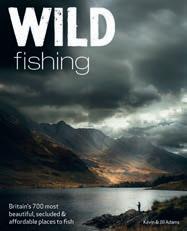
It is no surprise the landscape’s literary past also comes into play in this publication. Poets like Ted Hughes immortalised the rivers of Dartmoor in verses that sought understanding without alteration. Hughes wrote with a reverence born out of understanding, embodying a harmony that seems elusive in the modern world, for even recreational fishing, benign as it may appear, carries a toll. Discarded lures linger like splinters in the landscape monofilament lines become entanglements for unsuspecting creatures, and the subtle disruptions of human presence ripple through sensitive environments. But by re-engaging mindfully and exercising restraint aligned with a sense of awareness, our impact can be mollified. t’s a worthy ideal that ripples through the pages of Wild Fishing, presenting a chance to resurrect that harmony that the poets of the past understood. If we are to engage with the wild, let it be with the reverence of guardians, not the entitlement of explorers. In that commitment lies the true celebration of nature – one that is celebrated and extolled in Wild Fishing
Wild Fishing (Wild Things Publishing, £18.99, paperback) is published on 1st April.
wildthingspublishing.com/product/ wild-fishing-britain/

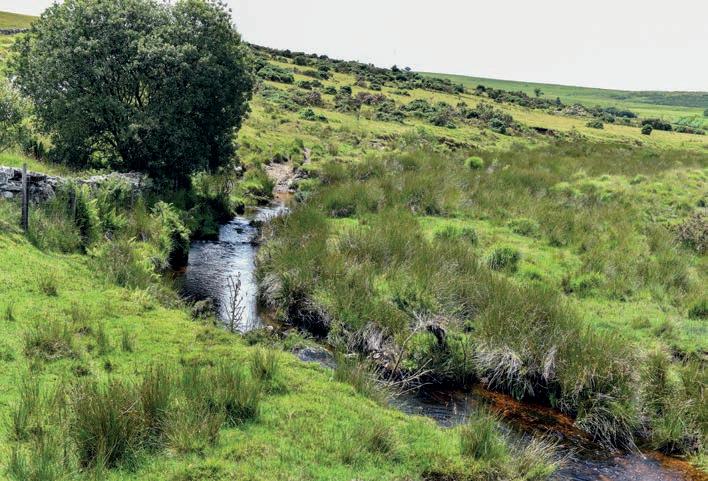
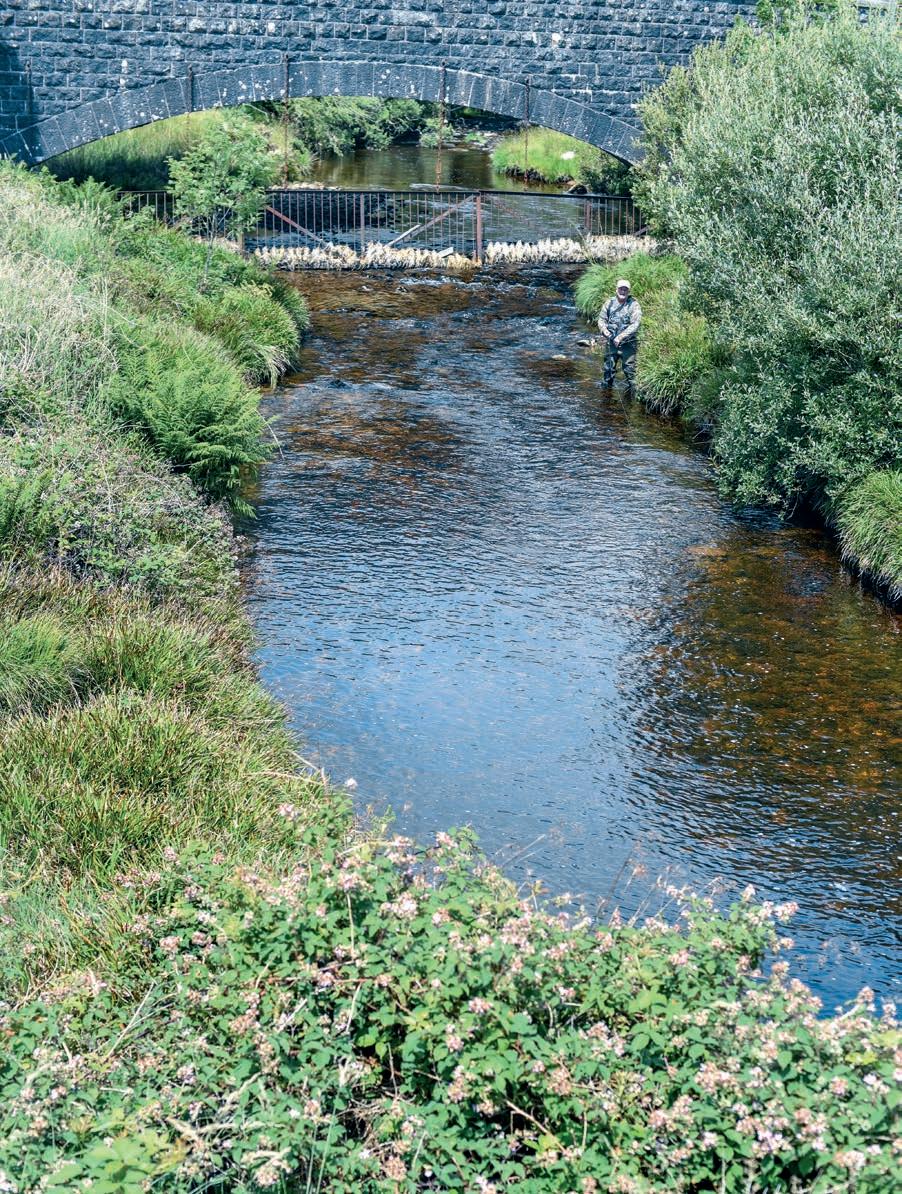




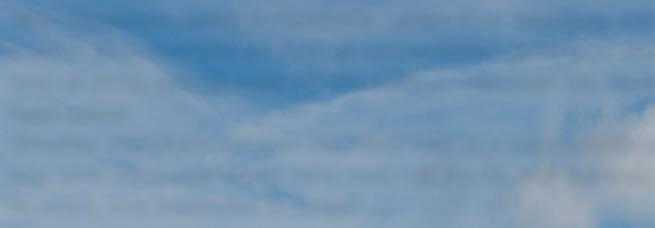















With departure points in Penzance, Land’s End, Newquay, and Exeter—plus seamless air and rail connections—getting to the Isles of Scilly, just 28 miles off the coast of Cornwall, has never been easier.
Residents of Cornwall travel from just £25
SKYBUS | Land’s End Airport
Return flights operating Mon-Sat from 08:15 - 17:55 in peak season.
SCILLONIAN III | Penzance
Operating Mon-Sat from Penzance (and Sundays in peak season), departing at 09:15 and returning at 16:30, with 06:45 outward and 17:15 return on double sailing days.
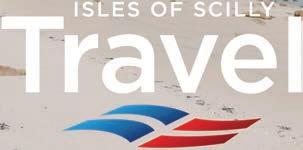

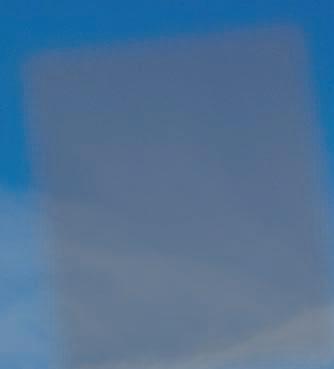


Whether you’re planning an extended stay or a memorable day trip, your adventure starts here. Visit the islands that are easy to reach, and impossibe to forget...







































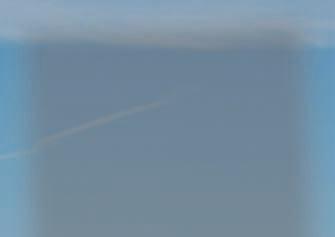

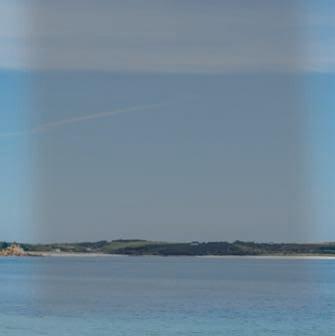






















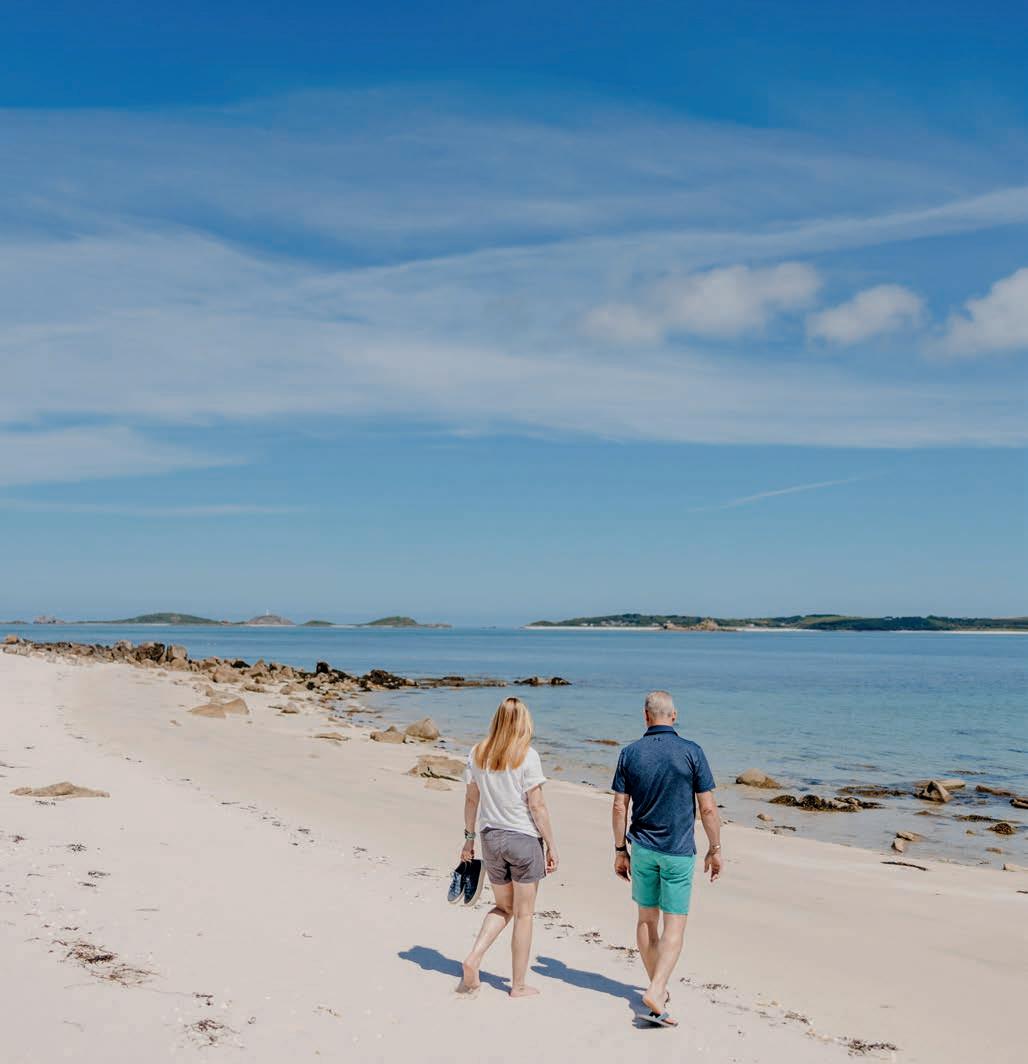
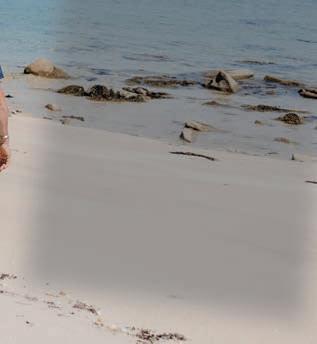

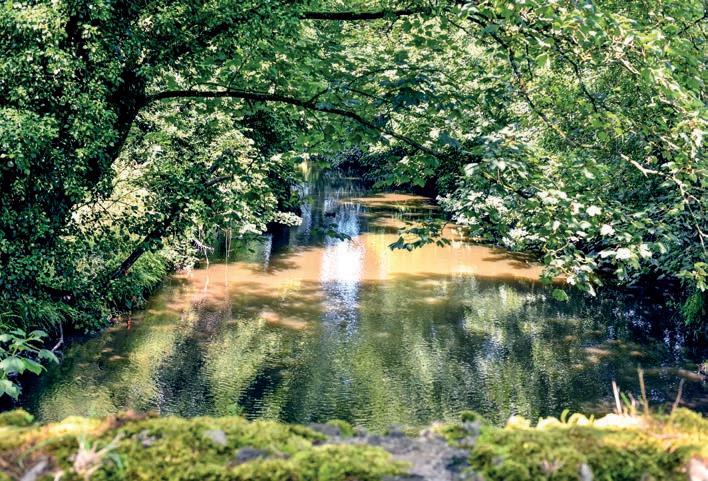
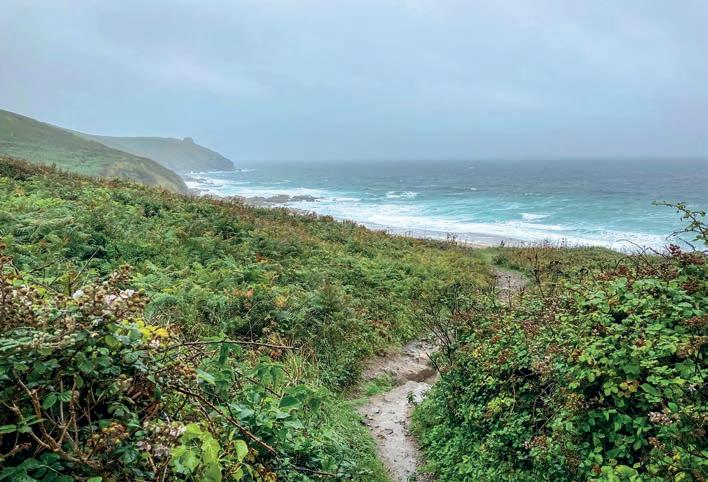
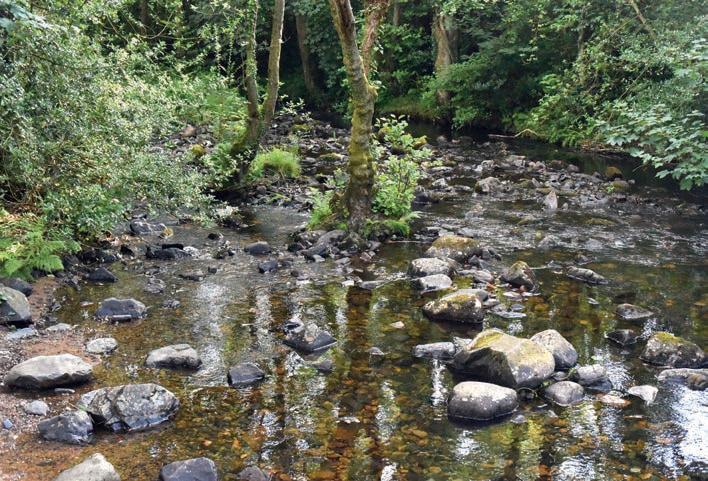
ABOVE
aw iver tic lepath evon n the local pub, the regulars tal about catching small brown trout
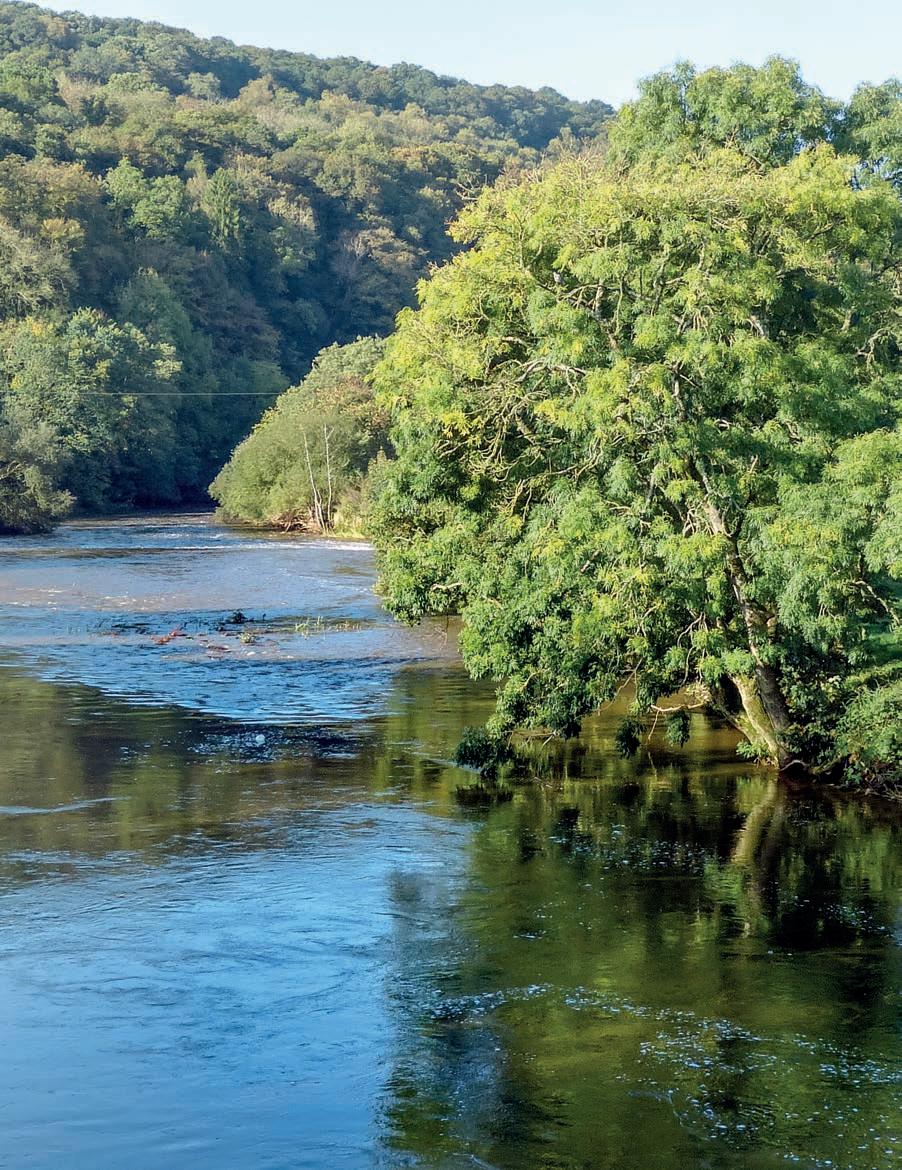
ABOVE orridge iver at otham ridge he beat offers the chance of an early salmon or a sea trout





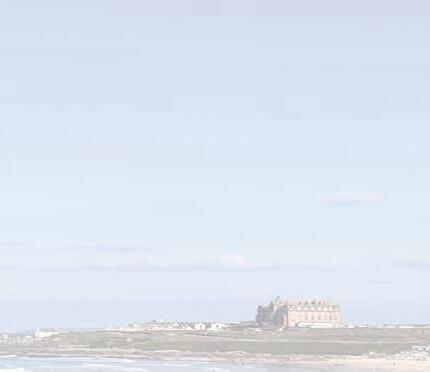
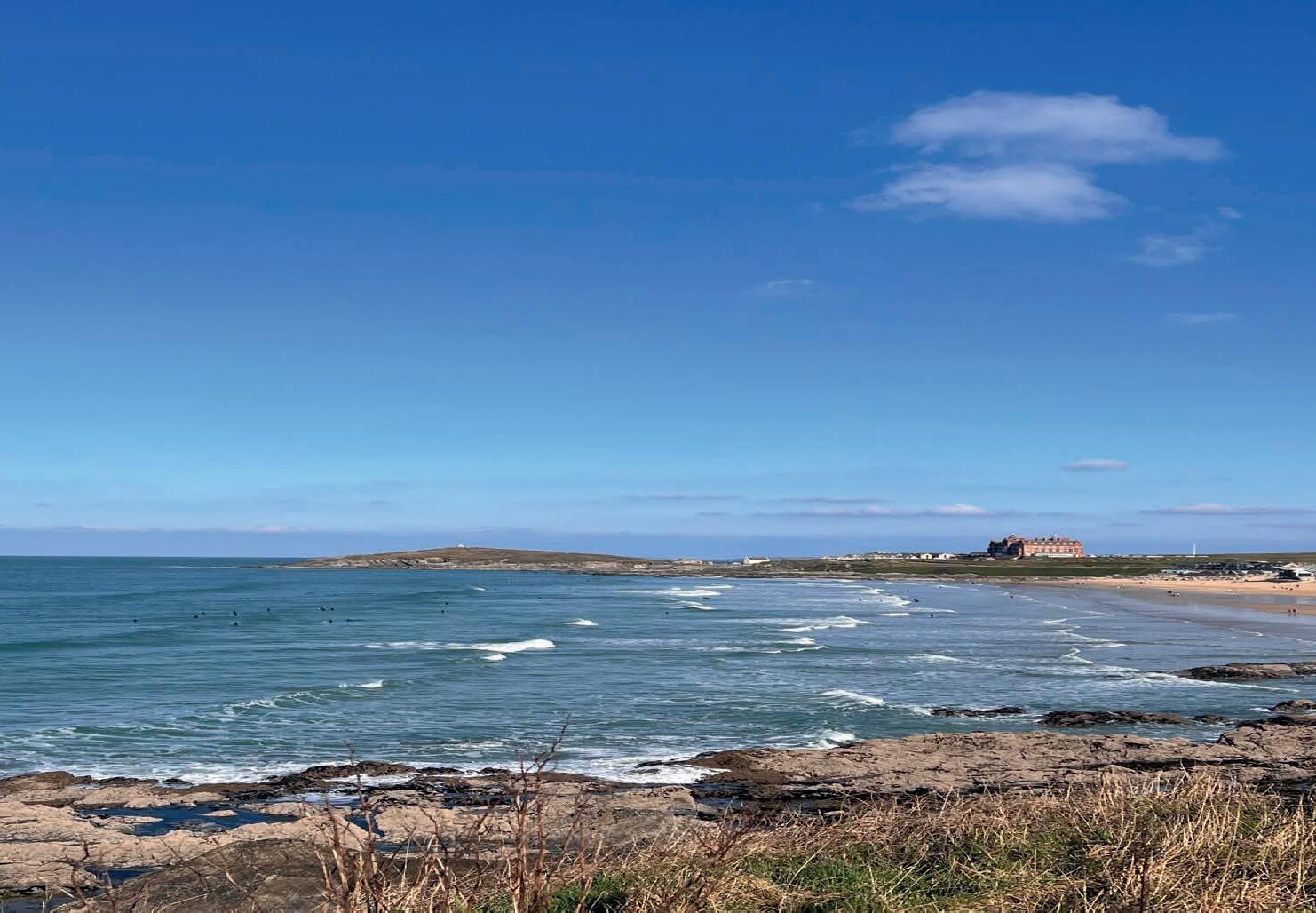


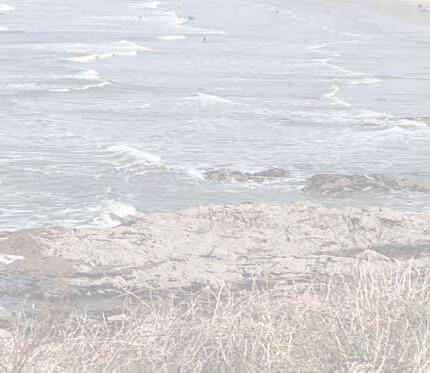
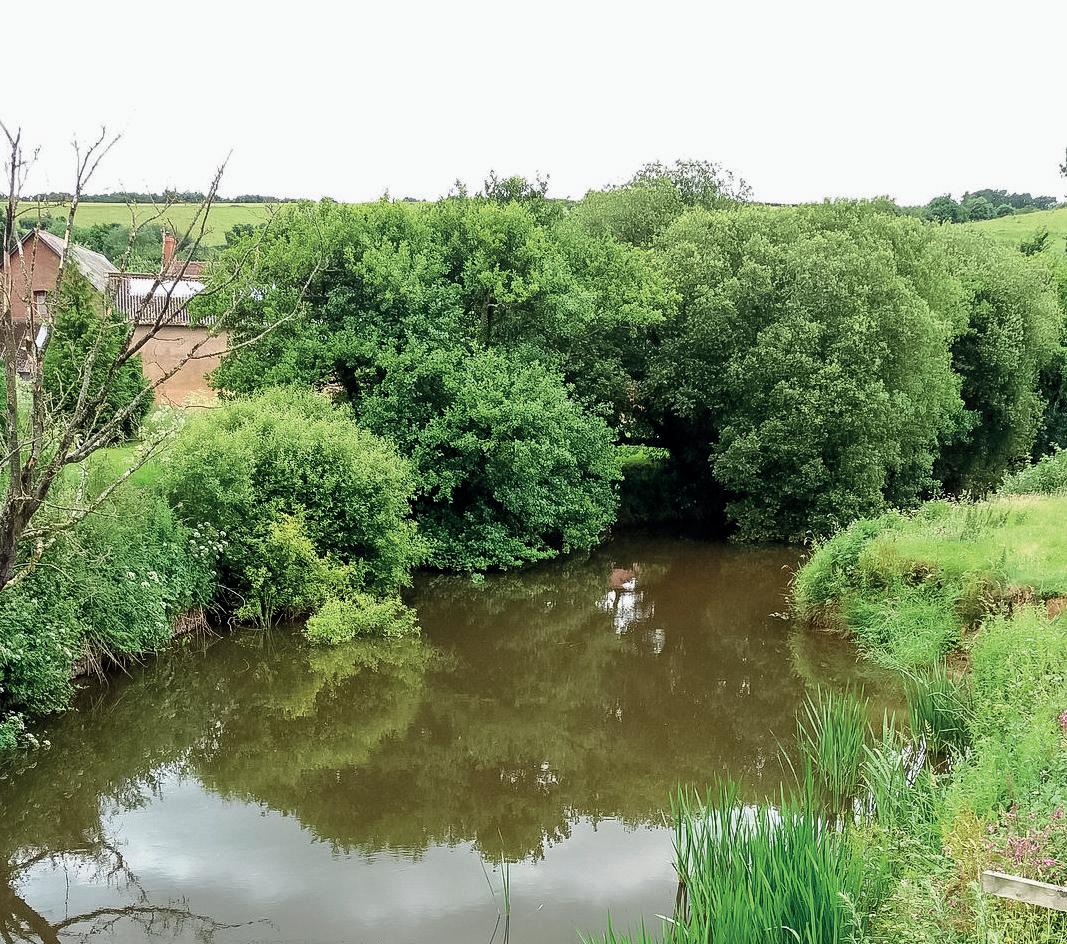
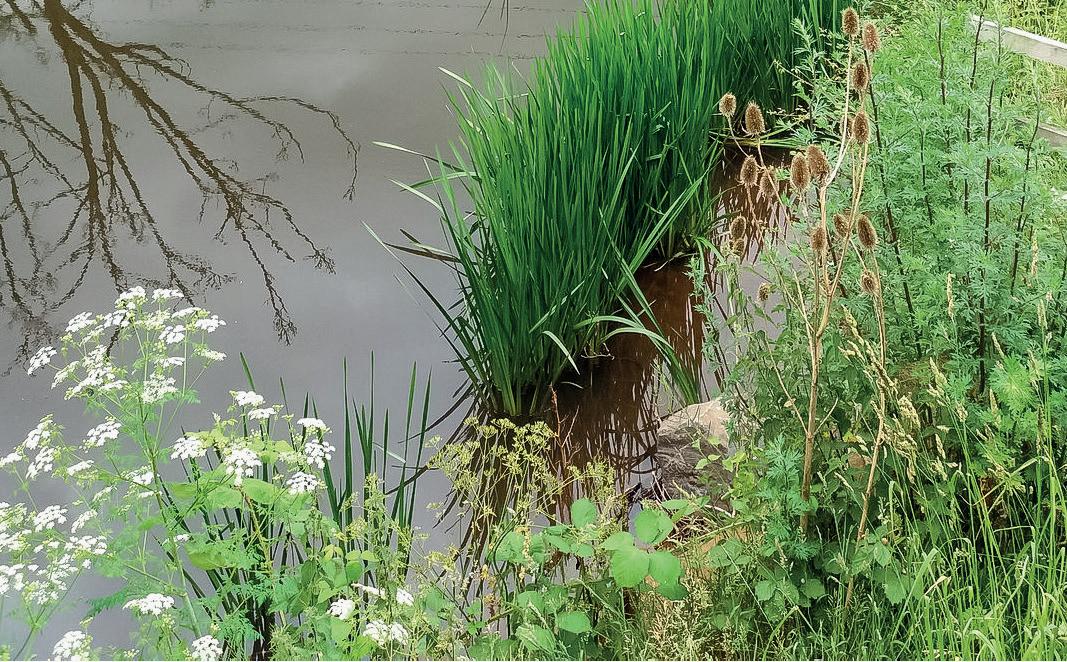
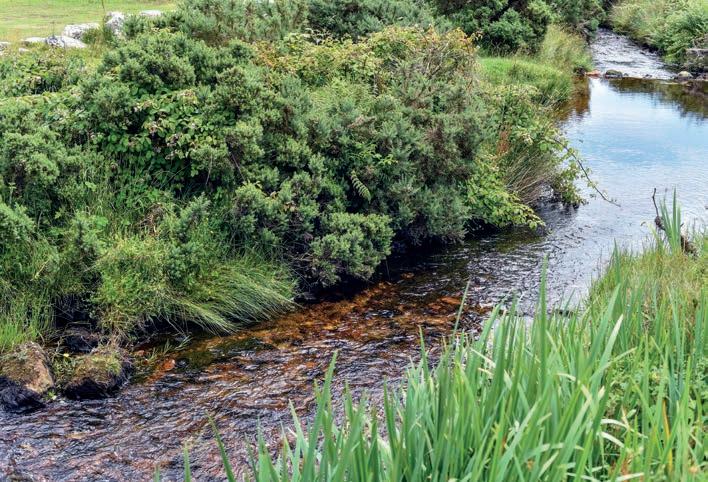
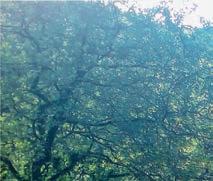

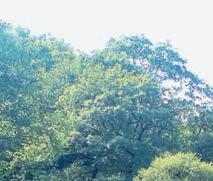
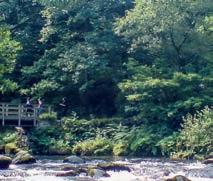


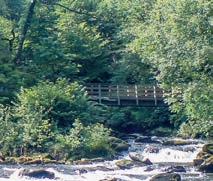
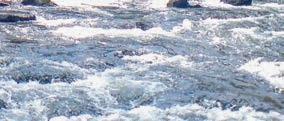

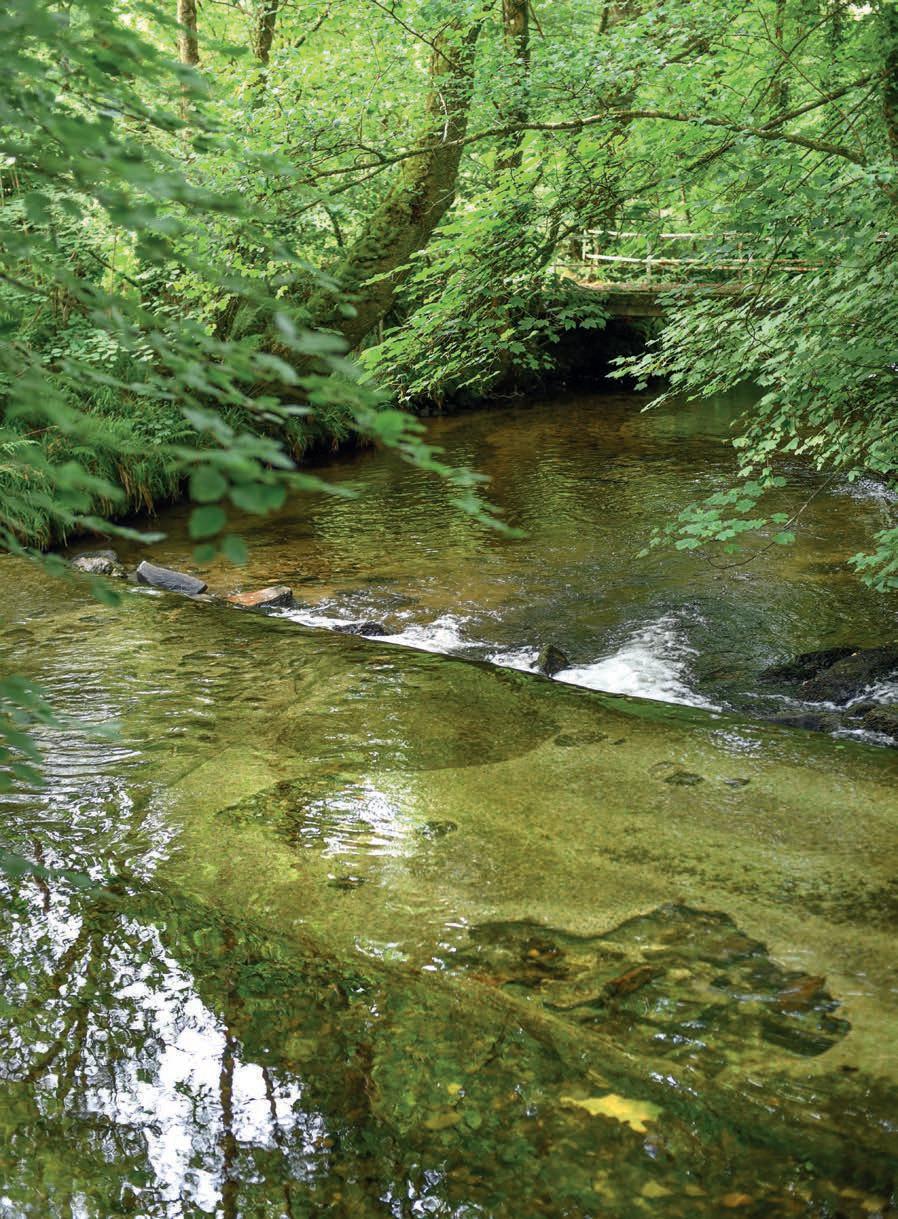
Could you extend far beyond your comfort zone to discover your true self?
The Clipper Round the World Yacht Race is one of the world’s definitive tests for those yearning to transcend the ordinary and embrace the extraordinary. Founded by ir obin nox- ohnston, the first person to sail solo non-stop around the globe, this race offers a uni ue opportunity for individuals from all walks of life to embark on a 40,000-nauticalmile circumnavigation aboard a -foot ocean racing yacht.
n ebruary , the Clipper ace team visited Fowey, Cornwall, bringing with them one of their formidable yachts. his event allowed locals to step aboard, grasp the helm, and envisage the exhilarating life of an ocean racer. Chris Harris, Recruitment Director and former Race Crew member, shared insights into the race’s demands and rewards, igniting the adventurous spirit of many attendees.

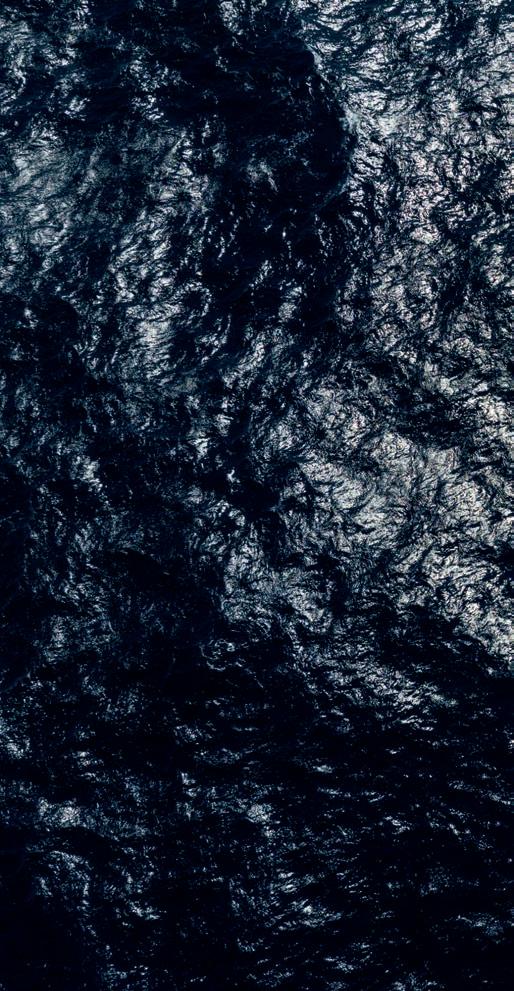
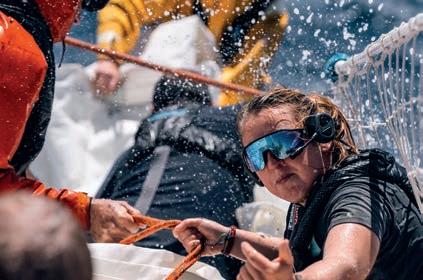
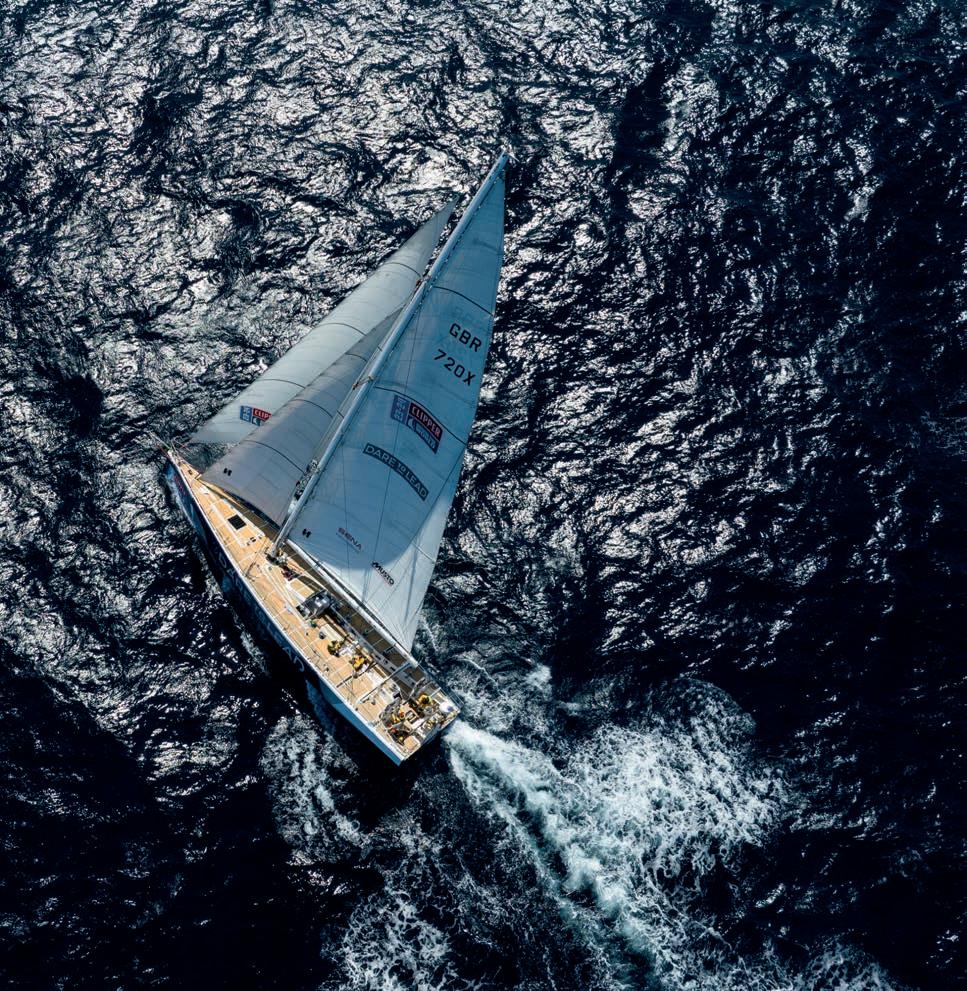
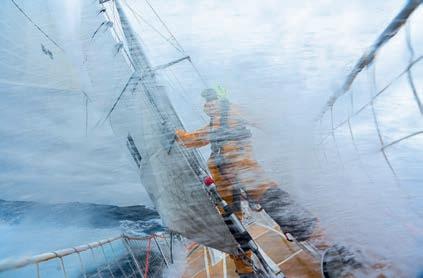
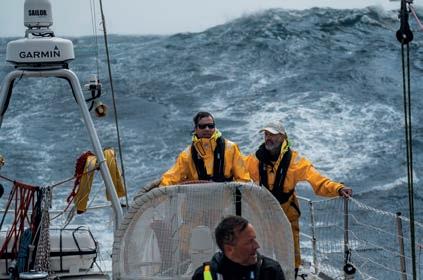

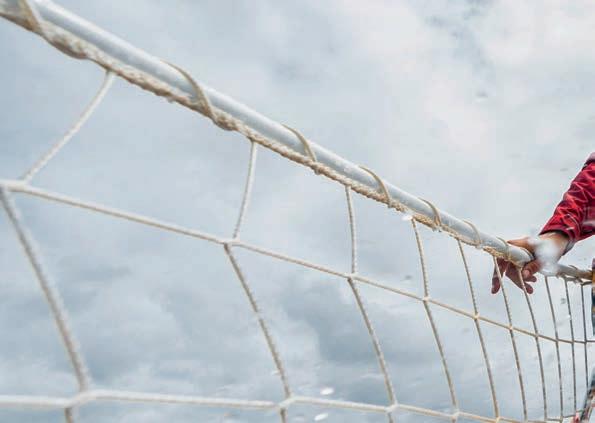

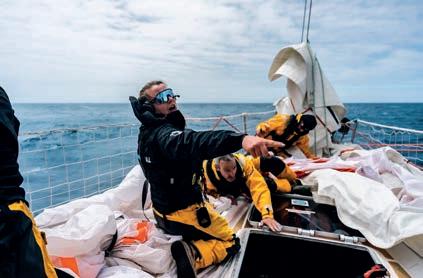
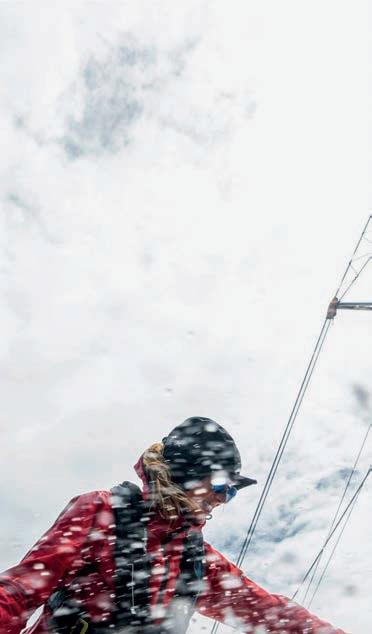
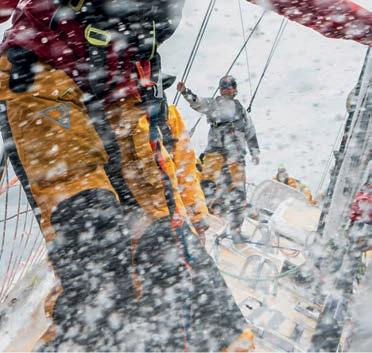
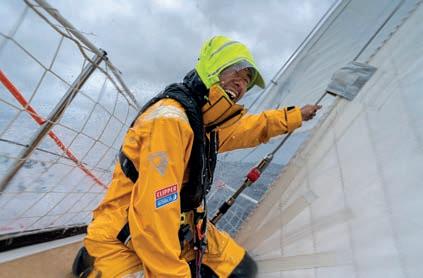
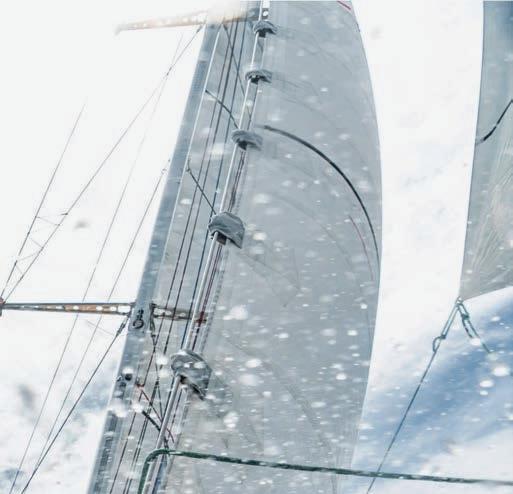


As the late summer 2025 start of the Clipper 2025-26 Race approaches, the call for new crew members intensifies. emar ably, no prior sailing experience is re uired the race provides intensive training to prepare participants for the challenges ahead. ivided into eight legs and encompassing up to individual races, the ourney includes six ocean crossings, testing endurance and resilience against nature’s fiercest elements.
Ella Nieper, a participant in the 2023-24 edition, reflected on her transformative experience tepping on board before signing up gives you a clear idea of what the race will be like... Seeing the boat for the first time gave me the confidence to think, I can do this.”
or those who missed the owey event, the door to adventure remains open. he Clipper ace continues to welcome aspiring sailors to oin future editions. y visiting the o cial website, potential crew members can access information on upcoming events, training schedules and the application process. In today’s cosseted world, this is the opportunity to embar upon a ourney of selfdiscovery, one that will push you beyond perceived limits whilst forging connections that will last a lifetime. t could be ust what you’re loo ing for
clipperroundtheworld.com

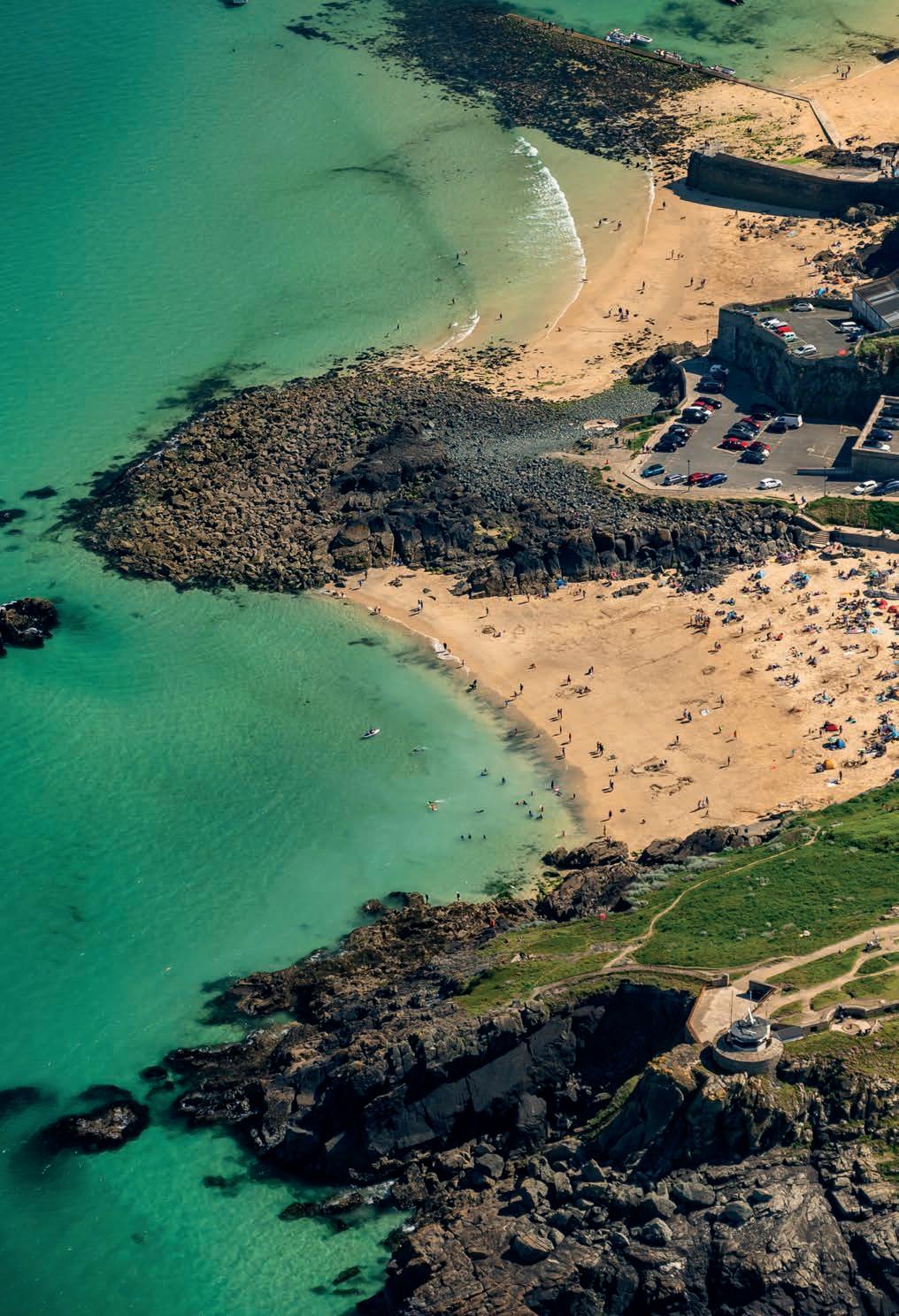
In an age of hyper-connectivity, where the world is mapped down to the inch, getting lost might seem like an anachronism.
Yet, for all our GPS sophistication, vast swathes of the British landscape remain di cult to navigate – especially in Cornwall and Devon, where winding coastal paths, moorland expanses and remote coves confound even the most diligent traveller. Enter what3words: a system so deceptively simple yet staggeringly effective that it is uietly revolutionising the way we find places, give directions and summon help in an emergency.
What3words was founded by schoolboy friends Chris Sheldrick and Mohan Ganesalingam with an elegantly practical solution to a universal problem. Chris, who practised his craft as both musician and organiser within the music industry, grew frustrated with unreliable addresses and the inevitable chaos of getting artists and e uipment to the right locations.
He recounts, “I even had a group of musicians turn up at the wrong wedding once!”

The epiphany? The world needed a more precise way of defining places. Chris approached Mohan, a mathematician, with his idea. The two friends sat down and sketched out the mathematics on a napkin: to create an addressing system precise enough to pinpoint a specific entrance or parking spot, they needed accuracy down to a -metre s uare. his would re uire trillion addresses to cover the world. Their solution of using three words would allow for 64 trillion combinations (40,000 x 40,000 x 40,000) – more than enough to cover the entire planet with some to spare. The result: a system that divides the planet into a grid of m x m s uares, each assigned a uni ue three-word identifier.
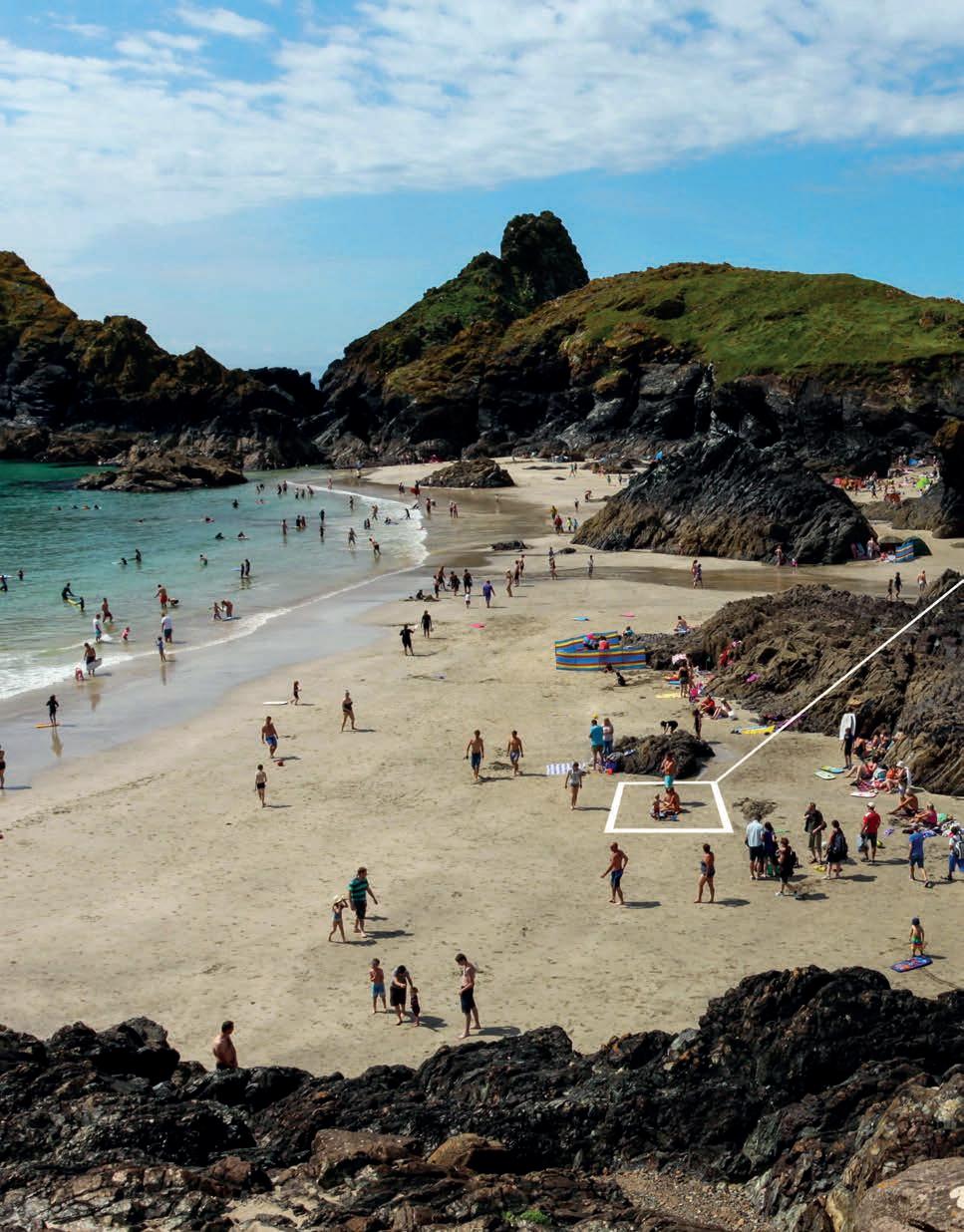
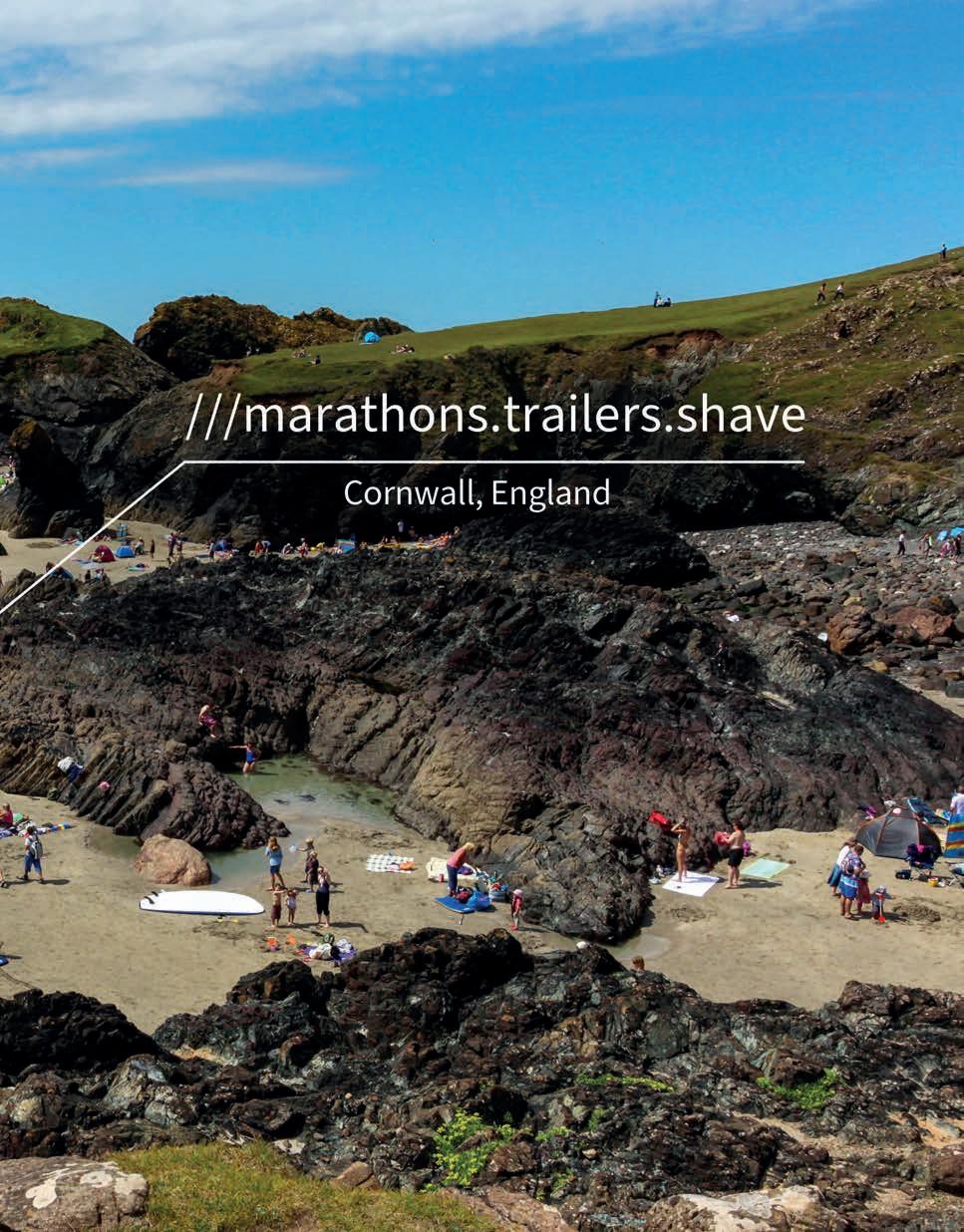
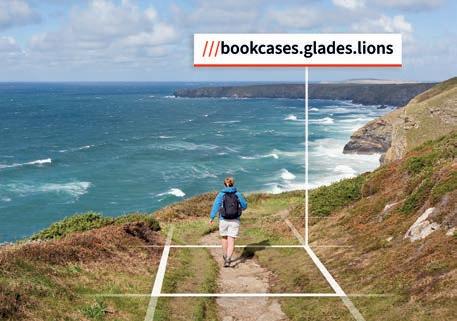

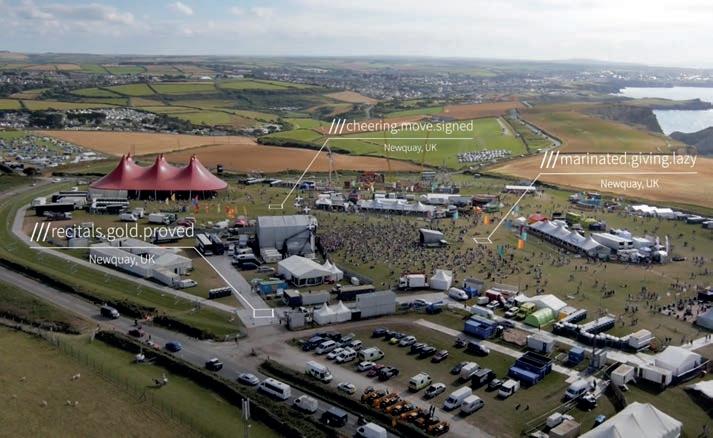

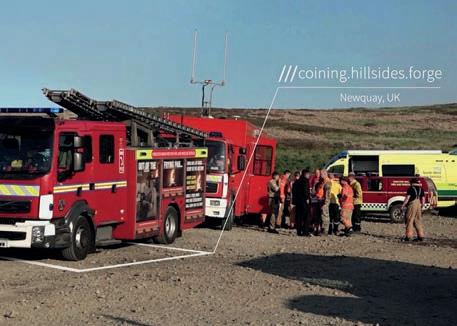
ABOVE From coastal path navigation to events and emergency call outs, what3words comes into its own
The brilliance of what3words lies in its simplicity. While Mohan’s mathematical expertise helped create the sophisticated algorithm underlying the system, the user experience is refreshingly straightforward. Download the free app, and suddenly, you can identify any location on Earth with three ordinary words.
Unlike postcode systems, which can be imprecise, or GPS coordinates, which are unwieldy, what3words provides a user-friendly alternative. A remote Cornish beach might be pinpointed as ‘rank.tabs. blaze’, a hidden moorland tor as ‘blush. encourage.numeral’. The beauty of the system lies in its simplicity and accessibility no special e uipment is needed, ust a smartphone, or smartwatch or a map with the corresponding words.
The South West’s labyrinthine lanes, rugged cliffs, and expansive moors ma e it a perfect testing ground for the real-world utility of what3words. In cities, it ensures pinpoint accuracy in food deliveries and taxi pickups, but in Cornwall and Devon, it takes on a more elemental role: guiding hikers across Bodmin Moor or Dartmoor, helping wild swimmers reach secluded coves, and enabling rural businesses to be found without the ambiguity of an unmarked lane.
It has also become a vital tool in tourism. Hotels and restaurants, keen to ensure guests find them effortlessly, now include what3words locations in their booking confirmations. utdoor adventure companies use it to direct visitors to surf spots, kayak launch points, and climbing crags. It is, in essence, the modern compass for the free-roaming explorer.
Beyond convenience, what3words has had profound implications for emergency services. By its very nature, Cornwall and Devon’s isolated moorland and South est Coast ath can uic ly turn from the pictures ue to the perilous. ach year, the Cornwall Air Ambulance, the Devon Air Ambulance, RNLI and Coastguard respond to hundreds of calls from walkers, swimmers, and boaters in distress. In the past, pinpointing an exact location could take critical minutes – especially when a caller is panicked or unfamiliar with their surroundings. ow, a uic relay of three words to a 999 operator can mean the difference between a swift rescue and a desperate search.
For the South West’s emergency services, this technology has become an invaluable tool. Take the case of George Bladon, whose day of hiking on Dartmoor took a frightening turn when he fell into a deep
gully near Great Links Tor. With multiple open fractures and in a precarious position, the precision of his location was crucial. Thanks to what3words, which his group had fortuitously downloaded ust the day before, Devon Air Ambulance was able to locate him swiftly and transport him to erriford a or rauma Centre.
r consider ara la ebroo ’s story, which unfolded during a training walk for a charity event. When she experienced a severe thunderclap headache in a remote location, what3words proved crucial in guiding emergency services to her precise location. The land was inaccessible to standard ambulances, but thanks to the exact coordinates provided by the app, Devon Air Ambulance could land nearby and transport her swiftly to the hospital.
he system’s effectiveness lies in its careful design. Each three-word combination is uni ue, and similar combinations are deliberately placed far apart to minimise errors. he technology wor s o ine once downloaded, crucial in areas of poor connectivity – a common challenge in Devon and Cornwall’s more remote locations.
For delivery companies like Yodel, DPD, and DHL, who navigate this region’s complex network of rural addresses daily, what3words has transformed their operations. No longer must drivers rely on
vague directions or postcodes that cover vast rural areas. Each delivery point can be identified with pinpoint accuracy.
The impact of what3words extends far beyond our shores, too. The system works in over 60 languages, including Welsh, making it invaluable for international visitors to the region. a or automotive manufacturers, including Jaguar Land Rover and Lotus, have integrated the technology into their navigation systems, recognising its value in precisely locating destinations.
Slowly but surely, what3words is beginning to embed itself into the fabric of the South West’s outdoor culture, and its reach is expanding. Estate agents use it to pinpoint property viewings. Wedding venues ensure guests arrive at the right barn, not one half a mile away. Even local councils are adopting it for public safety signage.
In a region where precise location can be a matter of life and death, what3words has become more than ust a clever innovation – it’s an essential tool for anyone exploring or living in the southwest. Whether you’re walking the coastal paths, tramping the moors, or simply trying to find that secluded beach, three simple words might be all you need to find your way.
what3words.com
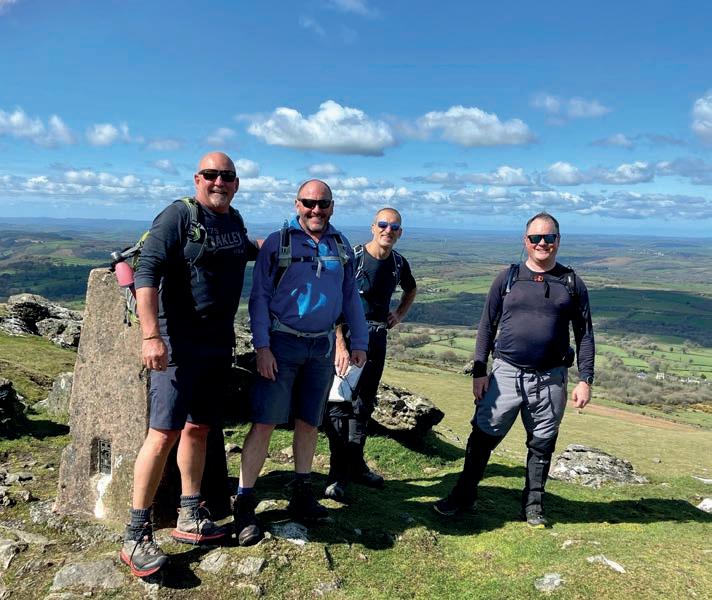


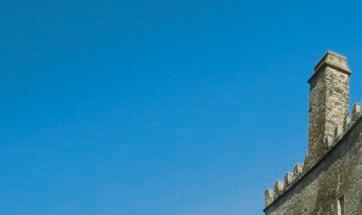
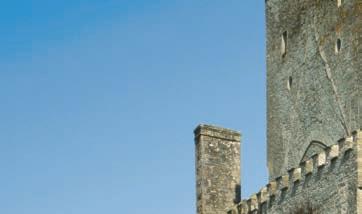


WORDS BY JAMIE CROCKER

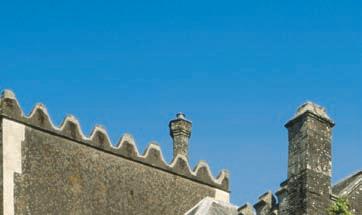


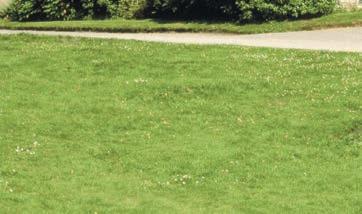


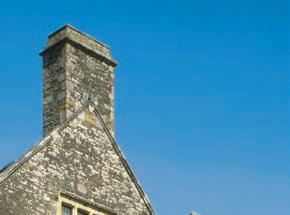
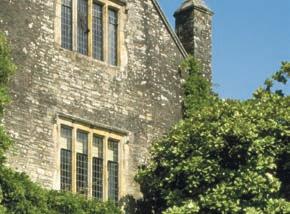
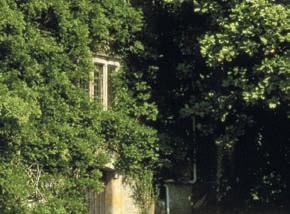
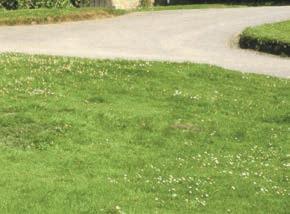

Eight centuries of history unfold within the walls of Buckland Abbey, a house of faith, power and adventure.
The road towards Buckland Abbey twists through the Devon countryside, past high hedgerows and sloping fields, until it gives way to a landscape that feels as though it has barely changed since the days of Cistercian monks and Tudor seafarers. As I approach, the house looms ahead, a structure that has shifted and adapted through time, absorbing the ambitions of those who have claimed it as their own. The past is embedded in its stones, and with each step, I feel the weight of history pressing in.

Standing before the entrance, I picture the abbey as it once was, its uiet halls filled with the murmured prayers of monks. Founded in 1278, Buckland Abbey was the last Cistercian monastery built in medieval England
PREVIOUS
and Wales. For more than 250 years, monks farmed the vast estate, their lives dedicated to austerity, prayer and manual labour. The Dissolution of the Monasteries shattered that tranquillity, and the medieval walls were reshaped into a grand house. The hand of Sir Richard Grenville, the man who made it a home, is still evident in the Tudor embellishments that replaced the solemn austerity of its ecclesiastical past. But it is another name – more famous, more formidable – that dominates the Abbey’s legacy: Sir Francis Drake.
It would be remiss of me not to break my e ploration and offer some more on this fascinating character from English history. Sir Francis Drake strides through history as both hero and scourge, his legacy forever caught between
admiration and accusation. To England, he was a master mariner, a man who encircled the globe and held the Spanish Armada at bay. To Spain, he was El Draque – the dragon – a ruthless privateer whose raids burned their ports and plundered their treasure fleets.
Born into relative obscurity in Tavistock, Drake’s rise was propelled by ambition and an unrelenting will. He cut his teeth on the lawless waters of the Caribbean, where piracy and patriotism blurred. His circumnavigation of the world, completed in 1580, cemented his reputation, filling ueen li abeth s coffers and earning him a knighthood. But it was in 1588, during the battle against the Armada, that his name was truly forged into legend. As enemy sails darkened the hori on, he played bowls on Plymouth Hoe, unru ed, before leading his fire ships into the fray and scattering the panish fleet.
But back to my walk of discovery. Inside, the air is cool, thick with the scent of oak and stone. I move towards the Great Hall, where the remnants of its churchly origins merge with the confident flourishes of the li abethan age. he stone floor beneath my feet has been trodden by men who shaped the course of history, and the Tudor panelling bears the marks of an age of expansion, of daring voyages across uncharted seas. It is here that I begin to understand Buckland Abbey’s true nature – not just a place of residence, but a vessel for the ambitions of those who have called it home.

Yet, away from the high seas and the theatre of war, Drake’s later years were spent in quiet authority here at Buckland Abbey, which he transformed into his estate.
e died, fittingly, at sea in , felled not by battle but by dysentery. Buried in full armour off anama s coast, his grave, like his life, remains elusive – lost to the sea he once commanded.
Onward through the nave, find the ym urals, a bold and evocative depiction of Drake’s exploits, stretching across the walls like a tapestry of conquest. The Golden Hind rides the waves, a pri e ship is sei ed, the rmada scatters before English cannons. These murals, painted centuries after the events they depict, speak to the enduring grip Drake holds on the imagination. But there is another treasure here, quieter yet no less commanding – a Rembrandt self-portrait, its ga e both penetrating and enigmatic, a reminder of the house’s evolution beyond its maritime past.
A narrow passage leads me deeper into the Abbey. The kitchen, still marked by its Tudor origins, feels as though it could spring to life at any moment, filled with the crackle of the hearth and the bustle of
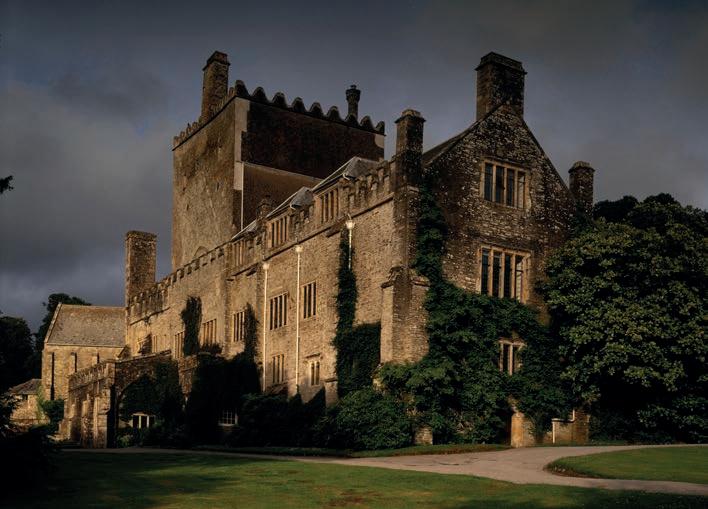

ABOVE Rembrandt’s self-portait on display at
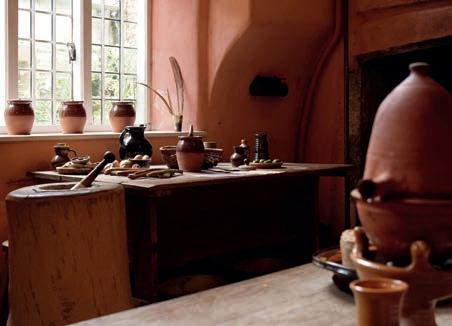



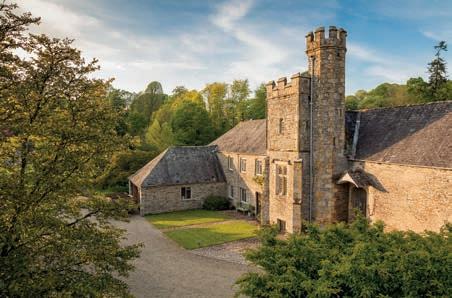
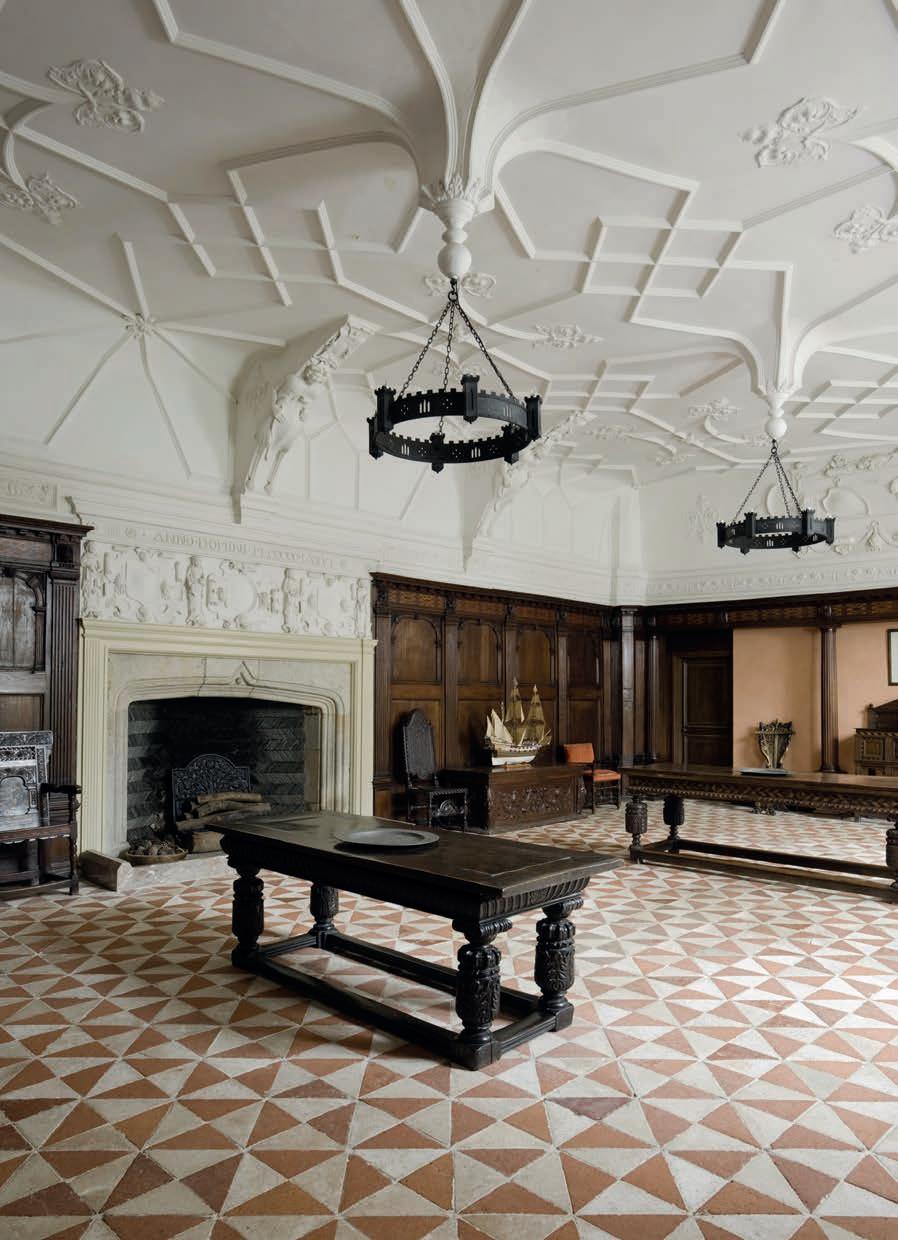
preparation. Volunteers occasionally cook here, reviving centuries-old techniques, filling the space with the ghostly echoes of past meals and feasts.
Beyond the kitchen lies the chapel, a place of quiet reverence. Discovered in 1917 by Lady Drake during renovations, it holds the site of the high altar, where monks once gathered in worship. The stillness here is profound, a contrast to the energy of the rest of the Abbey. It is a space where time seems suspended, where the past lingers more keenly than anywhere else within these walls.
Climbing the staircase, I enter the Lifetimes Gallery, dedicated to Drake’s world and the tumultuous era he navigated. Here, maps unfurl routes taken by his ships, letters recount victories and controversies, and objects recovered from voyages tell of distant lands and uncertain seas. A silver chest, believed to have belonged to Drake himself, sits among these relics – a reminder that wealth and renown were often gained at great cost.
past. imagine the fields stretching out, the orchards heavy with fruit, a time when this estate was not only a home but the heart of a working farm.
Fire nearly undid centuries of history in when flames tore through the bbey, consuming much of the upper floors. t took years of careful restoration, supported by Plymouth City Council and the National Trust, to return the building to what we see today. he scars of that fire remain, hidden within the beams and walls, reminders of how close this place came to vanishing altogether.

Through every archway and passage, Buckland Abbey reveals itself in layers – a place of devotion turned into a stronghold of power, a house rebuilt from fire and neglect, a relic of the past that refuses to fade. Each stone holds the ambitions of those who shaped it, from humble monks to men of fortune. As I walk away, I glance once more at the walls, their surface bearing the marks of centuries.
I step outside, drawn towards the Great arn, a feat of medieval craftsmanship that has stood unwavering through the centuries. Built by the Cistercian monks to store wool, fleece, cattle hides and crops, the barn is a testament to their industriousness. Within its cavernous interior, once used by monks for winnowing corn, a cider press stands as a nod to the Abbey’s agricultural
And before I leave, I head to the Ox Yard café for tea and to contemplate what I’d seen and read about. This is no mere museum. It is a living testament to the tides of history, and as I leave, I feel the inescapable pull of its story, urging me to return.
nationaltrust.org.uk/visit/devon/ buckland-abbey
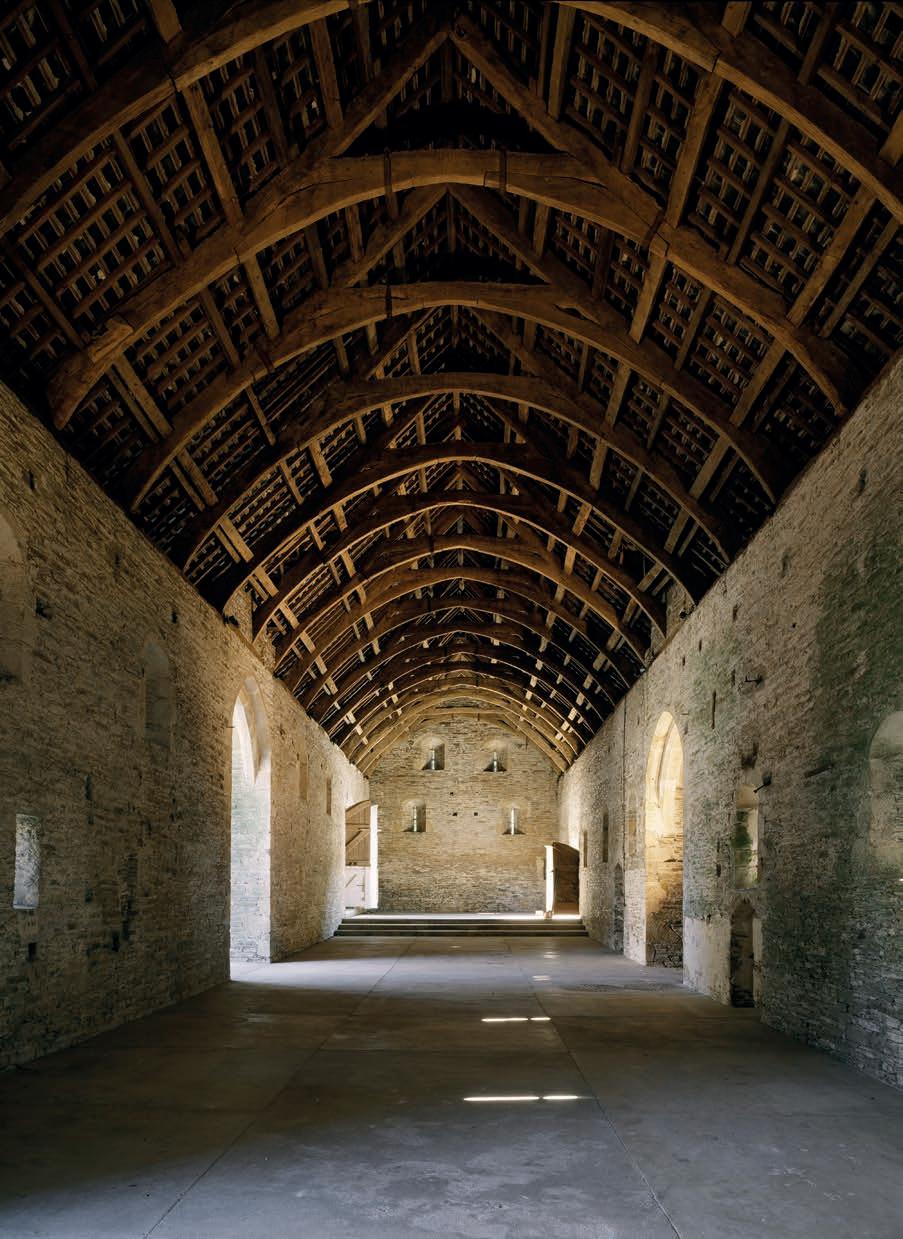
WORDS BY GREG ALLEN
Iam delighted to have joined Devon Air Ambulance Trust (DAAT) and the fantastic team of staff and volunteers. I have been a Devon resident for 20 years and we raised our three children here. hey have all fled the nest now (one lives and works in South Korea!) but my passion for our county and community remains as strong as ever.
I’ve been fortunate to have worked in a wide variety of sectors, across the UK and internationally over the last years or so.
saved by DAAT in recent years and I am forever grateful for that. new that if this job came up, I would want to go for it!
At the heart of everything for me, though, are people. love wor ing with all inds of different people and helping to lead, guide, and support them to be the best they can be.

I am motivated by the prospect of leading a much-loved and successful organisation, with great foundations, into the future and discovering things that we don’t yet know are possible, to help us deliver better outcomes for our patients. ervice and social impact are at the heart of who I am and what I like doing, and embodies those values.
Our organisation has a great reputation across our community and beyond evon. Our county and community mean a great deal to me – this is my home, and I care about the emergency and critical care services and capacity that we have. Three of my friends have had their lives
As a CEO, you need to maintain a good balance between external and internal focus. en oy engaging with people across teams and organisations and my style is to do that through whichever means help increase visibility and impact.
The economic and environmental context is ever-changing and the demand for our services is increasing. here is a need for me, and other leaders at DAAT, to keep abreast of threats and opportunities and to keep building good relationships with potential partners and looking for ways we can collaborate and innovate. aintaining an adaptable approach is therefore important, whilst staying true to our organisational vision and mission.
daat.org
Devon Air Ambulance’s new CEO, Greg Allen





















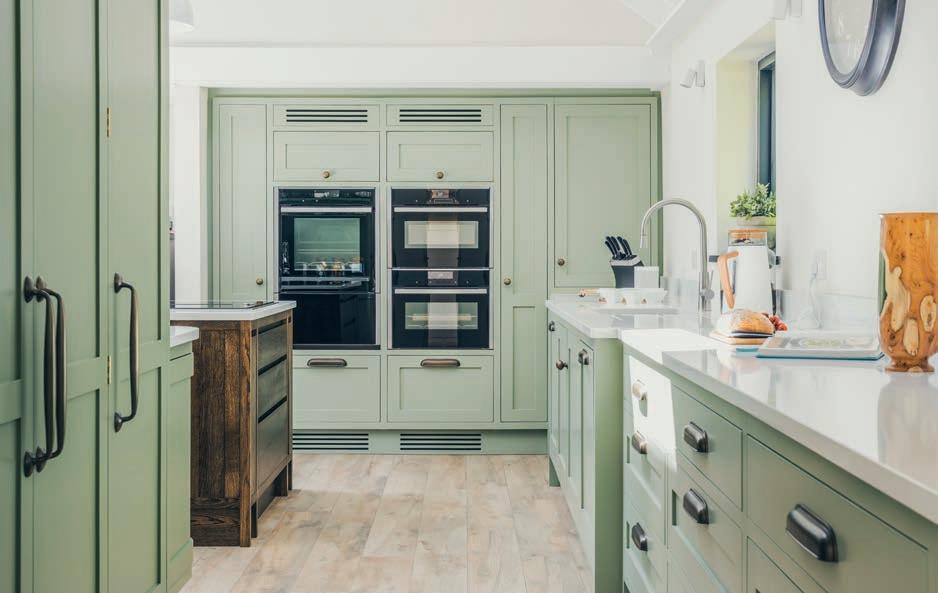



Bespoke furniture and luxury interiors handmade in Cornwall – from unique, one-off designs to entire room transformations to tailored joinery packages.
Harnessing 35 years of experience, Rozen’s highly skilled team of crafters are dedicated to the finest standards. Making everything from freestanding kitchen units to bespoke dining tables to beautiful bedroom furniture and more, our craftsmen pour precision, care and artistry into every job. B E S P O K E F U R N I T U R E M A K E R S


